User manual
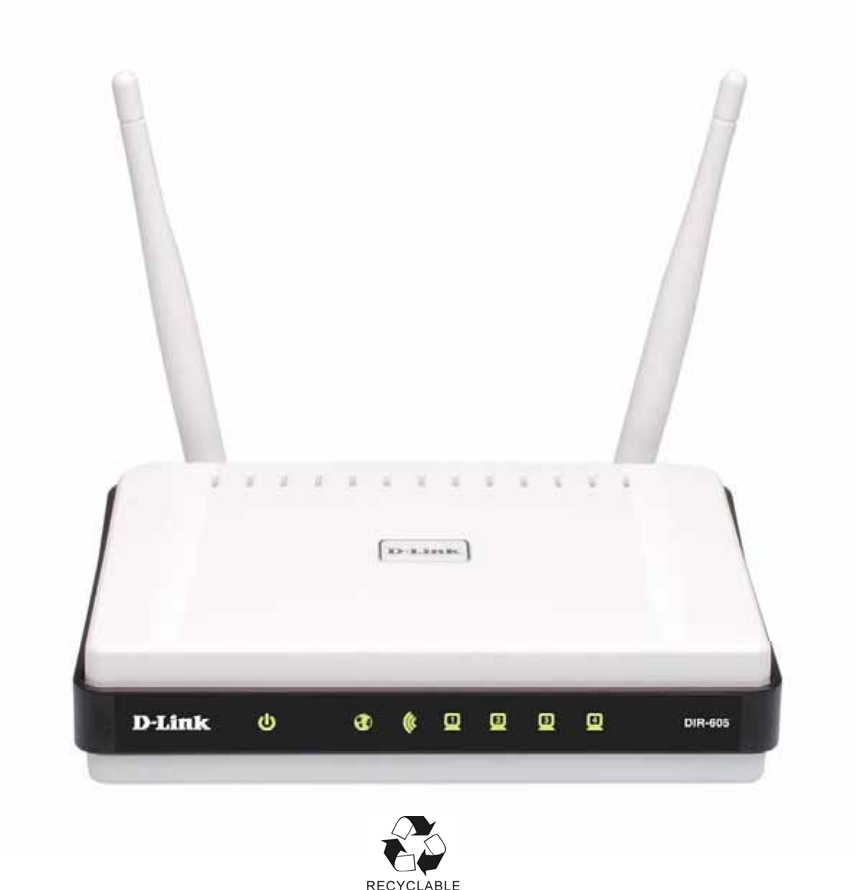
D-Link DIR-605
Wireless N Router
中文快速安裝/設定指南
無線寬頻路由器
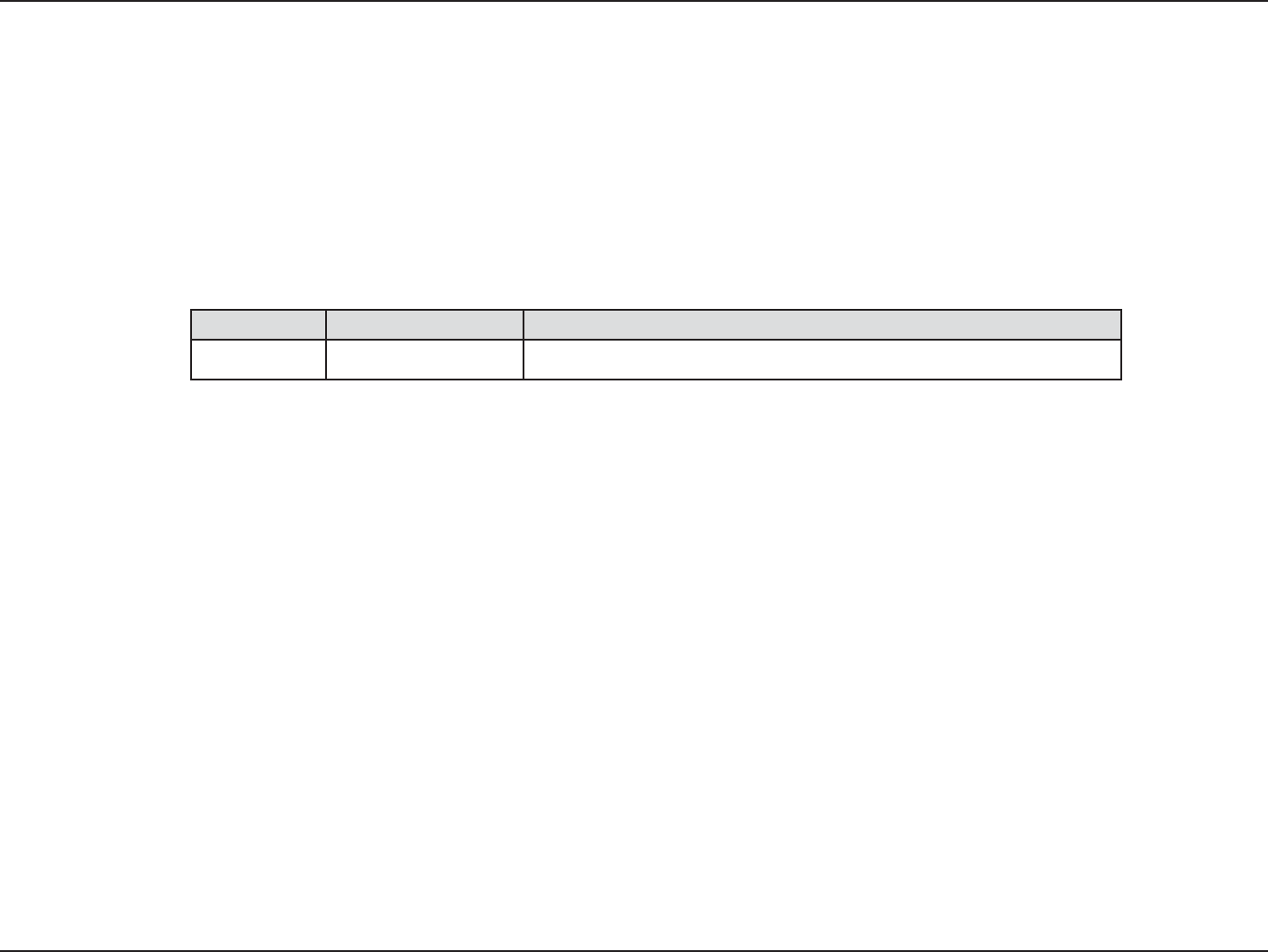
i
D-Link DIR-605 User Manual
D-Link reserves the right to revise this publication and to make changes in the content hereof without obligation to
notify any person or organization of such revisions or changes.
Manual Revisions
Trademarks
D-Link and the D-Link logo are trademarks or registered trademarks of D-Link Corporation or its subsidiaries in the
United States or other countries. All other company or product names mentioned herein are trademarks or registered
trademarks of their respective companies.
Copyright © 2009 by D-Link Systems, Inc.
All rights reserved. This publication may not be reproduced, in whole or in part, without prior expressed written permission
from D-Link Systems, Inc.
Revision Date Description
1.0 July 31, 2008 t6QEBUFEGPSSFWJTJPO
Preface

ii
D-Link DIR-605 User Manual
Table of Contents
Preface....................................................................................................... i
Manual Revisions........................................................................... i
Trademarks ...................................................................................... i
Product Overview ................................................................................ 1
Package Contents......................................................................... 1
System Requirements................................................................. 2
Features............................................................................................ 3
Hardware Overview..................................................................... 4
Connections ........................................................................... 4
LEDs ........................................................................................... 5
Installation .............................................................................................. 6
Before you Begin...........................................................................6
Wireless Installation Considerations...................................... 7
Network Diagram ......................................................................... 8
Connect to Cable/DSL/Satellite Modem.............................. 9
Connect to Another Router ....................................................10
Getting Started............................................................................12
Conguration.......................................................................................13
Web-based Conguration Utility..........................................13
Internet Connection Setup Wizard...............................14
Manual Conguration.......................................................19
Dynamic (Cable).............................................................19
Dynamic IP Address (DHCP).......................................20
PPPoE (DSL)......................................................................21
PPTP....................................................................................22
L2TP ....................................................................................24
Static IP Address.............................................................26
Wireless Settings.................................................................27
Manual Wireless Network Setup ..............................28
Network Settings ................................................................30
DHCP Server Settings...................................................31
DHCP Reservation .........................................................32
Virtual Server........................................................................34
Port Forwarding ..................................................................36
Application Rules................................................................37
QoS Engine............................................................................38
Network Filters.....................................................................39
Access Control .....................................................................40
Access Control Wizard..................................................40
Website Filters......................................................................43
Inbound Filters.....................................................................44
Firewall Settings..................................................................45
Advanced Wireless Settings............................................46
Advanced Network Settings...........................................47
UPnP ...................................................................................47
Internet Ping Block........................................................47
Internet Port Speed.......................................................47
Multicast Streams ..........................................................47
IPv6 ..........................................................................................48
Link-Local Connectivity ...............................................49
Static IPv6 (Stateful)......................................................50
Static IPv6 (Stateless)....................................................51
Table of Contents

iii
D-Link DIR-605 User Manual
Table of Contents
DHCPv6 (Stateful) ..........................................................52
DHCPv6 (Stateless)........................................................53
IPv6 over PPPoE (Stateful)...........................................54
IPv6 over PPPoE (Stateless) ........................................56
6 to 4 Tunneling (Stateful) ..........................................58
6 to 4 Tunneling (Stateless) ........................................59
IPv6 in IPv4 Tunneling (Stateful)...............................60
IPv6 in IPv4 Tunneling (Stateless).............................61
Administrator Settings......................................................62
Time Settings .......................................................................63
SysLog.....................................................................................64
E-mail Settings.....................................................................65
System Settings...................................................................66
Update Firmware ................................................................67
DDNS.......................................................................................68
System Check.......................................................................69
Schedules ..............................................................................70
Device Information ............................................................71
Log ...........................................................................................73
Stats.........................................................................................74
Internet Sessions.................................................................75
Wireless ..................................................................................77
Support ..................................................................................78
Wireless Security.................................................................................79
What is WPA?................................................................................79
Wireless Connection Setup Wizard ......................................80
Add Wireless Device with WPS Wizard................................83
Congure WPA-Personal (PSK)...............................................84
Congure WPA-Enterprise (RADIUS)....................................85
Connect to a Wireless Network .....................................................87
Using Windows Vista®................................................................87
Congure WPA/WPA2........................................................88
Connect Using WCN 2.0 ...................................................90
Using Windows® XP ....................................................................91
Congure WPA-PSK............................................................92
Troubleshooting .................................................................................94
Wireless Basics.....................................................................................98
What is Wireless?.........................................................................99
Tips................................................................................................ 101
Wireless Modes......................................................................... 102
Networking Basics........................................................................... 103
Check your IP address............................................................ 103
Statically Assign an IP address............................................ 104
Technical Specications................................................................ 105
Warranty ............................................................................................. 106
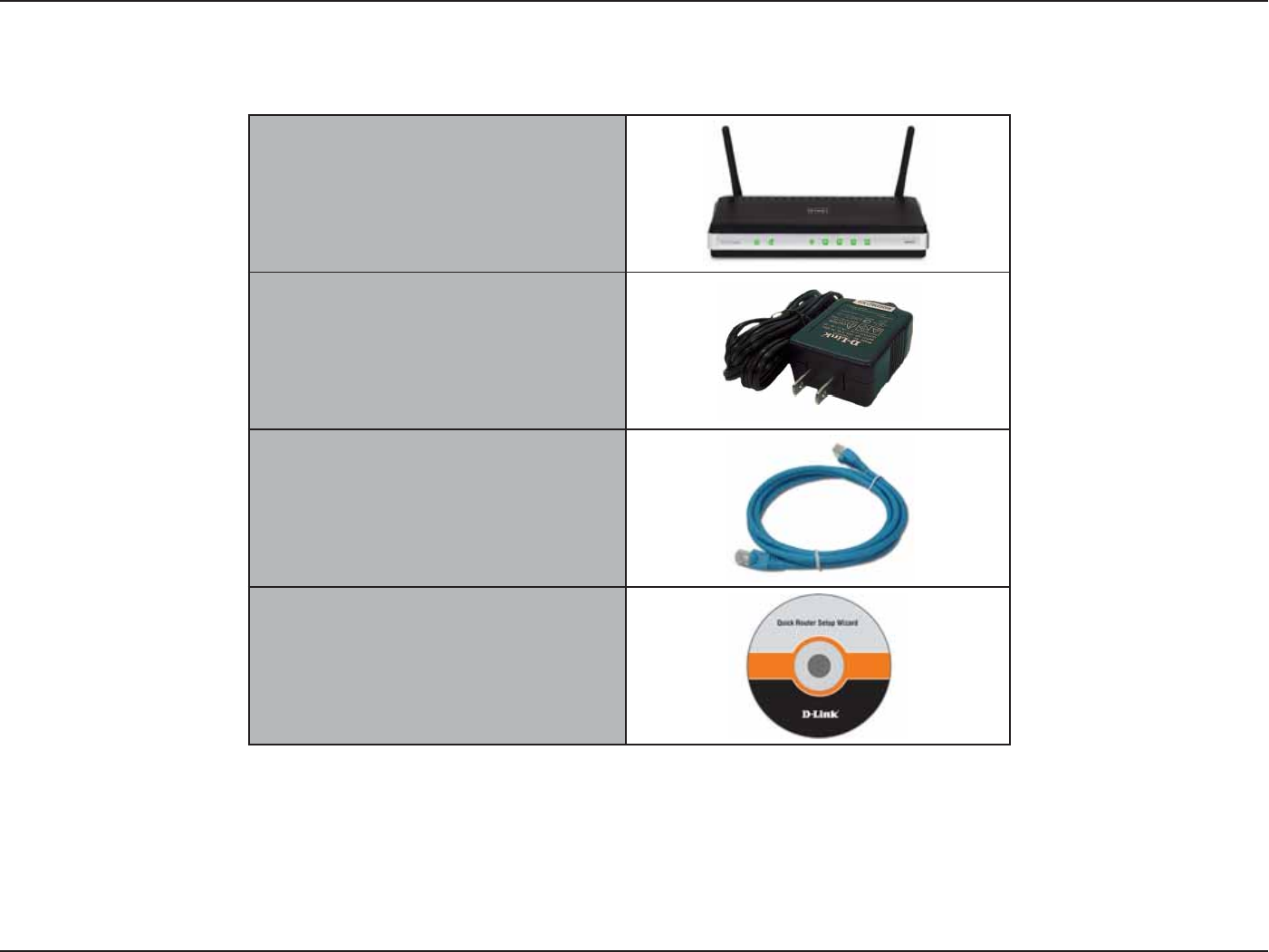
1
D-Link DIR-605 User Manual
Section 1 - Product Overview
Product Overview
Note: Using a power supply with a dierent voltage rating than the one included with the DIR-605 will cause damage and void the warranty for this product.
Package Contents
D-Link DIR-605 Wireless N Router
Power Adapter
Ethernet Cable
CD-ROM

2
D-Link DIR-605 User Manual
Section 1 - Product Overview
Network Requirements
t"O&UIFSOFUCBTFE$BCMFPS%4-NPEFN
t*&&&OESBGUHXJSFMFTTDMJFOUT
t&UIFSOFU
Web-based Conguration
Utility Requirements
Computer with the following:
t8JOEPXT®, Macintosh, or Linux-based operating
system
t"OJOTUBMMFE&UIFSOFUBEBQUFS
Browser Requirements:
t*OUFSOFU&YQMPSFSPSIJHIFS
t.P[JMMBPSIJHIFS
t'JSFGPYPSIJHIFS
t4BGBSJPSIJHIFSXJUI+BWBPSIJHIFS
t'MPDLPSIJHIFS
t0QFSBPSIJHIFS
Windows® Users: Make sure you have the latest version
of Java installed. Visit www.java.com to download the
latest version.
CD Installation Wizard
Requirements
Computer with the following:
t8JOEPXT® XP with Service Pack 2 or Vista®
t"OJOTUBMMFE&UIFSOFUBEBQUFS
t$%30.ESJWF
System Requirements

3
D-Link DIR-605 User Manual
Section 1 - Product Overview
t'BTUFS8JSFMFTT/FUXPSLJOH - The DIR-605 provides up to 300Mbps* wireless connection with other 802.11n
wireless clients. This capability allows users to participate in real-time activities online, such as video streaming,
online gaming, and real-time audio.
t$PNQBUJCMFXJUIH%FWJDFT - The DIR-605 is still fully compatible with the IEEE 802.11g standard, so it can
connect with existing 802.11g PCI, USB and Cardbus adapters.
t"EWBODFE'JSFXBMM'FBUVSFT - The Web-based user interface displays a number of advanced network
management features including:
tContent Filtering - Easily applied content filtering based on MAC Address, URL, and/or
Domain Name.
tFilter Scheduling - These filters can be scheduled to be active on certain days or for a
duration of hours or minutes.
tSecure Multiple/Concurrent Sessions - The DIR-605 can pass through VPN sessions. It supports
multiple and concurrent IPSec and PPTP sessions, so users behind the DIR-605 can securely access
corporate networks.
t6TFSGSJFOEMZ4FUVQ8J[BSE - Through its easy-to-use Web-based user interface, the DIR-605 lets you control what
information is accessible to those on the wireless network, whether from the Internet or from your company’s
server. Congure your router to your specic settings within minutes.
* Maximum wireless signal rate derived from IEEE Standard 802.11g and Draft 802.11n specifications. Actual data throughput will vary. Network conditions and
environmental factors, including volume of network trac, building materials and construction, and network overhead, lower actual data throughput rate. Environmental
conditions will adversely aect wireless signal range.
Features
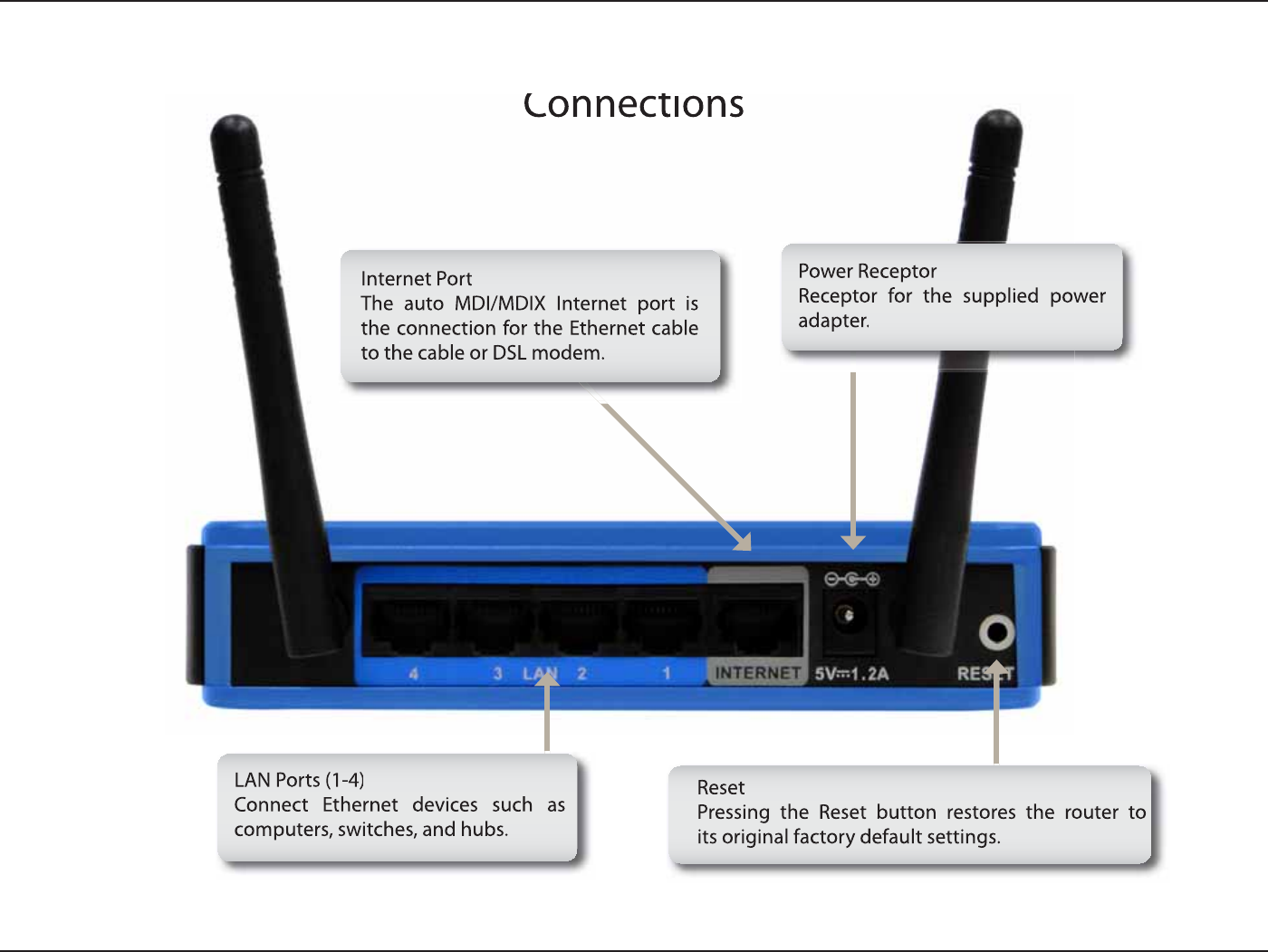
4
D-Link DIR-605 User Manua
l
Section 1 - Pro
d
uct Overvie
w
Har
d
ware Overvie
w
Cti
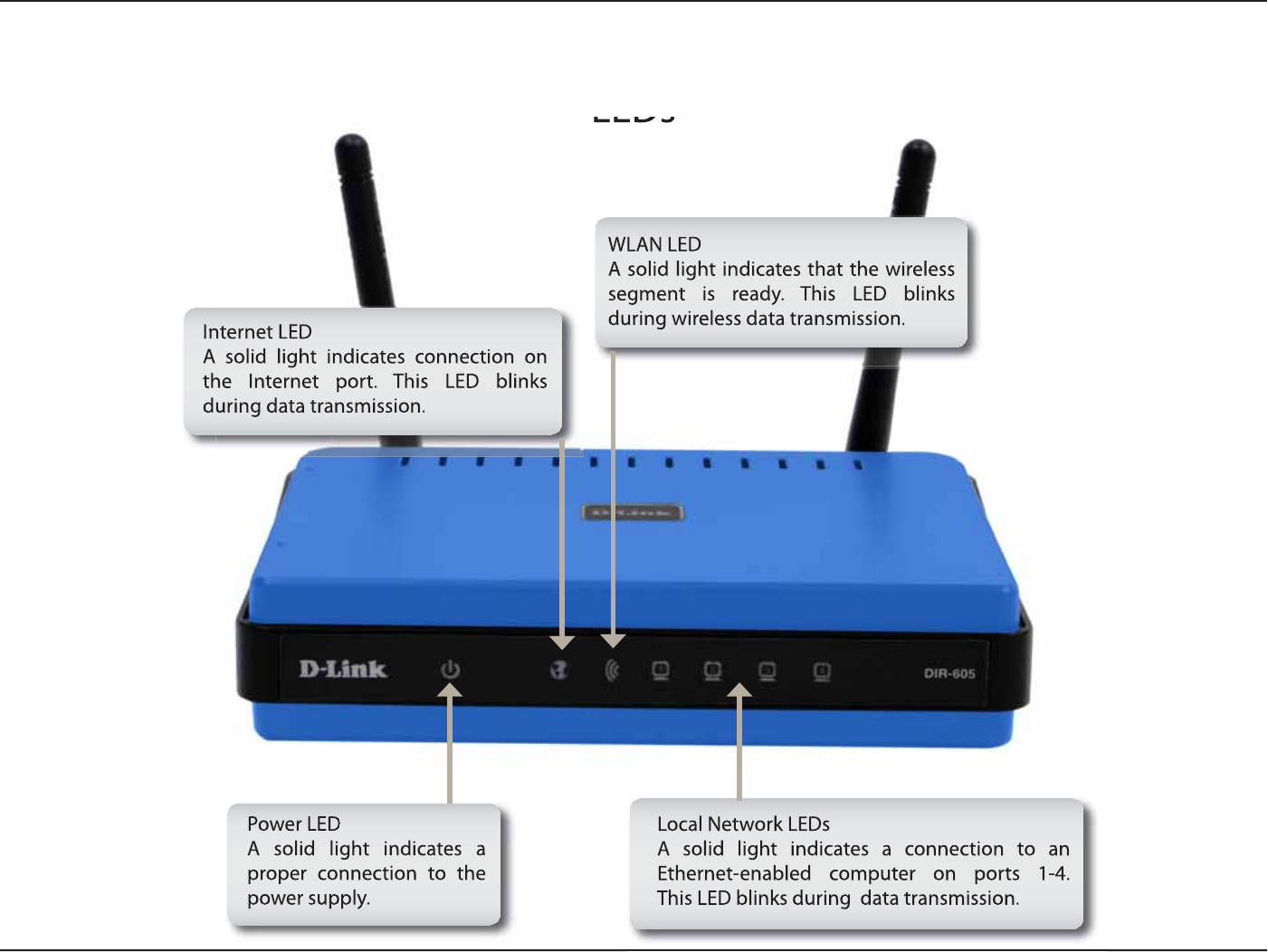
5
D-Link DIR-605 User Manua
l
Section 1 - Pro
d
uct Overvie
w
Har
d
ware Overvie
w
LEDs

6
D-Link DIR-605 User Manual
Section 2 - Installation
Before you Begin
This section will walk you through the installation process. Placement of the router is very important. Do not place the
router in an enclosed area such as a closet, cabinet, or in the attic or garage.
t 1MFBTFDPOöHVSFUIFSPVUFSXJUIUIFDPNQVUFSUIBUXBTMBTUDPOOFDUFEEJSFDUMZUPZPVSNPEFN
t :PV DBOPOMZVTF UIF&UIFSOFUQPSUPO ZPVSNPEFN*G ZPVXFSFVTJOH UIF64#DPOOFDUJPOCFGPSFVTJOH
the router, then you must turn o your modem, disconnect the USB cable and connect an Ethernet cable
to the Internet port on the router, and then turn the modem back on. In some cases, you may need to
call your ISP to change connection types (USB to Ethernet).
t *GZPVIBWF%4-BOE BSFDPOOFDUJOHWJB 111P&NBLFTVSFZPVEJTBCMFPSVOJOTUBMMBOZ111P&TPGUXBSF
such as WinPoet, Broadjump, or Enternet 300 from your computer or you will not be able to connect to
the Internet.
t 8IFOSVOOJOH UIF4FUVQ8J[BSEGSPNUIF %-JOL $%NBLFTVSFUIFDPNQVUFSZPVBSFSVOOJOHUIF$%
from is connected to the Internet and online or the wizard will not work. If you have disconnected any
hardware, re-connect your computer back to the modem and make sure you are online.
Installation

7
D-Link DIR-605 User Manual
Section 2 - Installation
Wireless Installation Considerations
The D-Link wireless router lets you access your network using a wireless connection from virtually anywhere within
the operating range of your wireless network. Keep in mind, however, that the number, thickness and location of
walls, ceilings, or other objects that the wireless signals must pass through, may limit the range. Typical ranges vary
depending on the types of materials and background RF (radio frequency) noise in your home or business. The key
to maximizing wireless range is to follow these basic guidelines:
1. Keep the number of walls and ceilings between the D-Link router and other network devices to a
minimum - each wall or ceiling can reduce your adapter’s range from 3-90 feet (1-30 meters.) Position
your devices so that the number of walls or ceilings is minimized.
2. Be aware of the direct line between network devices. A wall that is 1.5 feet thick (.5 meters), at a
45-degree angle appears to be almost 3 feet (1 meter) thick. At a 2-degree angle it looks over 42 feet
(14 meters) thick! Position devices so that the signal will travel straight through a wall or ceiling (instead
of at an angle) for better reception.
3. Building Materials make a dierence. A solid metal door or aluminum studs may have a negative eect on
range. Try to position access points, wireless routers, and computers so that the signal passes through
drywall or open doorways. Materials and objects such as glass, steel, metal, walls with insulation, water
(sh tanks), mirrors, le cabinets, brick, and concrete will degrade your wireless signal.
4. Keep your product away (at least 3-6 feet or 1-2 meters) from electrical devices or appliances that
generate RF noise.
5. If you are using 2.4GHz cordless phones or X-10 (wireless products such as ceiling fans, lights, and
home security systems), your wireless connection may degrade dramatically or drop completely. Make
sure your 2.4GHz phone base is as far away from your wireless devices as possible. The base transmits
a signal even if the phone in not in use.
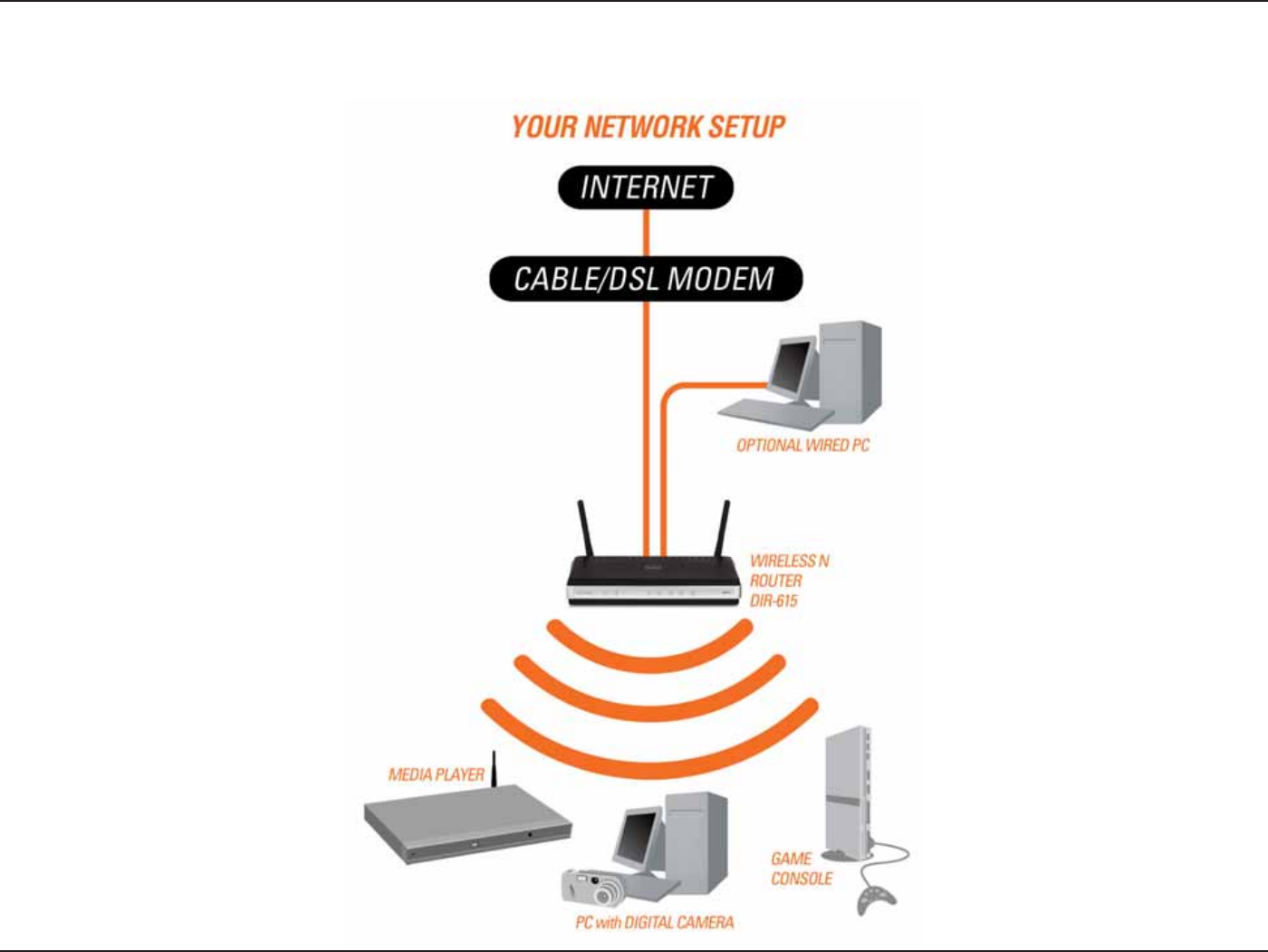
8
D-Link DIR-605 User Manual
Section 2 - Installation
Network Diagram

9
D-Link DIR-605 User Manual
Section 2 - Installation
If you are connecting the router to a cable/DSL/satellite modem, please follow the steps below:
1. Place the router in an open and central location. Do not plug the power adapter into the router.
2. Turn the power o on your modem. If there is no on/o switch, then unplug the modem’s power adapter. Shut down
your computer.
3. Unplug the Ethernet cable (that connects your computer to your modem) from your computer and place it into the
Internet port on the router.
4. Plug an Ethernet cable into one of the four LAN ports on the router. Plug the other end into the Ethernet port on
your computer.
5. Turn on or plug in your modem. Wait for the modem to boot (about 30 seconds).
6. Plug the power adapter to the router and connect to an outlet or power strip. Wait about 30 seconds for the router
to boot.
7. Turn on your computer.
8. Verify the link lights on the router. The power light, Internet light, and the LAN light (the port that your computer is
plugged into) should be lit. If not, make sure your computer, modem, and router are powered on and verify the cable
connections are correct.
9. Skip to page 13 to congure your router.
Connect to Cable/DSL/Satellite Modem

10
D-Link DIR-605 User Manual
Section 2 - Installation
If you are connecting the D-Link router to another router to use as a wireless access point and/or switch, you will have
to do the following before connecting the router to your network:
t%JTBCMF61O1™
t%JTBCMF%)$1
t$IBOHFUIF -"/*1BEESFTTUPBO BWBJMBCMFBEESFTTPOZPVSOFUXPSL5IF-"/QPSUTPOUIF SPVUFSDBOOPU
accept a DHCP address from your other router.
To connect to another router, please follow the steps below:
1. Plug the power into the router. Connect one of your computers to the router (LAN port) using an Ethernet cable.
Make sure your IP address on the computer is 192.168.0.xxx (where xxx is between 2 and 254). Please see the
Networking Basics section for more information. If you need to change the settings, write down your existing settings
before making any changes. In most cases, your computer should be set to receive an IP address automatically in
which case you will not have to do anything to your computer.
2. Open a web browser and enter http://192.168.0.1 and press Enter. When the login window appears, set the user
name to Admin and leave the password box empty. Click Log In to continue.
3. Click on Advanced and then click Advanced Network. Uncheck the Enable UPnP checkbox. Click Save Settings
to continue.
4. Click Setup and then click Network Settings. Uncheck the Enable DHCP Server server checkbox. Click Save
Settings to continue.
5. Under Router Settings, enter an available IP address and the subnet mask of your network. Click Save Settings to
save your settings. Use this new IP address to access the conguration utility of the router in the future. Close the
browser and change your computer’s IP settings back to the original values as in Step 1.
Connect to Another Router

11
D-Link DIR-605 User Manual
Section 2 - Installation
6. Disconnect the Ethernet cable from the router and reconnect your computer to your network.
7. Connect an Ethernet cable in one of the LAN ports of the router and connect it to your other router. Do not plug
anything into the Internet port of the D-Link router.
:PVNBZOPXVTFUIFPUIFS-"/QPSUTUPDPOOFDUPUIFS&UIFSOFUEFWJDFTBOEDPNQVUFST5PDPOöHVSFZPVSXJSFMFTT
network, open a web browser and enter the IP address you assigned to the router. Refer to the Conguration and
Wireless Security sections for more information on setting up your wireless network.

12
D-Link DIR-605 User Manual
Section 2 - Installation
Note: It is recommended to write down the login password on the provided CD holder.
The DIR-605 includes a Quick Router Setup Wizard CD. Follow the simple steps below to run the Setup Wizard to guide you
RVJDLMZUISPVHIUIFJOTUBMMBUJPOQSPDFTT:PVNBZNBOVBMMZDPOöHVSFZPVSSPVUFSXJUIPVUUIFXJ[BSE3FGFSUPUIFOFYUQBHF
to manually setup your router.
Insert the Quick Router Setup Wizard CD in the CD-ROM drive. The step-by-step instructions that follow are shown
in Windows® XP or Vista®. The steps and screens are similar for the other Windows® operating systems.
If the CD autorun function does not automatically start on your computer, go to Start > Run. In the run box type “D:\DIR605.
exe” (where D: represents the drive letter of your CD-ROM drive).
When the autorun screen appears, click Install Router and follow the on-screen instructions.
Getting Started
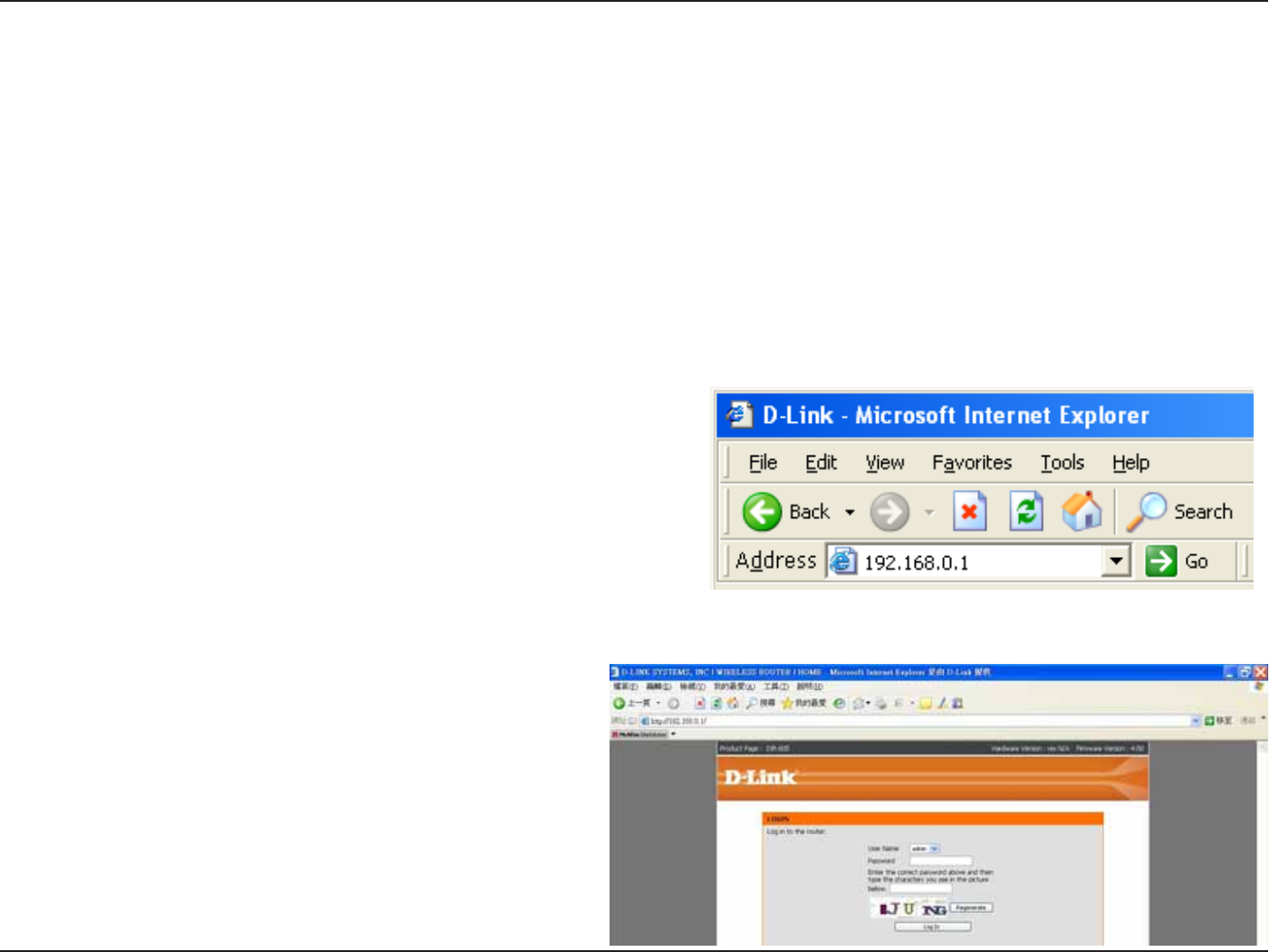
13
D-Link DIR-605 User Manual
Section 3 - Conguration
Conguration
This section will show you how to configure your new D-Link wireless router using the web-based configuration
utility.
Web-based Conguration Utility
To access the conguration utility, open a web-browser
such as Internet Explorer and enter the IP address of
the router (192.168.0.1).
Select Admin from the drop-down menu and then enter
your password. Leave the password blank by default.
If you get a Page Cannot be Displayed error, please
refer to the Troubleshooting section for assistance.
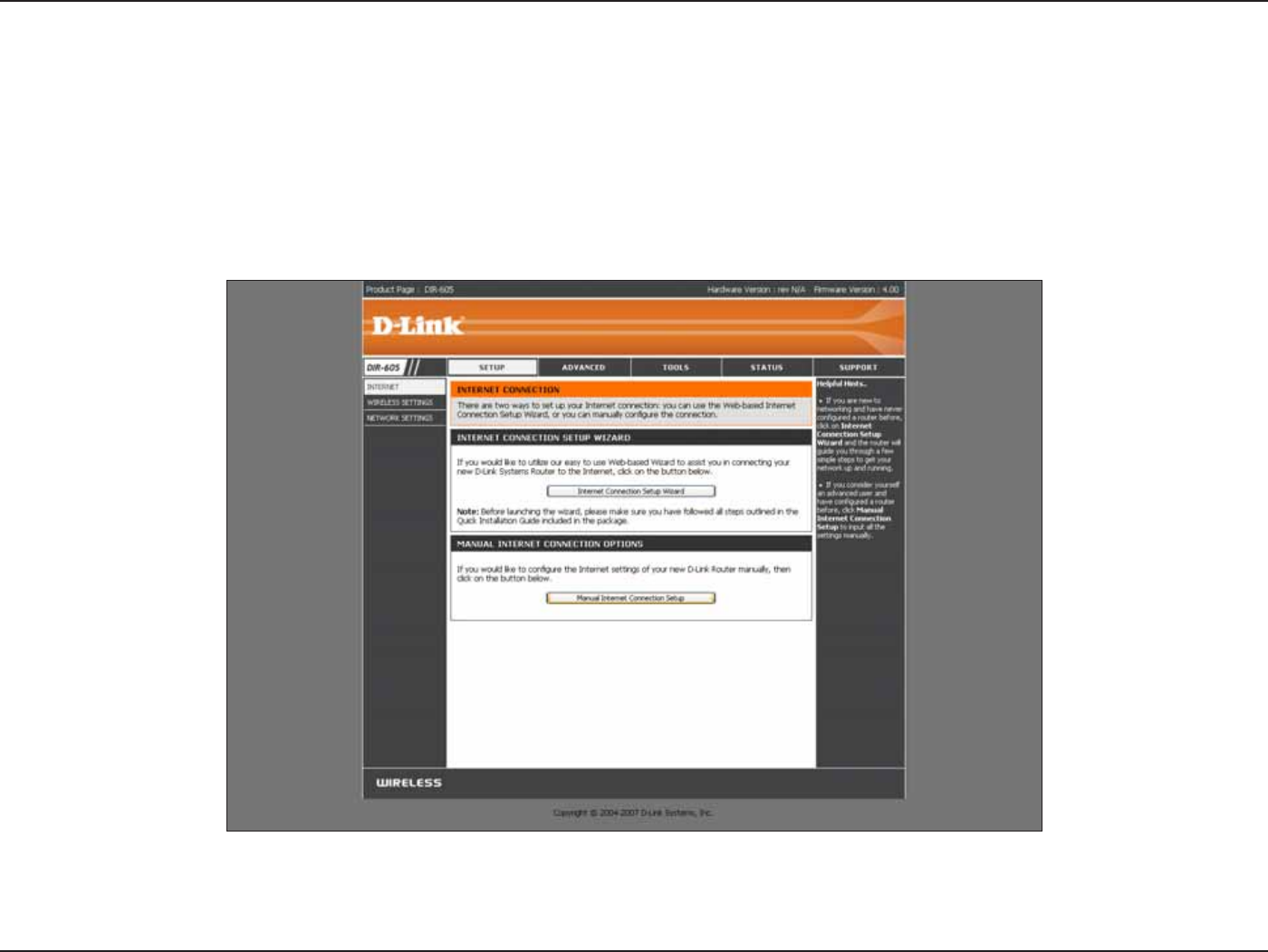
14
D-Link DIR-605 User Manual
Section 3 - Conguration
Internet Connection Setup Wizard
Once logged into the web interface of the router, the Setup > Internet page will appear. Click the Internet Connection
Setup Wizard button to quickly congure your router using the setup wizard.
If you want to enter your settings without running the wizard, click Manual Internet Configuration Wizard and skip
to page 19.
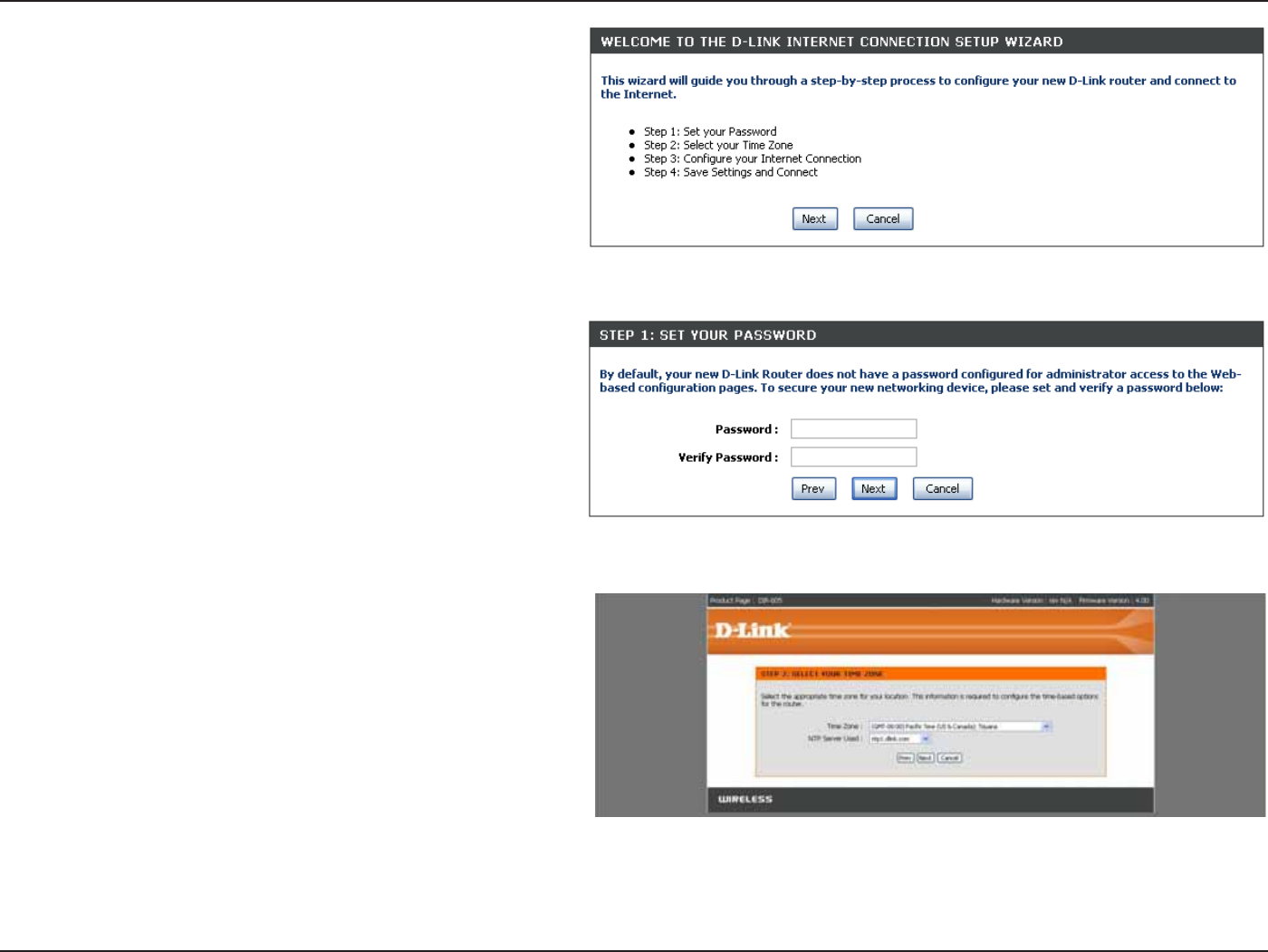
15
D-Link DIR-605 User Manual
Section 3 - Conguration
Click Next to continue.
Create a new password and then click Next to
continue.
Select your time zone from the drop-down menu and
then click Next to continue.
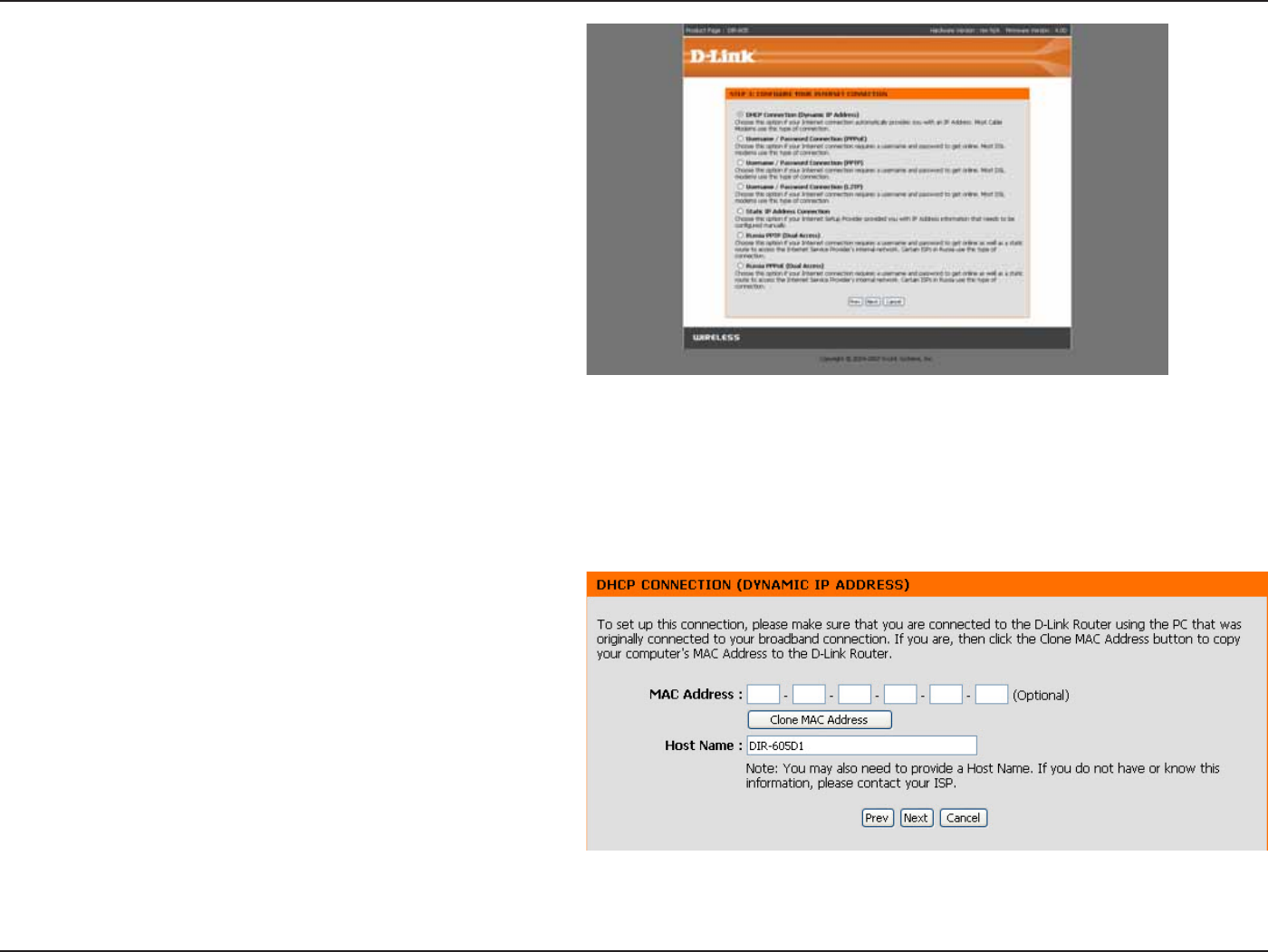
16
D-Link DIR-605 User Manual
Section 3 - Conguration
If you selected Dynamic, you may need to enter the
MAC address of the computer that was last connected
directly to your modem. If you are currently using that
computer, click $MPOF:PVS1$T."$"EESFTT and
then click Next to continue.
The Host Name is optional but may be required by
some ISPs. The default host name is the device
name of the Router and may be changed.
Select the type of Internet connection you use and
then click Next to continue.
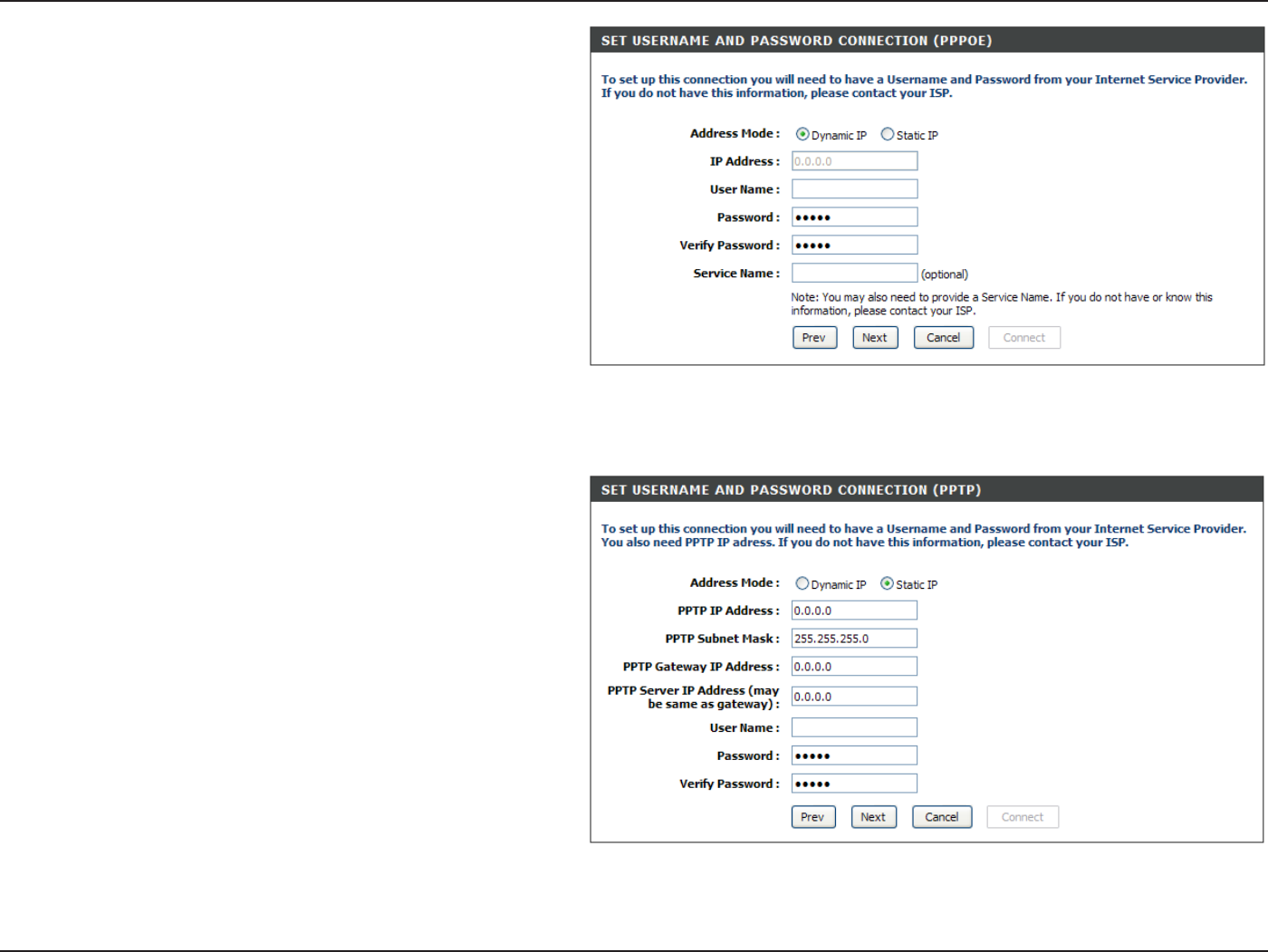
17
D-Link DIR-605 User Manual
Section 3 - Conguration
If you selected PPTP, enter your PPTP username
and password. Click Next to continue.
If you selected PPPoE, enter your PPPoE username
and password. Click Next to continue.
Select Static if your ISP assigned you the IP
address, subnet mask, gateway, and DNS server
addresses.
Note: Make sure to remove your PPPoE software
from your computer. The software is no longer
needed and will not work through a router.
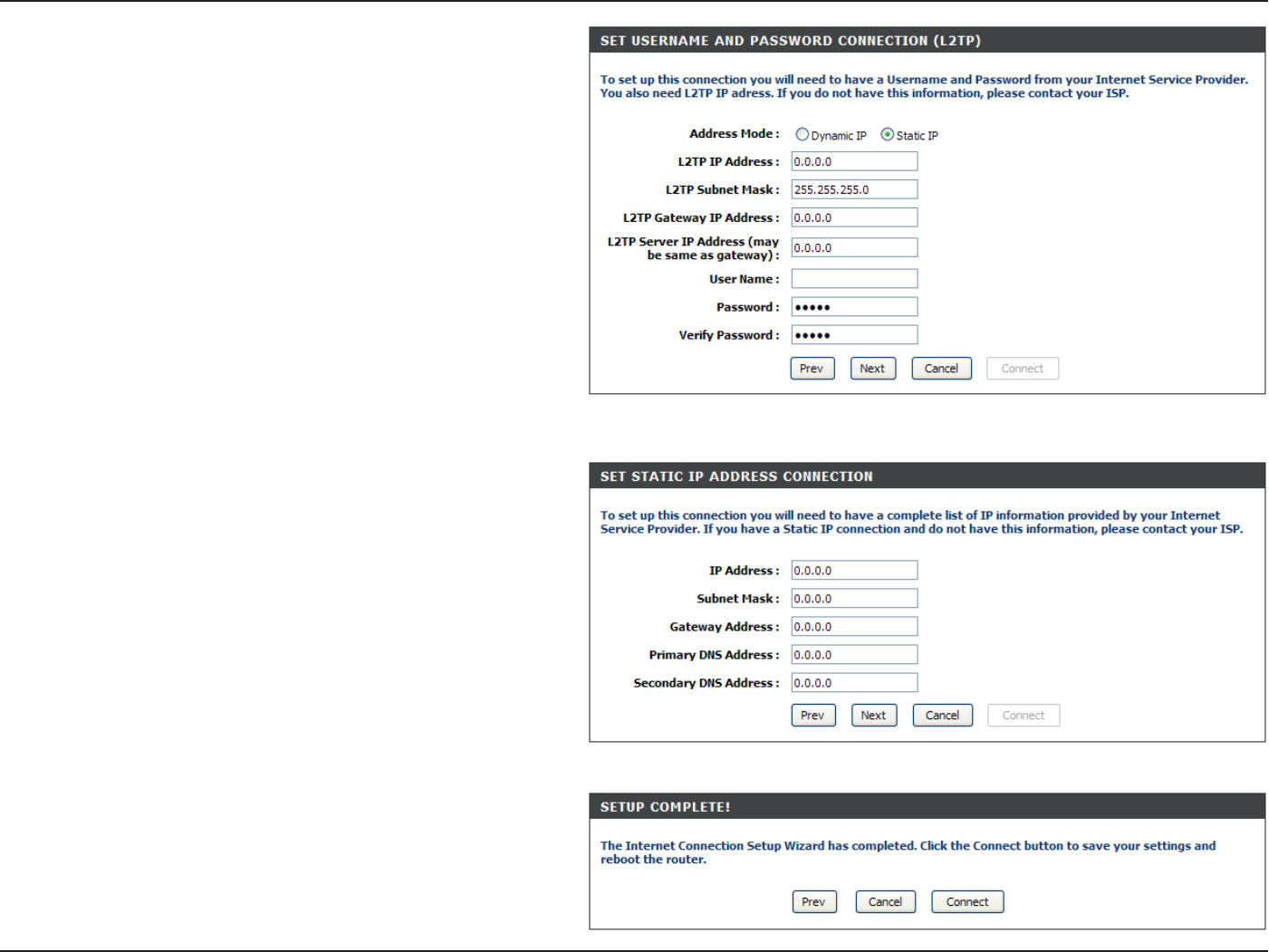
18
D-Link DIR-605 User Manual
Section 3 - Conguration
If you selected L2TP, enter your L2TP username
and password. Click Next to continue.
If you selected Static, enter your network settings
supplied by your Internet provider. Click Next to
continue.
Click Connect to save your settings. Once the router
is finished rebooting, click Continue. Please allow
1-2 minutes to connect.
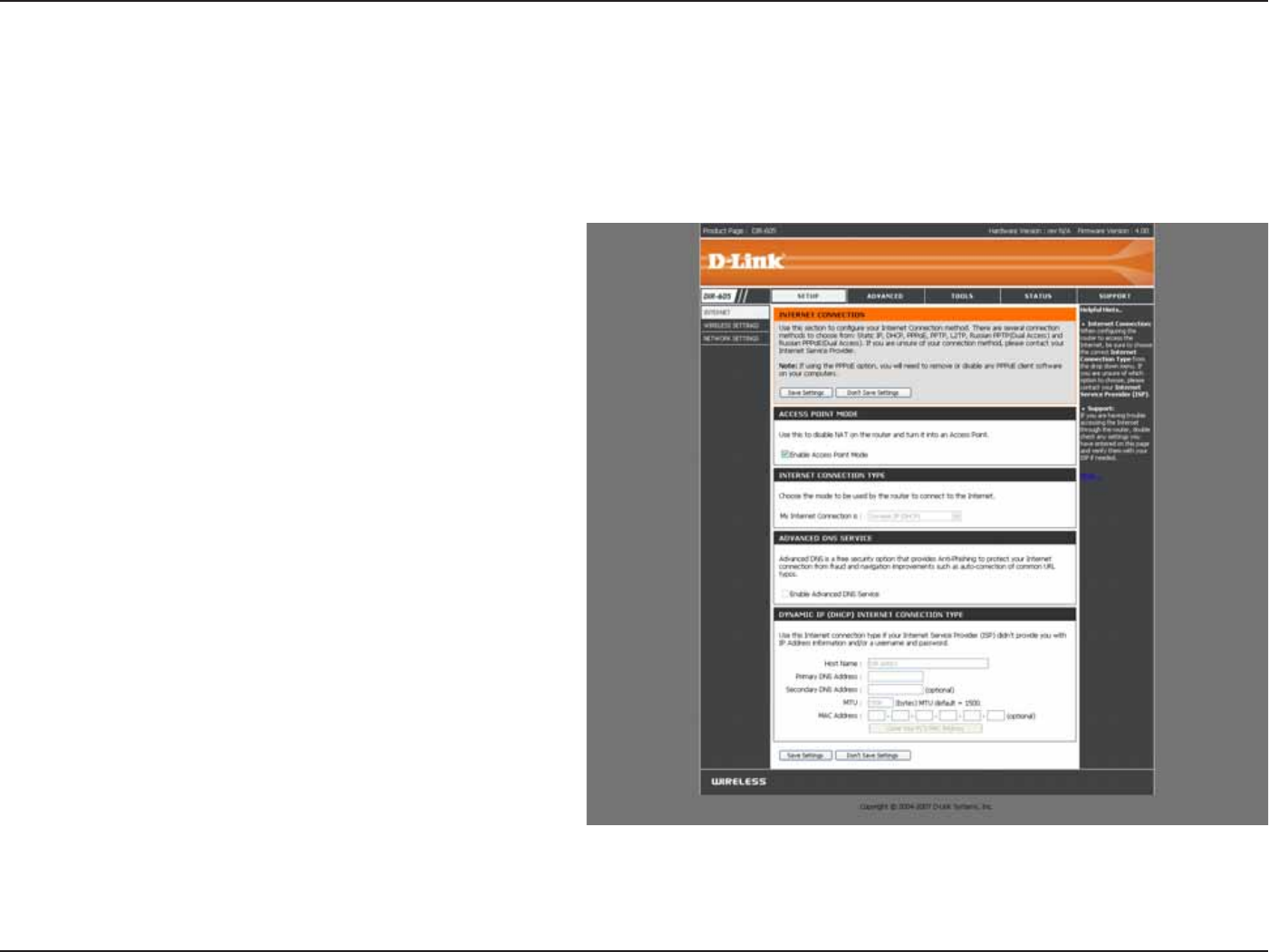
19
D-Link DIR-605 User Manual
Section 3 - Conguration
If you opt to set up your Internet connection manually, you will be redirected to a WAN page that allows you to select
your Internet type and enter the correct conguration parameters.
Select your Internet connection type using the “My
Internet Connection is” drop-down menu.
Click the Save Settings button when you have
congured the connection.
Manual Conguration
Dynamic (Cable)
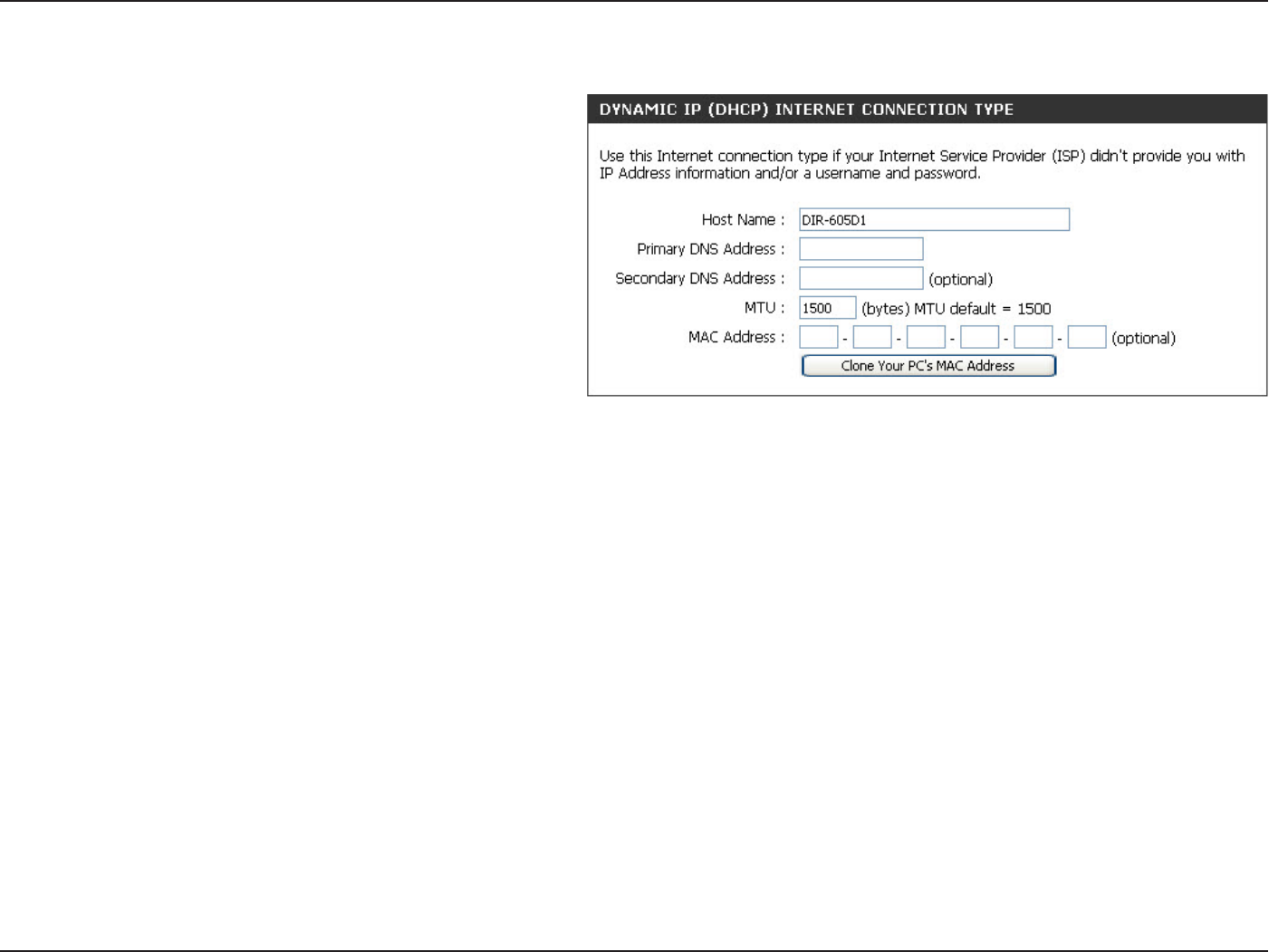
20
D-Link DIR-605 User Manual
Section 3 - Conguration
Dynamic IP Address (DHCP)
Select Dynamic IP (DHCP) to obtain IP Address
information automatically from your ISP. Select this
option if your ISP does not give you any IP numbers
to use. This option is commonly used for Cable
modem services.
The Host Name is optional but may be required by
some ISPs.
Check the box if you are having problems obtaining
an IP address from your ISP.
Enter the Primary DNS server IP address assigned
by your ISP.
Maximum Transmission Unit - you may need to change the MTU for optimal performance with your specific ISP. 1500 is
the default MTU.
The default MAC Address is set to the Internet port’s physical interface MAC address on the Broadband Router. It is not
SFDPNNFOEFEUIBUZPVDIBOHF UIFEFGBVMU."$BEESFTTVOMFTTSFRVJSFECZZPVS*41:PVDBOVTF UIF$MPOF:PVS1$T
MAC Address button to replace the Internet port’s MAC address with the MAC address of your Ethernet card.
My Internet
Connection:
Host Name:
MAC Address:
DNS Addresses:
MTU:
Use Unicasting:
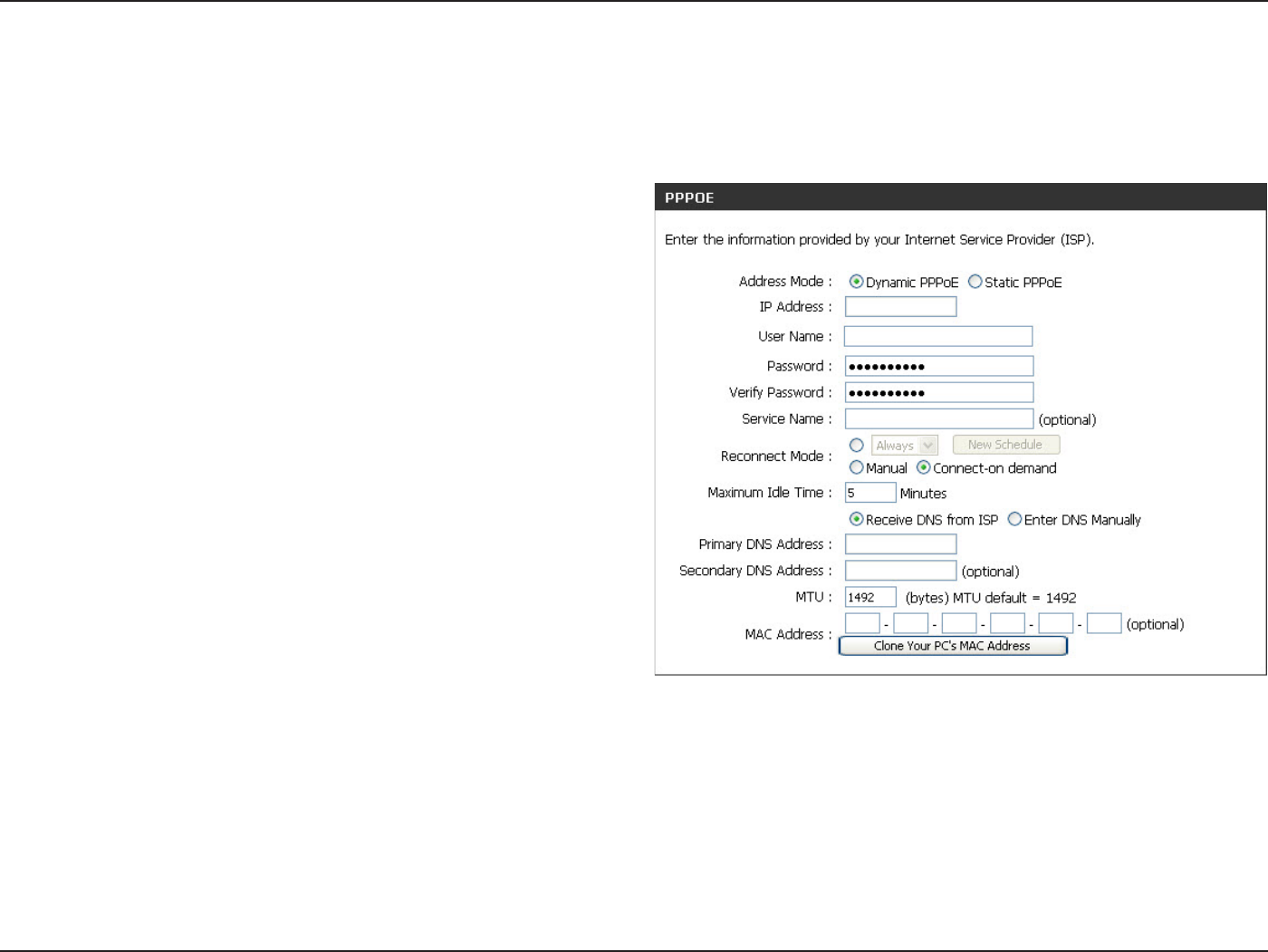
21
D-Link DIR-605 User Manual
Section 3 - Conguration
Select PPPoE (Username/Password) from the drop-down
menu.
Select Static if your ISP assigned you the IP address,
subnet mask, gateway, and DNS server addresses. In most
cases, select Dynamic.
Enter the IP address (Static PPPoE only).
Enter your PPPoE user name.
Enter your PPPoE password and then retype the password
in the next box.
Enter the ISP Service Name (optional).
Select either Always-on, On-Demand, or Manual.
Enter a maximum idle time during which the Internet
connection is maintained during inactivity. To disable
this feature, enable Auto-reconnect.
Enter the Primary and Secondary DNS Server Addresses (Static PPPoE only).
Maximum Transmission Unit - you may need to change the MTU for optimal performance with your specic ISP. 1492 is the default
MTU.
The default MAC Address is set to the Internet port’s physical interface MAC address on the Broadband Router. It is not recommended
UIBUZPVDIBOHFUIFEFGBVMU."$BEESFTTVOMFTTSFRVJSFECZZPVS*41:PVDBOVTFUIF$MPOF:PVS1$T."$"EESFTT button to
replace the Internet port’s MAC address with the MAC address of your Ethernet card.
My Internet
Connection:
Address Mode:
IP Address:
User Name:
Password:
Service Name:
Reconnection Mode:
Maximum Idle Time:
DNS Addresses:
MTU:
MAC Address:
PPPoE (DSL)
$IPPTF111P&1PJOUUP1PJOU1SPUPDPMPWFS&UIFSOFUJGZPVS*41VTFTB 111P&DPOOFDUJPO:PVS*41 XJMMQSPWJEF
you with a username and password. This option is typically used for DSL services. Make sure to remove your PPPoE
software from your computer. The software is no longer needed and will not work through a router.
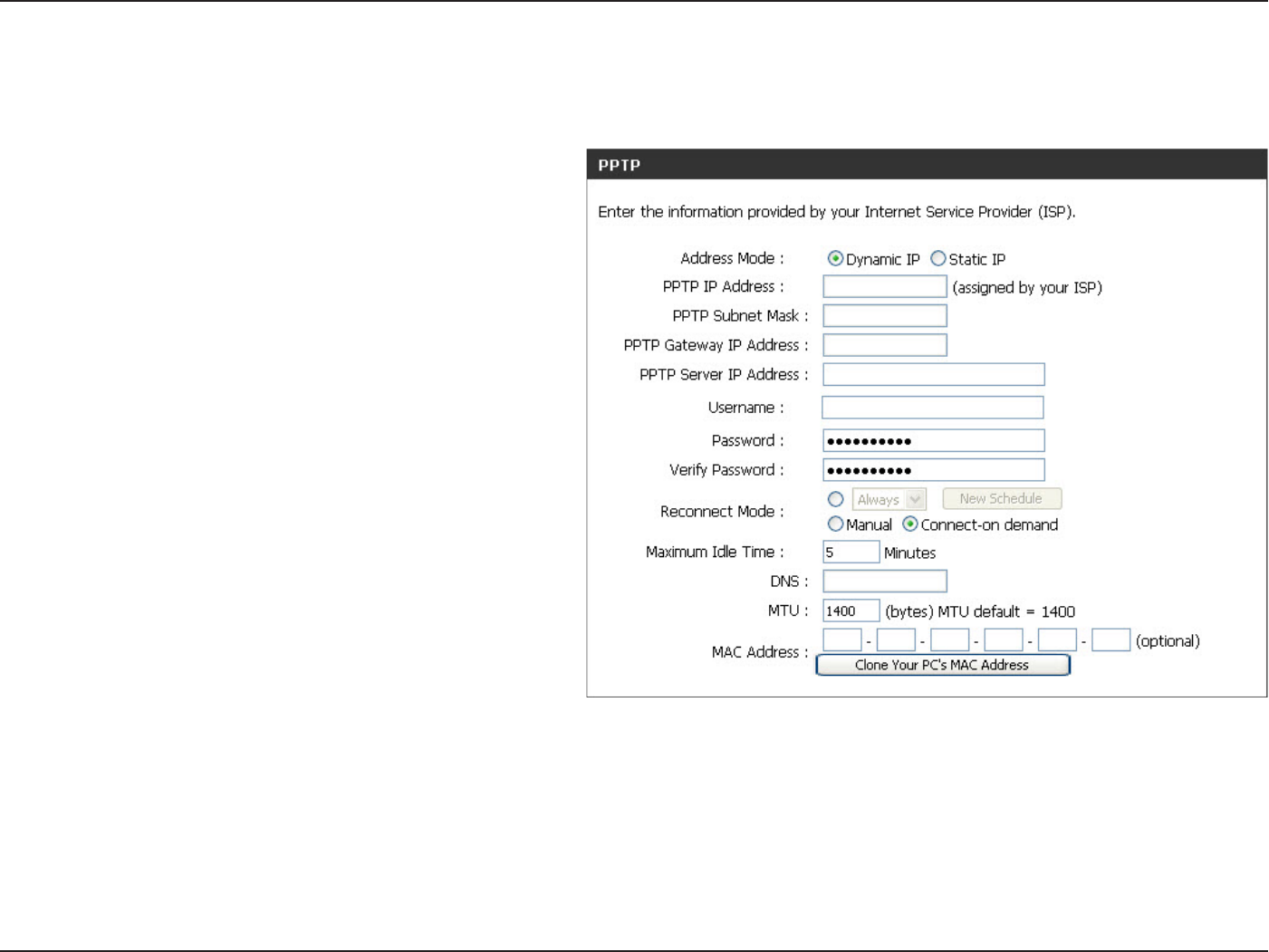
22
D-Link DIR-605 User Manual
Section 3 - Conguration
Select Static if your ISP assigned you the IP address,
subnet mask, gateway, and DNS server addresses.
In most cases, select Dynamic.
Enter the IP address (Static PPTP only).
Enter the Primary and Secondary DNS Server
Addresses (Static PPTP only).
Enter the Gateway IP Address provided by your
ISP.
Enter the Server IP provided by your ISP (optional).
Enter your PPTP username.
Enter your PPTP password and then retype the
password in the next box.
Select either Always-on, On-Demand, or Manual.
Enter a maximum idle time during which the Internet connection is maintained during inactivity. To disable this feature, enable
Auto-reconnect.
The DNS server information will be supplied by your ISP (Internet Service Provider.)
Maximum Transmission Unit - you may need to change the MTU for optimal performance with your specic ISP. 1400 is the
default MTU.
Address Mode:
PPTP IP Address:
PPTP Subnet
Mask:
PPTP Gateway:
PPTP Server IP:
PPTP
$IPPTF11511PJOUUP1PJOU5VOOFMJOH1SPUPDPMJG ZPVS*41VTFTB 1151DPOOFDUJPO:PVS*41 XJMMQSPWJEFZPVXJUI
a username and password. This option is typically used for DSL services.
Username:
Password:
Reconnect Mode:
Maximum Idle
Time:
DNS Servers:
MTU:

23
D-Link DIR-605 User Manual
Section 3 - Conguration
The default MAC Address is set to the Internet port’s physical interface MAC address on the Broadband Router. It is not recommended
UIBUZPVDIBOHFUIFEFGBVMU."$BEESFTTVOMFTTSFRVJSFECZZPVS*41:PVDBOVTFUIF$MPOF:PVS1$T."$"EESFTT button to
replace the Internet port’s MAC address with the MAC address of your Ethernet card.
MAC Address:
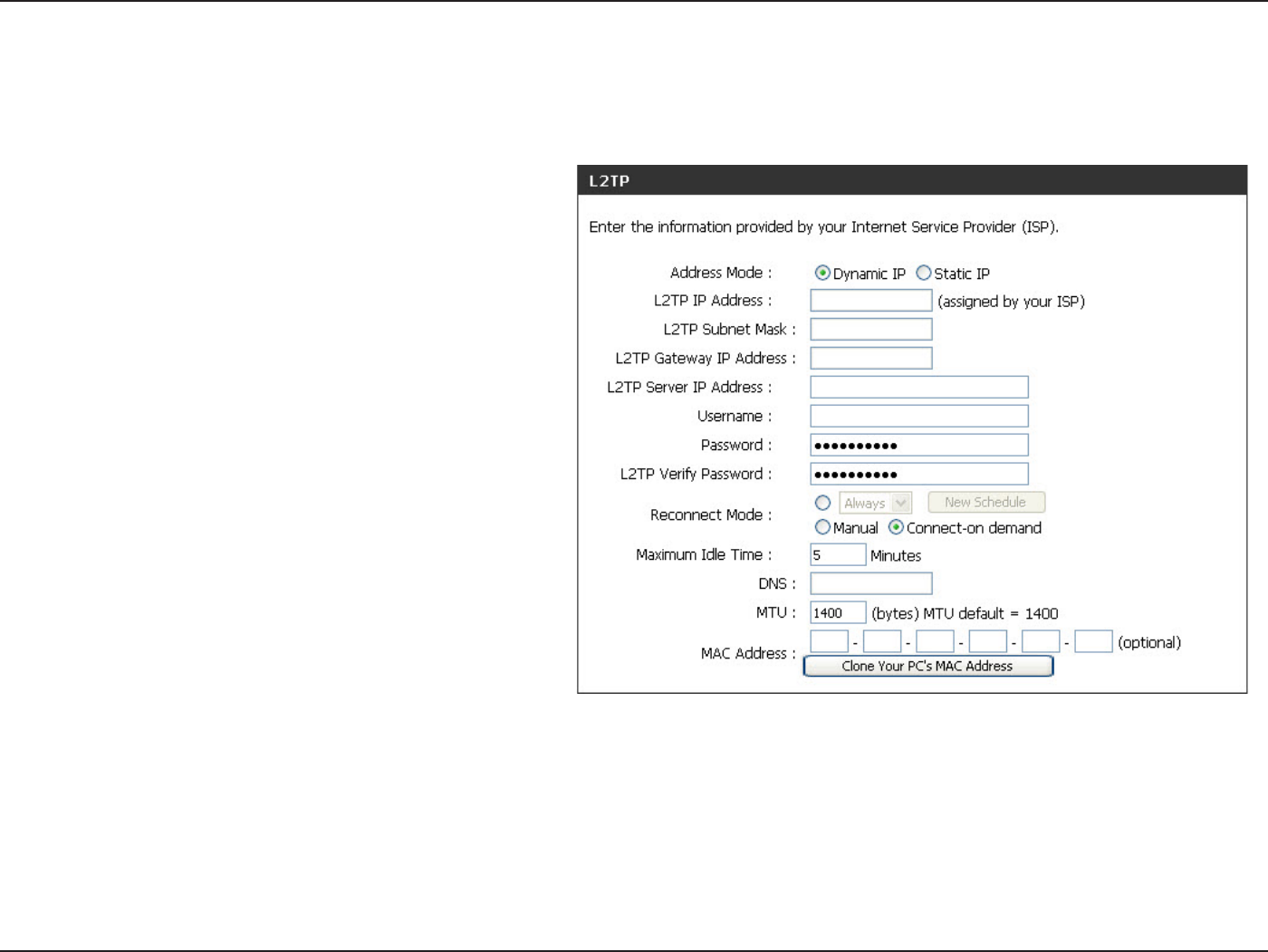
24
D-Link DIR-605 User Manual
Section 3 - Conguration
Select Static if your ISP assigned you the IP
address, subnet mask, gateway, and DNS server
addresses. In most cases, select Dynamic.
Enter the L2TP IP address supplied by your ISP
(Static only).
Enter the Subnet Mask supplied by your ISP
(Static only).
Enter the Gateway IP Address provided by your
ISP.
Enter the Server IP provided by your ISP
(optional).
Enter your L2TP username.
Enter your L2TP password and then retype the
password in the next box.
Select either Always-on, On-Demand, or Manual.
Enter a maximum idle time during which the Internet connection is maintained during inactivity. To disable this feature,
enable Auto-reconnect.
Enter the Primary and Secondary DNS Server Addresses (Static L2TP only).
Address Mode:
L2TP IP Address:
L2TP Subnet Mask:
L2TP Gateway:
L2TP Server IP:
Username:
Password:
Reconnect Mode:
Maximum Idle Time:
DNS Servers:
L2TP
$IPPTF-51-BZFS5VOOFMJOH1SPUPDPMJGZPVS*41VTFTB -51DPOOFDUJPO:PVS*41 XJMMQSPWJEFZPVXJUIB
username and password. This option is typically used for DSL services.

25
D-Link DIR-605 User Manual
Section 3 - Conguration
MTU:
Clone MAC
Address:
Maximum Transmission Unit - you may need to change the MTU for optimal performance with your specific ISP. 1400 is
the default MTU.
The default MAC Address is set to the Internet port’s physical interface MAC address on the Broadband Router. It is not
SFDPNNFOEFEUIBUZPVDIBOHF UIFEFGBVMU."$BEESFTTVOMFTTSFRVJSFECZZPVS*41:PVDBOVTF UIF $MPOF:PVS 1$T
MAC Address button to replace the Internet port’s MAC address with the MAC address of your Ethernet card.
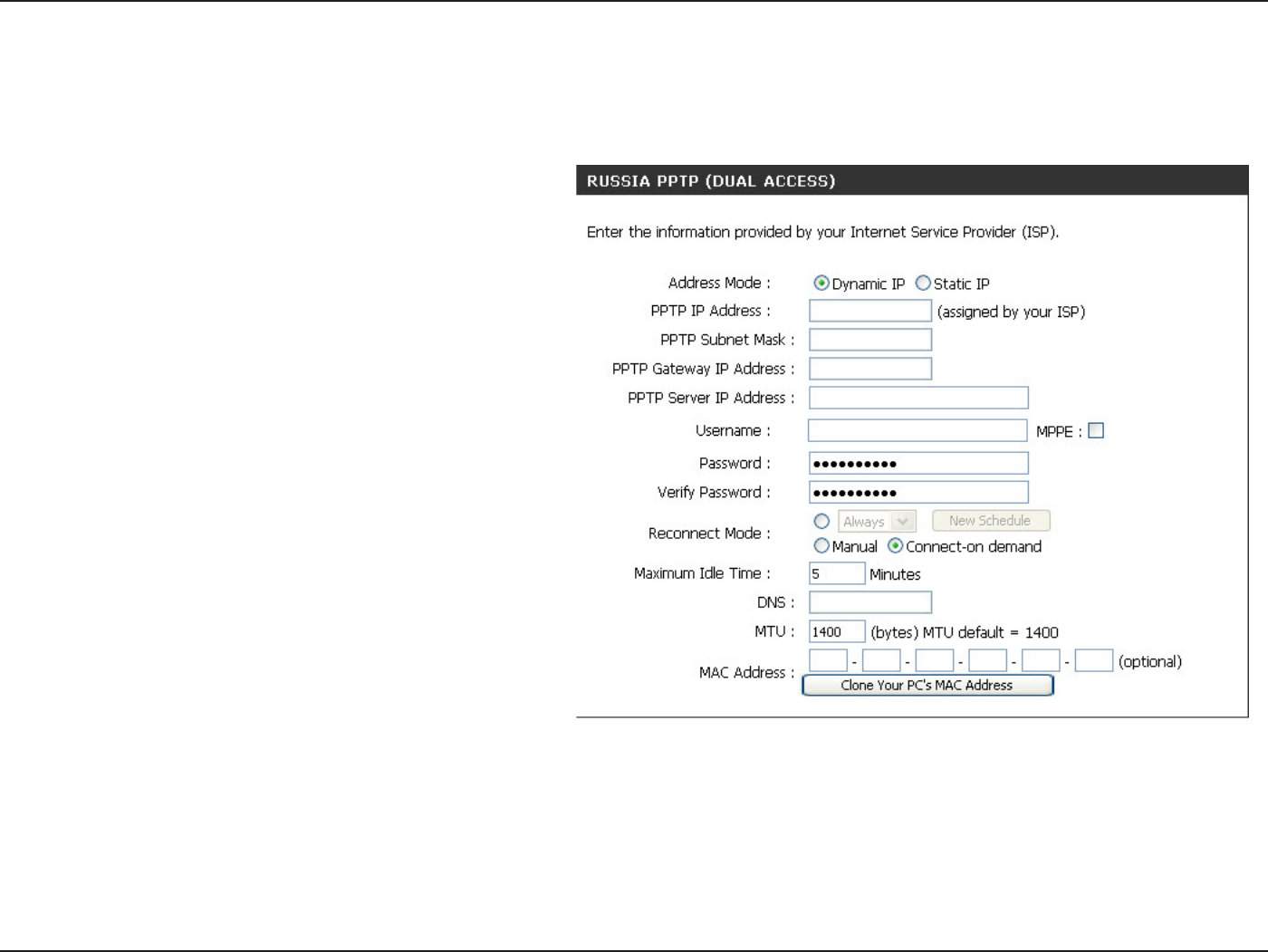
26
D-Link DIR-605 User Manual
Section 3 - Conguration
Select Static if your ISP assigned you the IP
address, subnet mask, gateway, and DNS server
addresses. In most cases, select Dynamic.
Enter the IP address (Static PPTP only).
Enter the Primary and Secondary DNS server
Addresses (Static PPTP only).
Enter the Gateway IP Address provided by your
ISP.
Enter the Server IP provided by your ISP
(optional).
Enter your PPTP username.
Enter your PPTP password and then retype the
password in the next box.
Select either Always-on, On-Demand, or
Manual.
Enter a maximum idle time during which the Internet connection is maintained during inactivity. To disable this feature, enable
Auto-reconnect.
Enter the Primary and Secondary DNS Server Addresses (Static L2TP only).
Address Mode:
PPTP IP Address:
PPTP Subnet
Mask:
PPTP Gateway:
PPTP Server IP:
Username:
Password:
Reconnect Mode:
Maximum Idle Time:
DNS Servers:
Russia PPTP
$IPPTF3VTTJB1151%VBM"DDFTTJGZPVS*41VTFTB1151DPOOFDUJPO:PVS*41XJMMQSPWJEFZPVXJUIBVTFSOBNFBOEQBTTXPSE
This option is typically used for DSL services.

27
D-Link DIR-605 User Manual
Section 3 - Conguration
MTU:
Clone MAC
Address:
Maximum Transmission Unit - you may need to change the MTU for optimal performance with your specic ISP. 1400 is the default
MTU.
The default MAC Address is set to the Internet port’s physical interface MAC address on the Broadband Router. It is not recommended
UIBUZPVDIBOHFUIFEFGBVMU."$BEESFTTVOMFTTSFRVJSFECZZPVS*41:PVDBOVTFUIF$MPOF:PVS1$T."$"EESFTT button to replace
the Internet port’s MAC address with the MAC address of your Ethernet card.
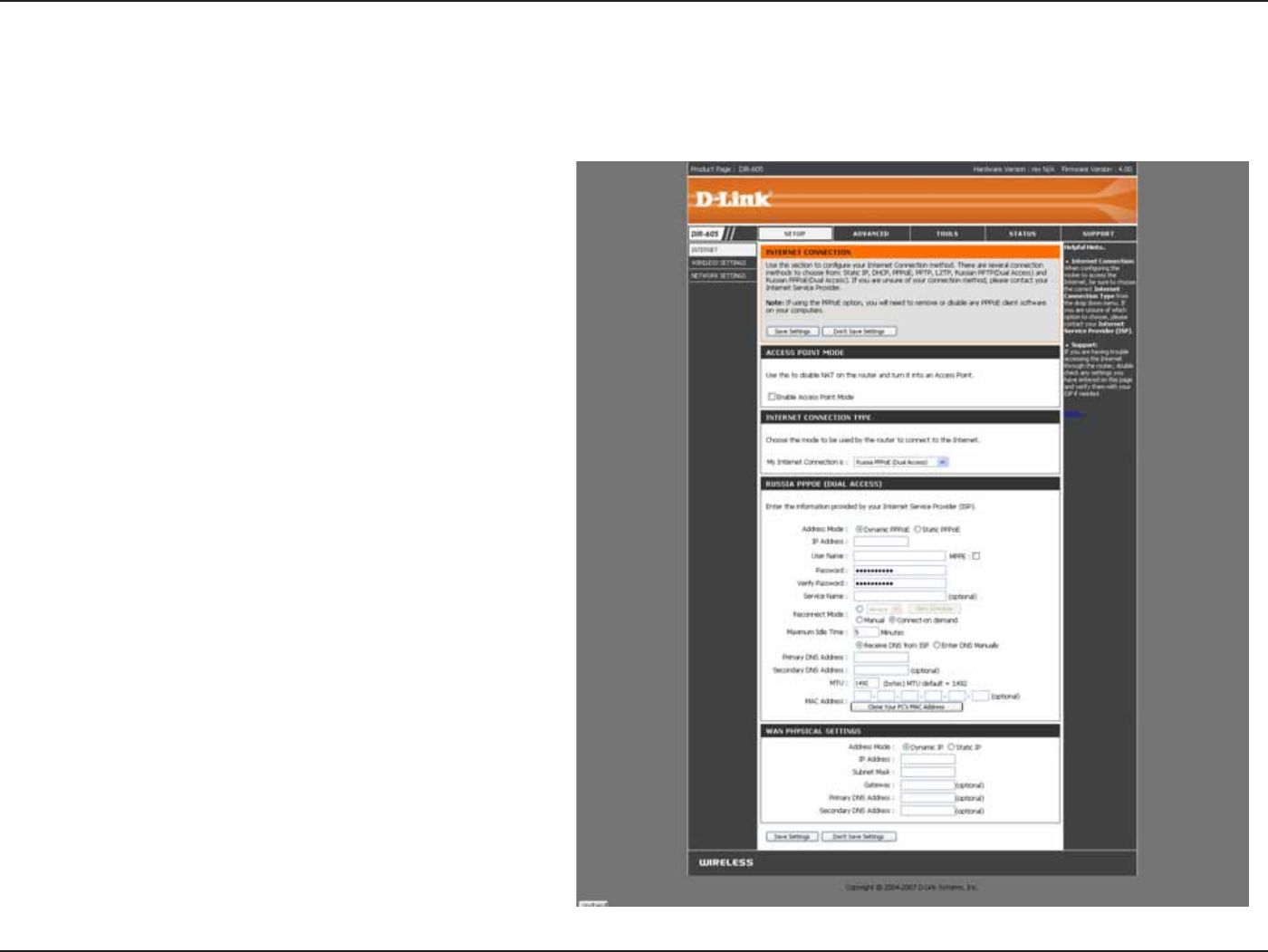
28
D-Link DIR-605 User Manual
Section 3 - Conguration
Save your settings after configuring your
Internet Connection method.
Enable to turn your router into an access point.
Choose your Internet Connection type.
Select Static if your ISP assigned you the IP
address, subnet mask, gateway, and DNS server
addresses. In most cases, select Dynamic.
Enter the IP address (Static PPPoE only).
Enter the Primary and Secondary DNS server
Addresses (Static PPPoE only).
Enter the Gateway IP Address provided by your
ISP.
Enter your PPPoE password and then retype the
password in the next box.
Select either Always-on, On-Demand, or
Manual.
Enter your PPPoE password and then retype the
password in the next box.
Internet Connection:
Access Point Mode:
Internet Connection
Type:
Address Mode:
PPPoE IP Address:
PPPoE Subnet
Mask:
PPPoE Gateway:
PPPoE Server IP:
Username:
Password:
Russia PPPoE
$IPPTF3VTTJB111P&%VBM"DDFTTJGZPVS*41VTFTB111P&DPOOFDUJPO:PVS*41XJMMQSPWJEFZPVXJUIBVTFSOBNFBOEQBTTXPSE
This option is typically used for DSL services.

29
D-Link DIR-605 User Manual
Section 3 - Conguration
Reconnect
Mode:
Maximum
Idle Time:
DNS Servers:
MTU:
Clone MAC
Address:
Select either Always-on, On-Demand, or Manual.
Enter a maximum idle time during which the Internet connection is maintained during inactivity. To disable this feature, enable
Auto-reconnect.
Enter the Primary and Secondary DNS Server Addresses (Static L2TP only).
Maximum Transmission Unit - you may need to change the MTU for optimal performance with your specic ISP. 1400 is the default
MTU.
The default MAC Address is set to the Internet port’s physical interface MAC address on the Broadband Router. It is not recommended
UIBUZPVDIBOHFUIFEFGBVMU."$BEESFTTVOMFTTSFRVJSFECZZPVS*41:PVDBOVTFUIF$MPOF:PVS1$T."$"EESFTT button to replace
the Internet port’s MAC address with the MAC address of your Ethernet card.

30
D-Link DIR-605 User Manual
Section 3 - Conguration
Enter the IP address assigned by your ISP.
Enter the Subnet Mask assigned by your ISP.
Enter the Gateway assigned by your ISP.
The DNS server information will be supplied by your ISP (Internet Service Provider.)
Maximum Transmission Unit - you may need to change the MTU for optimal performance with your specic ISP. 1500 is the default
MTU.
The default MAC Address is set to the Internet port’s physical interface MAC address on the Broadband Router. It is not recommended
UIBUZPVDIBOHFUIFEFGBVMU."$BEESFTTVOMFTTSFRVJSFECZZPVS*41:PVDBOVTFUIF$MPOF:PVS1$T."$"EESFTT button to replace
the Internet port’s MAC address with the MAC address of your Ethernet card.
IP Address:
Subnet Mask:
Default Gateway:
DNS Servers:
MTU:
MAC Address
Static IP Address
4FMFDU 4UBUJD*1"EESFTTJGBMM UIF*OUFSOFUQPSUT *1JOGPSNBUJPOJTQSPWJEFEUPZPVCZZPVS*41:PVXJMM OFFEUPFOUFSJOUIF*1BEESFTT
subnet mask, gateway address, and DNS address(es) provided to you by your ISP. Each IP address entered in the fields must be in the
appropriate IP form, which are four octets separated by a dot (x.x.x.x). The Router will not accept the IP address if it is not in this format.
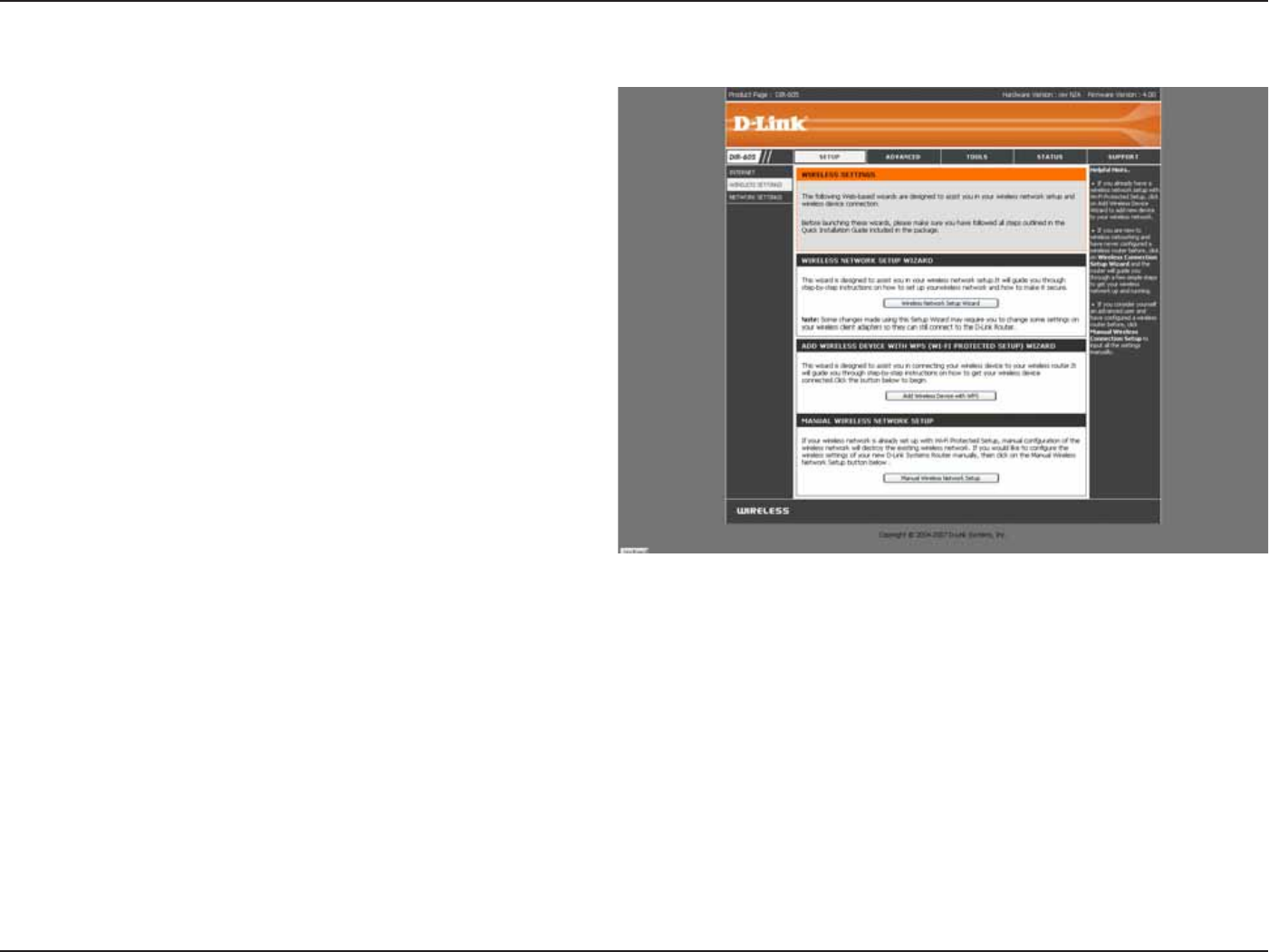
31
D-Link DIR-605 User Manual
Section 3 - Conguration
Wireless Settings
If you want to congure the wireless settings on your
router using the wizard, click Wireless Connection
Setup Wizard and refer to page 80.
Click Add Wireless Device with WPS if you want to
add a wireless device using Wi-Fi Protected Setup
(WPS) and refer to page 83.
If you want to manually congure the wireless settings
on your router click Manual Wireless Network Setup
and refer to the next page.
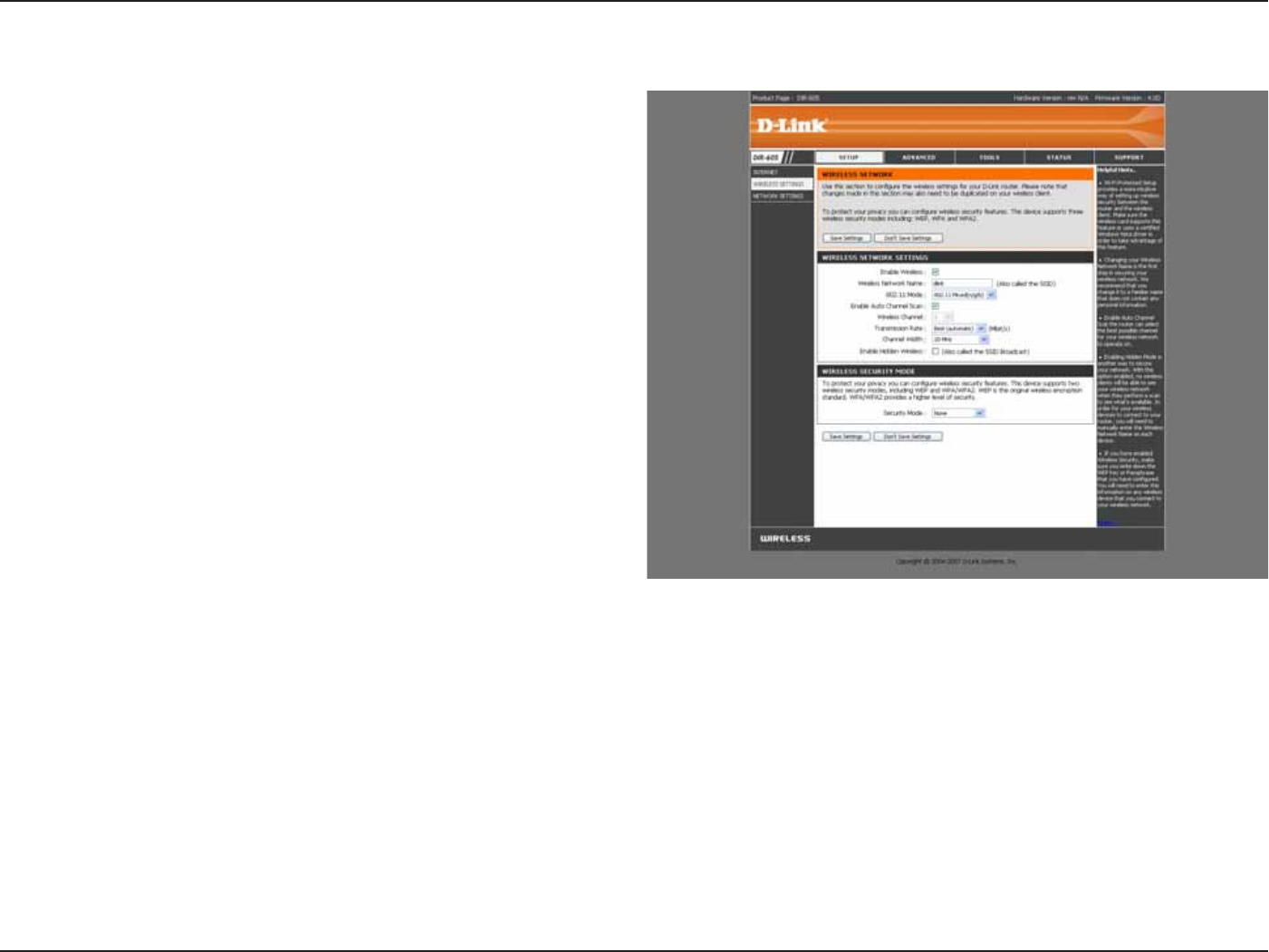
32
D-Link DIR-605 User Manual
Section 3 - Conguration
Manual Wireless Network Setup
Check the box to enable the wireless function. If you do
not want to use wireless, uncheck the box to disable all
the wireless functions. Click Add New to create your own
time schedule to enable the wireless function.
Service Set Identier (SSID) is the name of your wireless
network. Create a name using up to 32 characters. The
SSID is case-sensitive.
Select one of the following:
802.11g Only - Select if all of your wireless clients are
802.11g.
Mixed 802.11g and 802.11b - Select if you are using
both 802.11b and 802.11g wireless clients.
802.11b Only - Select if all of your wireless clients are
802.11b.
802.11n Only - Select only if all of your wireless clients
are 802.11n.
Mixed 802.11n, 802.11b, and 802.11g - Select if you are
using a mix of 802.11n, 11g, and 11b wireless clients.
Mixed 802.11n and 802.11g - Select if you are using a
mix of 802.11n and 802.11g wireless clients.
The Auto Channel Scan setting can be selected to allow the DIR-605 to choose the channel with the least amount of interference.
Indicates the channel setting for the DIR-605. By default the channel is set to 6. The Channel can be changed to t the channel
setting for an existing wireless network or to customize the wireless network. If you enable Auto Channel Scan, this option will be
greyed out.
Select the transmit rate. It is strongly suggested to select Best (Auto) for best performance.
Select the Channel Width:
Enable Wireless:
Wireless Network
Name:
802.11 Mode:
Transmission Rate:
Enable Auto
Channel Scan:
Wireless Channel:

33
D-Link DIR-605 User Manual
Section 3 - Conguration
Auto 20/40 - Select if you are using both 802.11n and non-802.11n wireless devices.
20MHz - Select if you are not using any 802.11n wireless clients. This is the default setting.
Select to enable hidden wireless.
Refer to page 79 for more information regarding wireless security.
Enable Hidden
Wireless:
Channel Width:
Wireless Security:
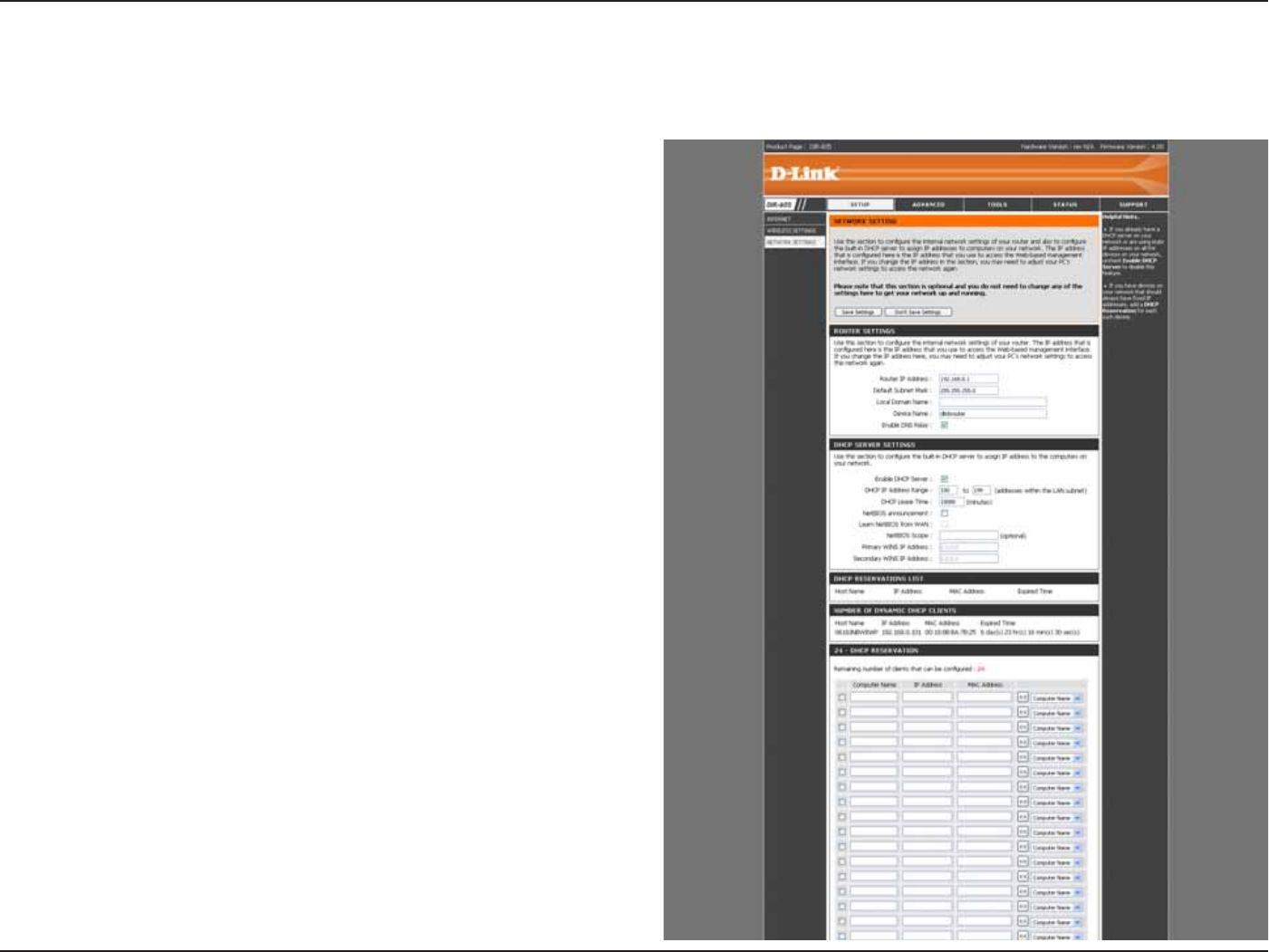
34
D-Link DIR-605 User Manual
Section 3 - Conguration
This section will allow you to change the local network settings of the router and to congure the DHCP settings.
Network Settings
Enter the IP address of the router. The default IP
address is 192.168.0.1.
If you change the IP address, once you click Apply, you
will need to enter the new IP address in your browser
to get back into the conguration utility.
Enter the Subnet Mask. The default subnet mask is
255.255.255.0.
Enter the Domain name (Optional).
Enter the Device name (set to “dlinkrouter” by default).
Uncheck the box to transfer the DNS server information
from your ISP to your computers. If checked, your
computers will use the router for a DNS server.
IP Address:
Subnet Mask:
Local Domain:
Device Name:
Enable DNS Relay:
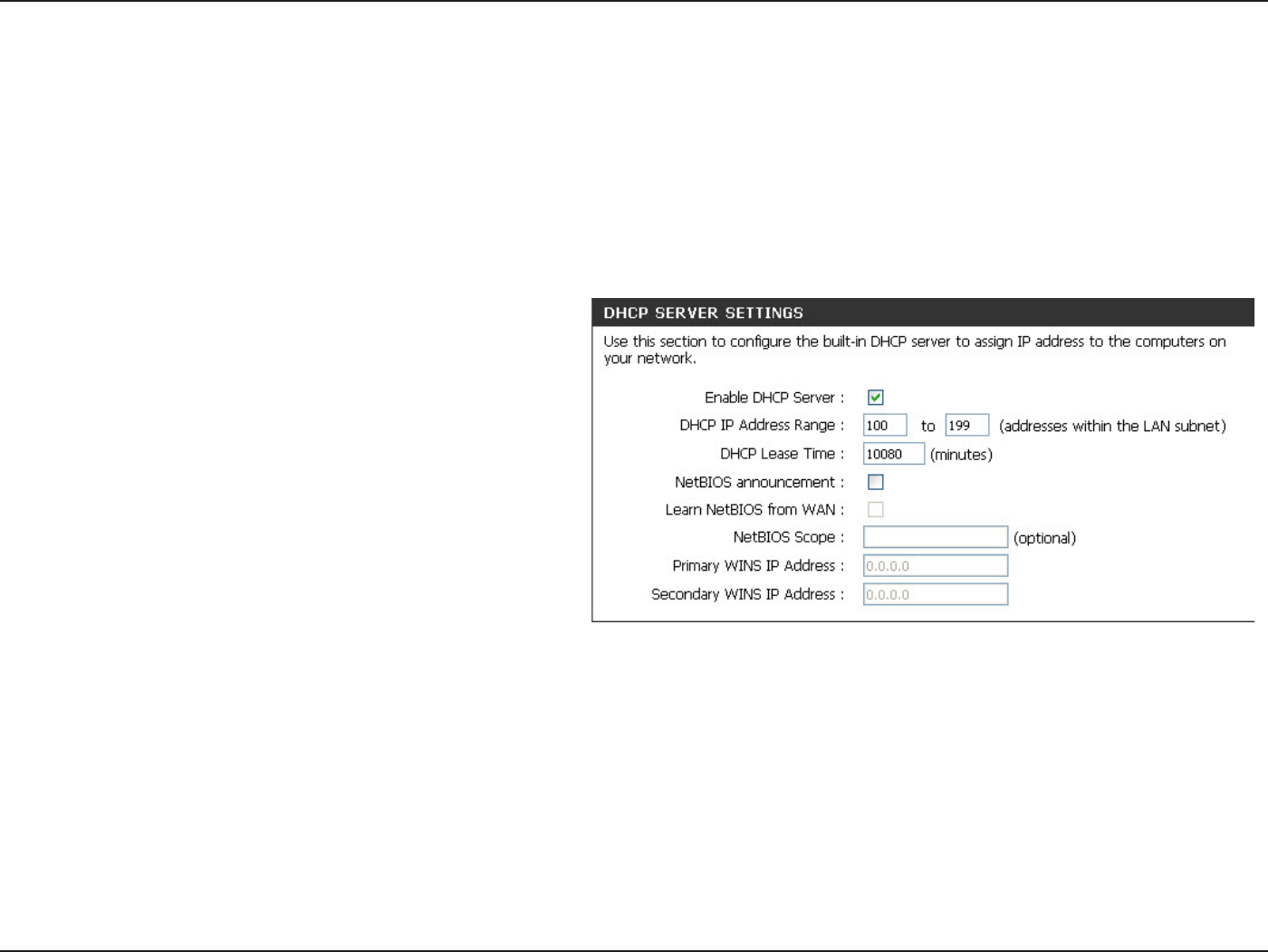
35
D-Link DIR-605 User Manual
Section 3 - Conguration
Check this box to enable the DHCP server on your
router. Uncheck to disable this function.
Enter the starting and ending IP addresses for the
DHCP server’s IP assignment.
Note: If you statically (manually) assign IP addresses
to your computers or devices, make sure the IP
addresses are outside of this range or you may have
an IP conict.
The length of time for the IP address lease. Enter
the Lease time in minutes.
The NetBIOS API allows applications on seperate
computers to communicate over LAN. The user can
check this option to enable this function.
Each computers in the network have both NetBIOS
name and IP address corresponding to the Host name.
The user may simply use the NetBIOS name to log in
router web interface. (The default is “dlinkrouter”)
Enable DHCP
Server:
DHCP IP Address
Range:
Lease Time:
NetBIOS
Announcement:
Learn NetBIOS
from WAN:
DHCP Server Settings
DHCP stands for Dynamic Host Control Protocol. The DIR-605 has a built-in DHCP server. The DHCP Server will automatically
assign an IP address to the computers on the LAN/private network. Be sure to set your computers to be DHCP clients by setting
their TCP/IP settings to “Obtain an IP Address Automatically.” When you turn your computers on, they will automatically load
the proper TCP/IP settings provided by the DIR-605. The DHCP Server will automatically allocate an unused IP address from
UIF*1BEESFTTQPPMUPUIFSFRVFTUJOHDPNQVUFS:PVNVTUTQFDJGZUIFTUBSUJOHBOEFOEJOHBEESFTTPGUIF*1BEESFTTQPPM

36
D-Link DIR-605 User Manual
Section 3 - Conguration
NetBIOS Scope
(optional):
Primary/
Secondary WINS
IP Address:
The users may add some characters behind the NetBIOS name to dierentiate it from other D-Link routers. It follows the naming
rule for DNS names.
Use this function to allow the seperate computers in a seperate subnet to search the computers in the same workgroup.
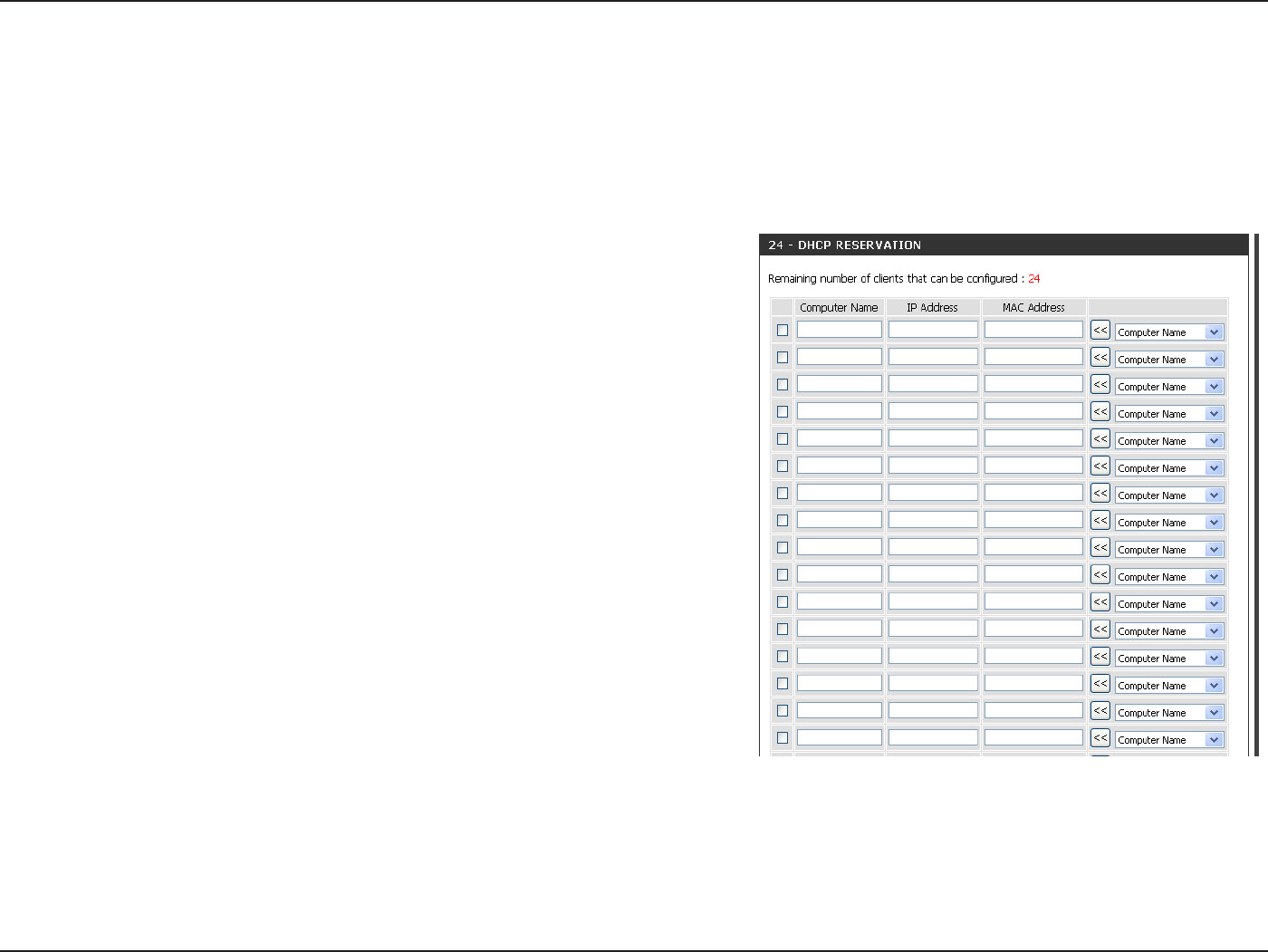
37
D-Link DIR-605 User Manual
Section 3 - Conguration
DHCP Reservation
If you want a computer or device to always have the same IP address assigned, you can create a DHCP reservation. The router
will assign the IP address only to that computer or device.
Note: This IP address must be within the DHCP IP Address Range.
Enter the computer name or select from the drop-down menu and click
<<.
Enter the IP address you want to assign to the computer or device. This
IP Address must be within the DHCP IP Address Range.
Enter the MAC address of the computer or device.
Click SaveUPTBWFZPVSFOUSZ:PVNVTUDMJDLSave Settings at the top to
activate your reservations.
In this section, you can see what LAN devices are currentl leasing IP
addresses.
The Reserve option converts this dynamic IP allocation into a DHCP
Reservation and adds the corresponding entry to the DHCP Reservations
List.
Computer Name:
IP Address:
MAC Address:
Save:
Number of
Dynamic DHCP
Clients:
Reserve:
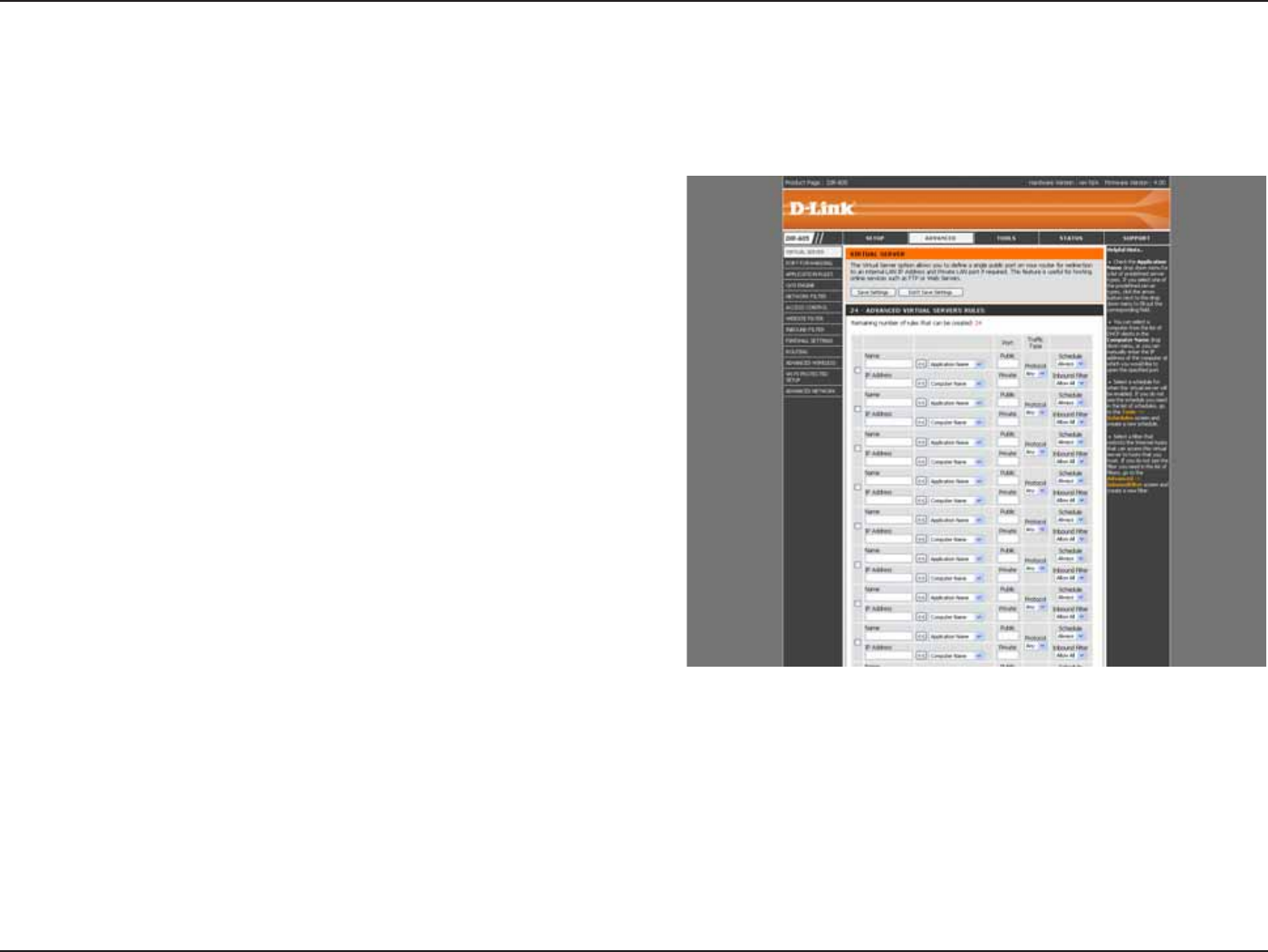
38
D-Link DIR-605 User Manual
Section 3 - Conguration
The DIR-605 can be congured as a virtual server so that remote users accessing Web or FTP services via the public IP address
can be automatically redirected to local servers in the LAN (Local Area Network).
The DIR-605 rewall feature lters out unrecognized packets to
protect your LAN network so all computers networked with the
DIR-605 are invisible to the outside world. If you wish, you can
make some of the LAN computers accessible from the Internet by
enabling Virtual Server. Depending on the requested service, the
DIR-605 redirects the external service request to the appropriate
server within the LAN network.
The DIR-605 is also capable of port-redirection meaning incoming
trac to a particular port may be redirected to a dierent port on
the server computer.
Each virtual service that is created will be listed at the
bottom of the screen in the Virtual Servers List. There are
QSFEFöOFEWJSUVBMTFSWJDFTBMSFBEZJOUIFUBCMF:PVNBZVTFUIFN
by enabling them and assigning the server IP to use that particular
virtual service.
For a list of ports for common applications, please visit http://support.dlink.com/faq/view.asp?prod_id=1191.
Virtual Server
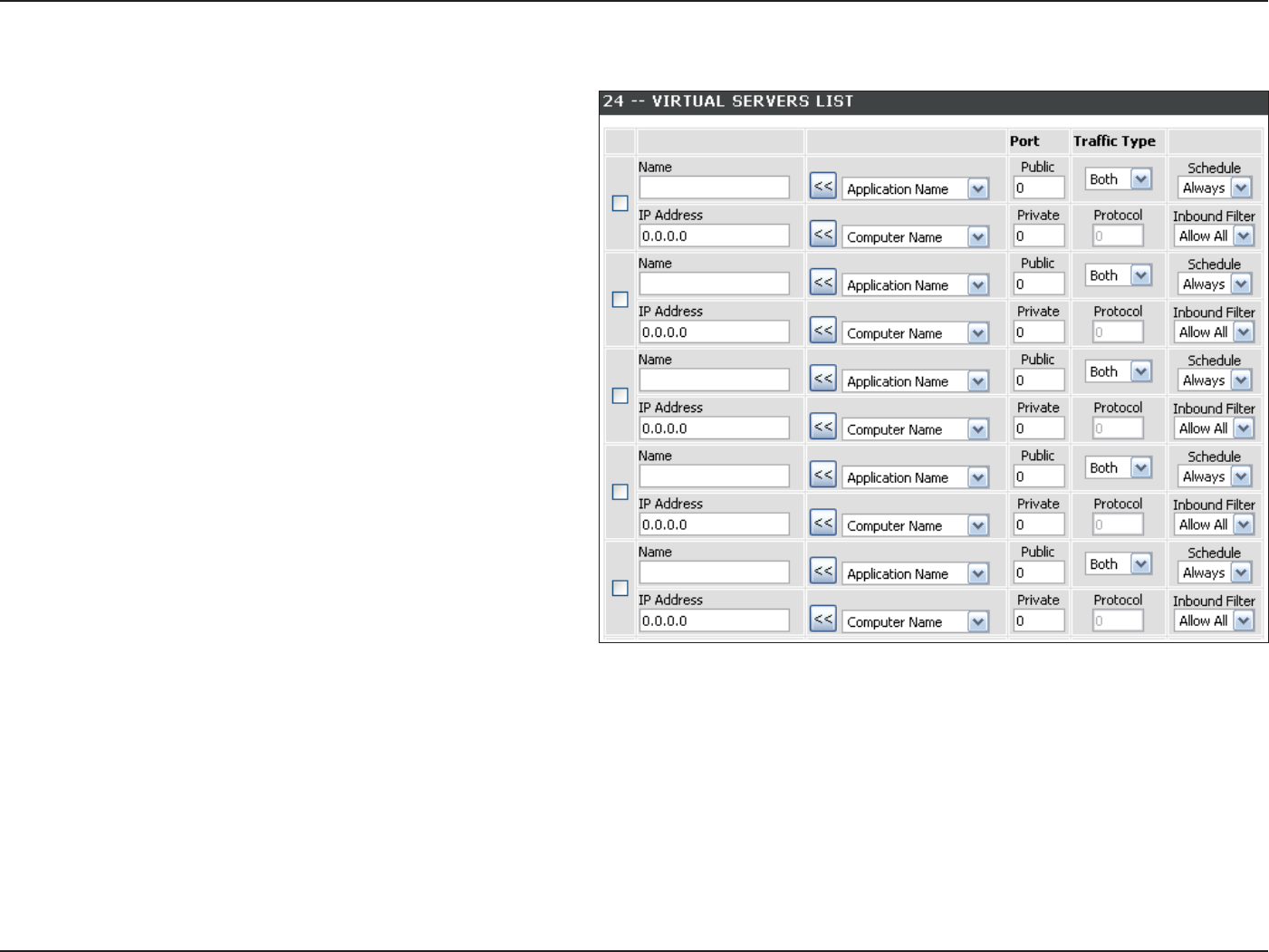
39
D-Link DIR-605 User Manual
Section 3 - Conguration
This will allow you to open a single port. If you would like to open a range of ports, refer to the next page.
Enter a name for the rule or select an application
from the drop-down menu. Select an application
and click << to populate the elds.
Enter the IP address of the computer on your
local network that you want to allow the incoming
service to. If your computer is receiving an IP
address automatically from the router (DHCP),
you computer will be listed in the “Computer
Name” drop-down menu. Select your computer
and click <<.
Enter the port that you want to open next to Private
Port and Public Port. The private and public ports
are usually the same. The public port is the port
seen from the Internet side, and the private port
is the port being used by the application on the
computer within your local network.
Select TCP, UDP, or Both from the drop-down
menu.
Select Allow All (most common) or a created
*OCPVOEöMUFS:PVNBZDSFBUFZPVSPXOJOCPVOEöMUFSTJOUIFAdvanced > Inbound Filter page.
The schedule of time when the Virtual Server Rule will be enabled. The schedule may be set to Always, which will allow the
QBSUJDVMBSTFSWJDFUPBMXBZTCFFOBCMFE:PVDBODSFBUFZPVSPXOUJNFTJOUIFTools > Schedules section.
Name:
IP Address:
Private Port/
Public Port:
Protocol Type:
Inbound Filter:
Schedule:
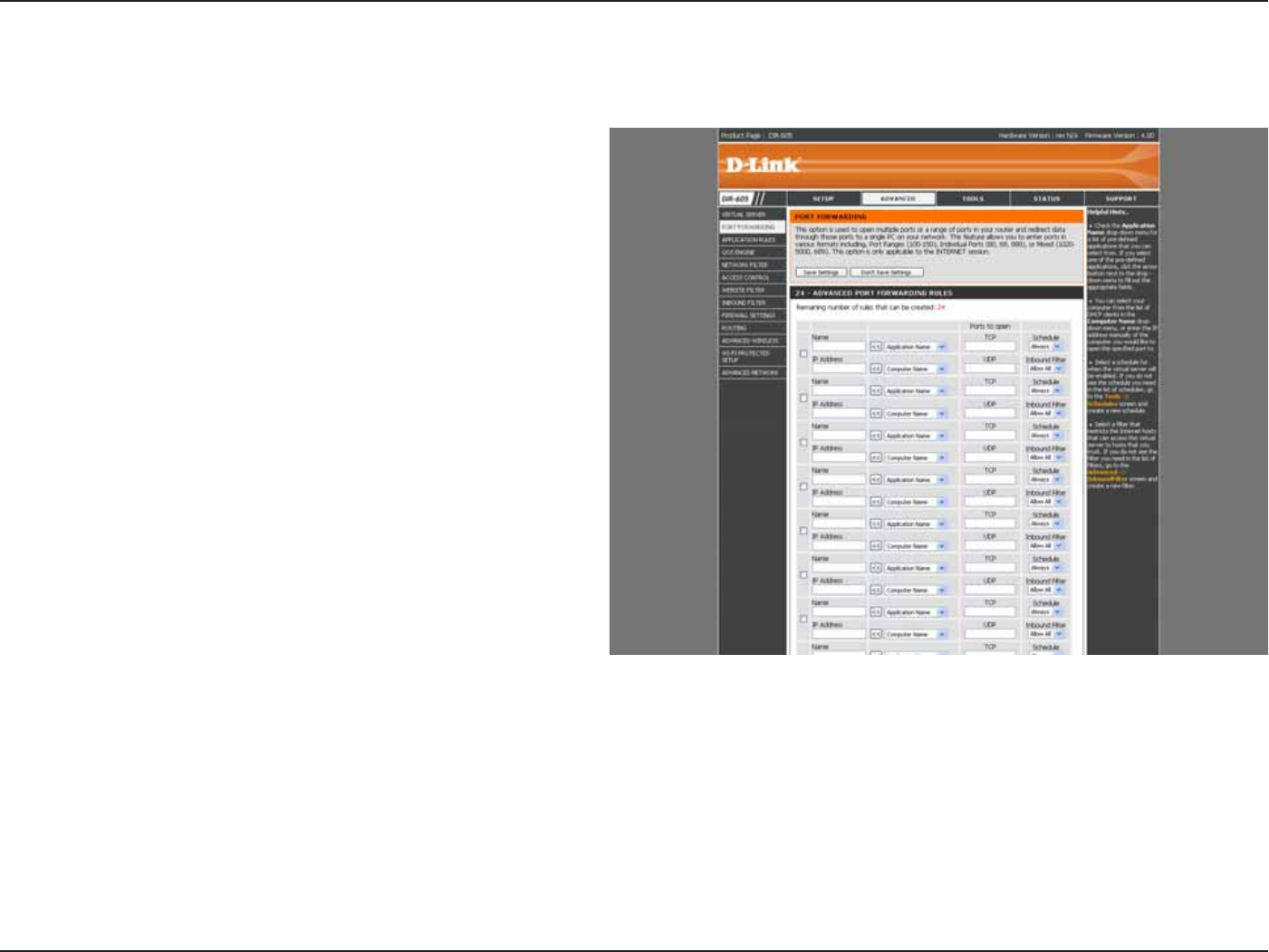
40
D-Link DIR-605 User Manual
Section 3 - Conguration
This will allow you to open a single port or a range of ports.
Port Forwarding
Enter a name for the rule or select an application
from the drop-down menu. Select an application
and click << to populate the elds.
Enter the IP address of the computer on your local
network that you want to allow the incoming service
to. If your computer is receiving an IP address
automatically from the router (DHCP), you computer
will be listed in the “Computer Name” drop-down
menu. Select your computer and click <<.
Enter the TCP and/or UDP port or ports that you
XBOUUPPQFO:PVDBOFOUFSBTJOHMFQPSUPSBSBOHF
of ports. Separate ports with a common.
Example: 24,1009,3000-4000
Select Allow All (most common) or a created
*OCPVOEGJMUFS:PV NBZDSFBUFZPVSPXOJOCPVOE
lters in the Advanced > Inbound Filter page.
The schedule of time when the Virtual Server Rule
will be enabled. The schedule may be set to Always,
which will allow the particular service to always
CFFOBCMFE:PVDBODSFBUFZPVSPXOUJNFTJOUIF
Tools > Schedules section.
Name:
IP Address:
TCP/UDP:
Inbound Filter:
Schedule:
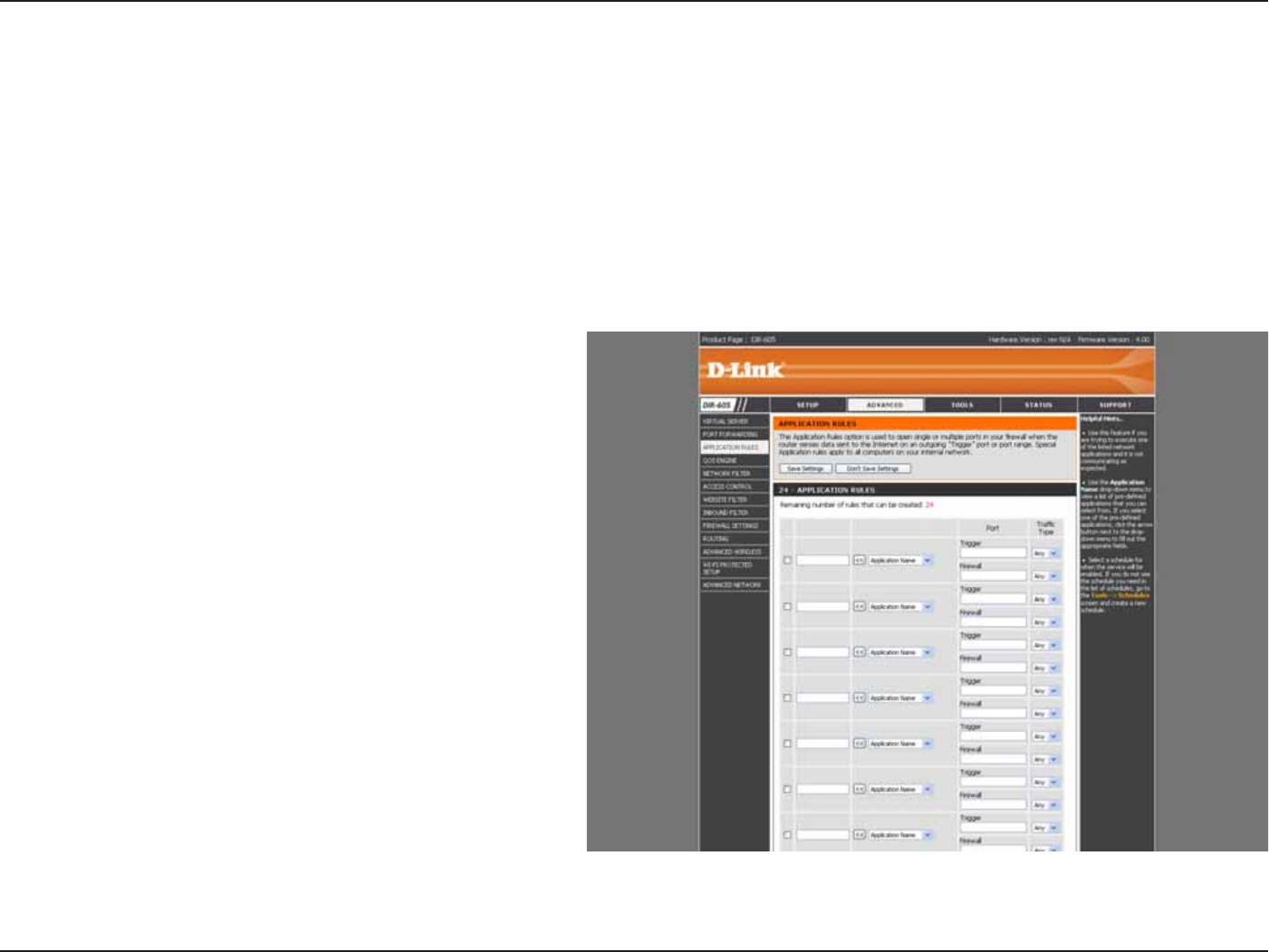
41
D-Link DIR-605 User Manual
Section 3 - Conguration
&OUFSB OBNFGPSUIFSVMF:PVNBZTFMFDU B
pre-defined application from the drop-down
menu and click <<.
This is the port used to trigger the application. It
can be either a single port or a range of ports.
Select the protocol of the trigger port (TCP,
UDP, or Both).
This is the port number on the Internet side that
XJMMCFVTFE UPBDDFTTUIFBQQMJDBUJPO:PVNBZ
EFGJOFBTJOHMF QPSUPS BSBOHFPGQPSUT:PV
can use a comma to add multiple ports or port
ranges.
Select the protocol of the firewall port (TCP,
UDP, or Both).
Name:
Trigger:
Trac Type:
Firewall:
Trac Type:
Application Rules
Some applications require multiple connections, such as Internet gaming, video conferencing, Internet telephony and others.
These applications have diculties working through NAT (Network Address Translation). Special Applications makes some of
these applications work with the DIR-605. If you need to run applications that require multiple connections, specify the port
normally associated with an application in the “Trigger Port” eld, select the protocol type as TCP or UDP, then enter the rewall
(public) ports associated with the trigger port to open them for inbound trac.
The DIR-605 provides some predened applications in the table on the bottom of the web page. Select the application you
want to use and enable it.
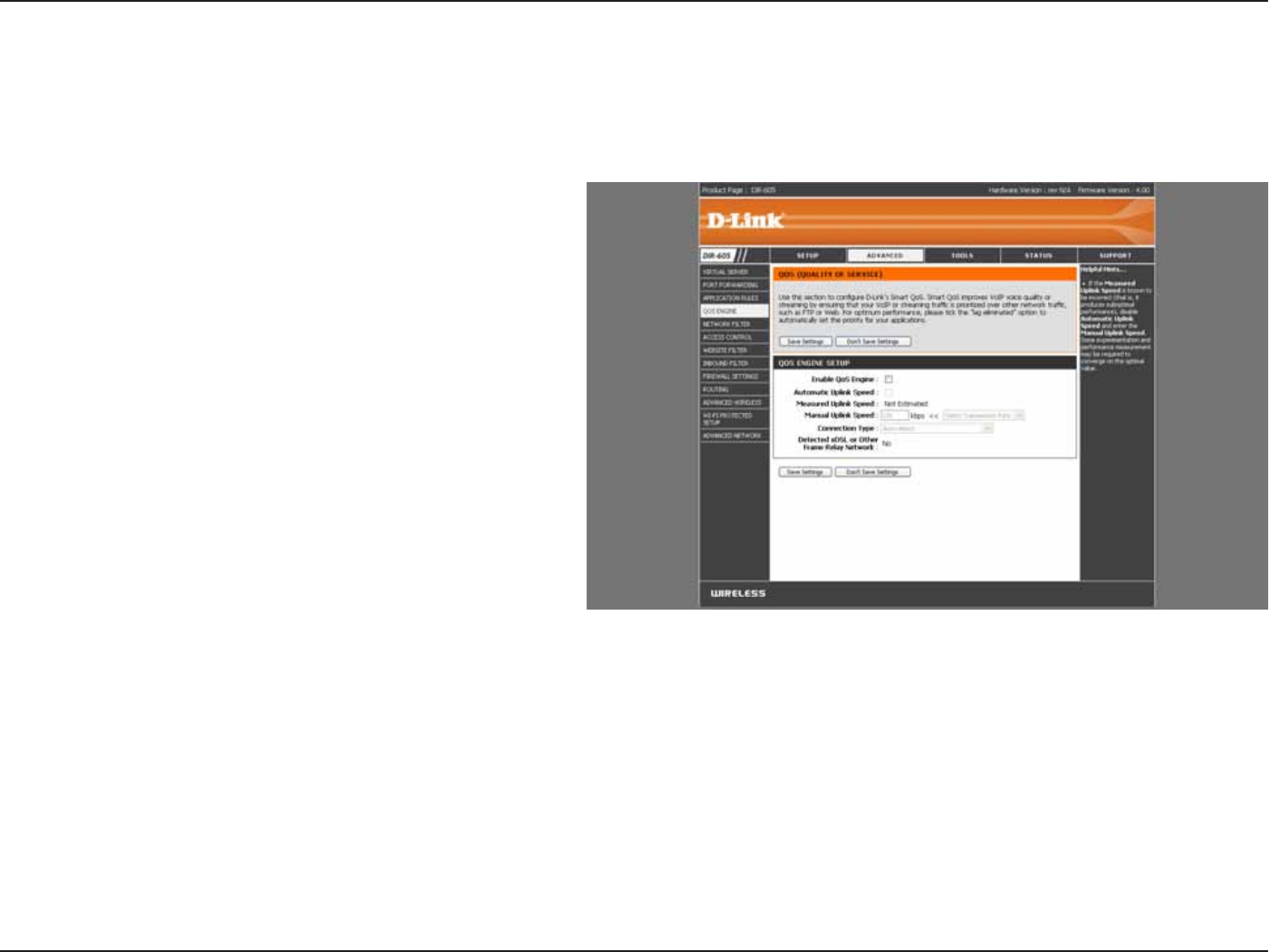
42
D-Link DIR-605 User Manual
Section 3 - Conguration
QoS Engine
This option is disabled by default. Enable this
option for better performance and experience with
online games and other interactive applications,
such as VoIP.
This option is enabled by default when the QoS
Engine option is enabled. This option will allow
your router to automatically determine the uplink
speed of your Internet connection.
This displays the detected uplink speed.
The speed at which data can be transferred from
the router to your ISP. This is determined by
your ISP. ISP’s oer speed as a download/upload
pair. For example, 1.5Mbits/284Kbits. Using this
example, you would enter 284. Alternatively you
can test your uplink speed with a service such as
www.dslreports.com.
This option allows you to select your connection
type.
This displays if xDSL or other frame relay network
has been detected.
Enable QoS Engine:
Automatic Uplink
Speed:
Measured Uplink
Speed:
Manual Uplink
Speed:
Connection Type:
Detected xDSL or
Other Frame Relay
Network:
The QoS Engine option helps improve your network gaming performance by prioritizing applications. By default the
QoS Engine settings are disabled and application priority is not classied automatically.
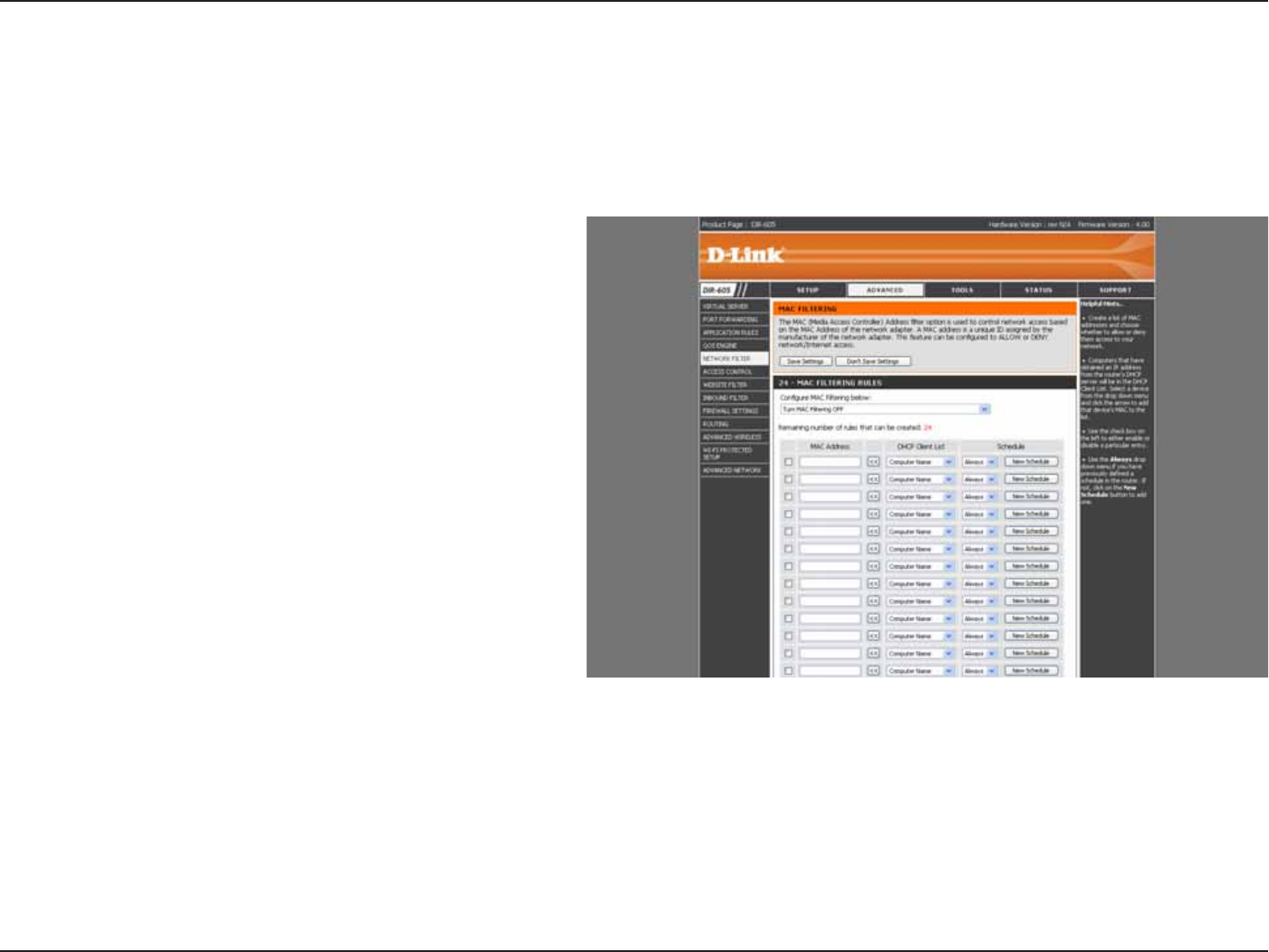
43
D-Link DIR-605 User Manual
Section 3 - Conguration
Network Filters
Select Turn MAC Filtering Off, allow MAC
addresses listed below, or deny MAC addresses
listed below from the drop-down menu.
Enter the MAC address you would like to
lter.
To nd the MAC address on a computer, please
refer to the Networking Basics section in this
manual.
Select a DHCP client from the drop-down menu
and click << to copy that MAC Address.
Select to set the new schedule.
Congure MAC
Filtering:
MAC Address:
DHCP Client:
New Schedule:
Use MAC (Media Access Control) Filters to allow or deny LAN (Local Area Network) computers by their MAC addresses
GSPNBDDFTTJOHUIF/FUXPSL:PVDBOFJUIFS NBOVBMMZBEEB ."$BEESFTTPSTFMFDUUIF."$BEESFTTGSPNUIF MJTUPG
clients that are currently connected to the Broadband Router.
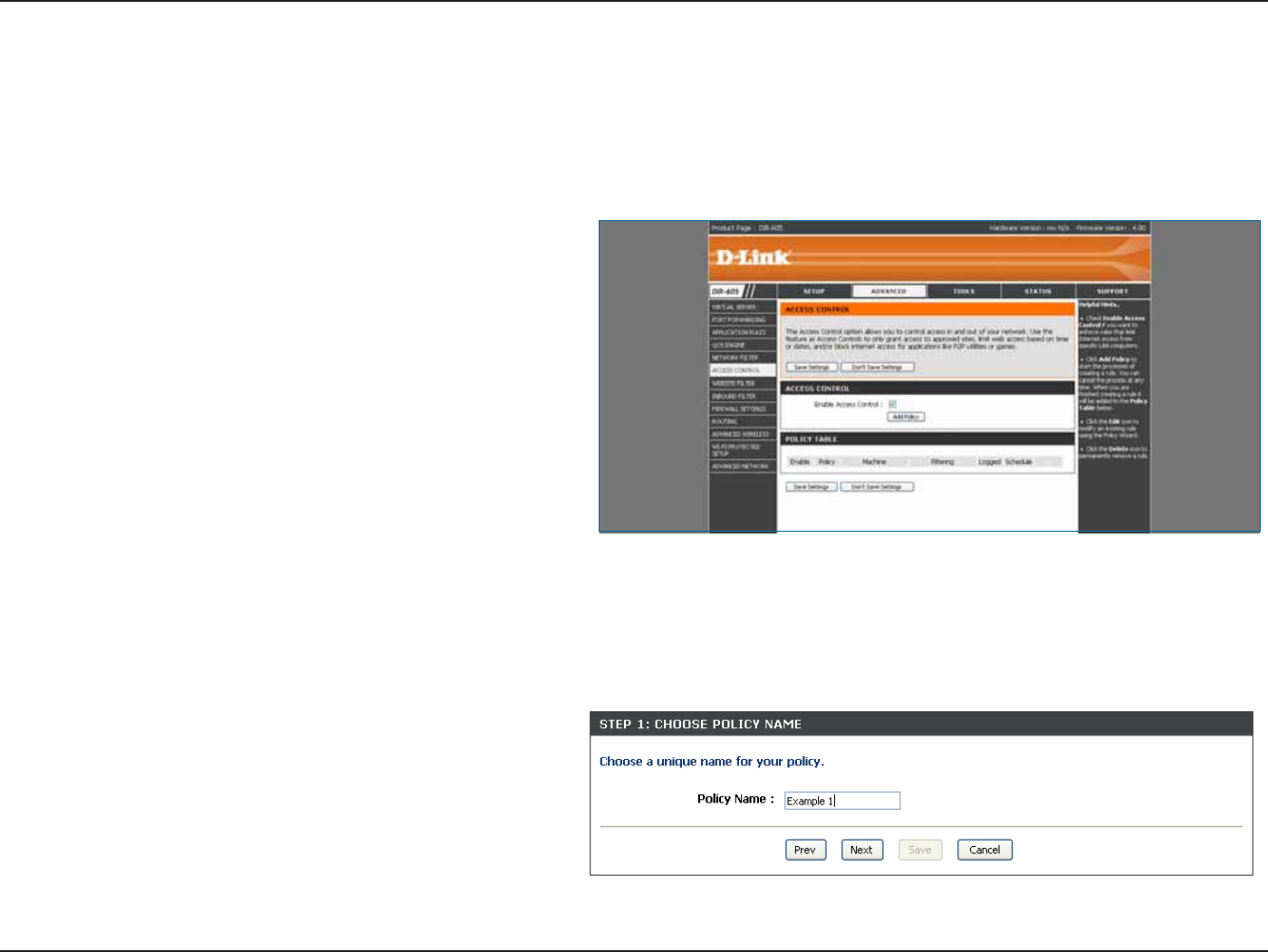
44
D-Link DIR-605 User Manual
Section 3 - Conguration
Access Control
Check the Enable Access Control check box
and click the Add Policy button to start the
Access Control Wizard.
Add Policy:
The Access Control section allows you to control access in and out of your network. Use this feature as Parental
Controls to only grant access to approved sites, limit web access based on time or dates, and/or block access from
applications like P2P utilities or games.
Click Next to continue with the wizard.
Access Control Wizard
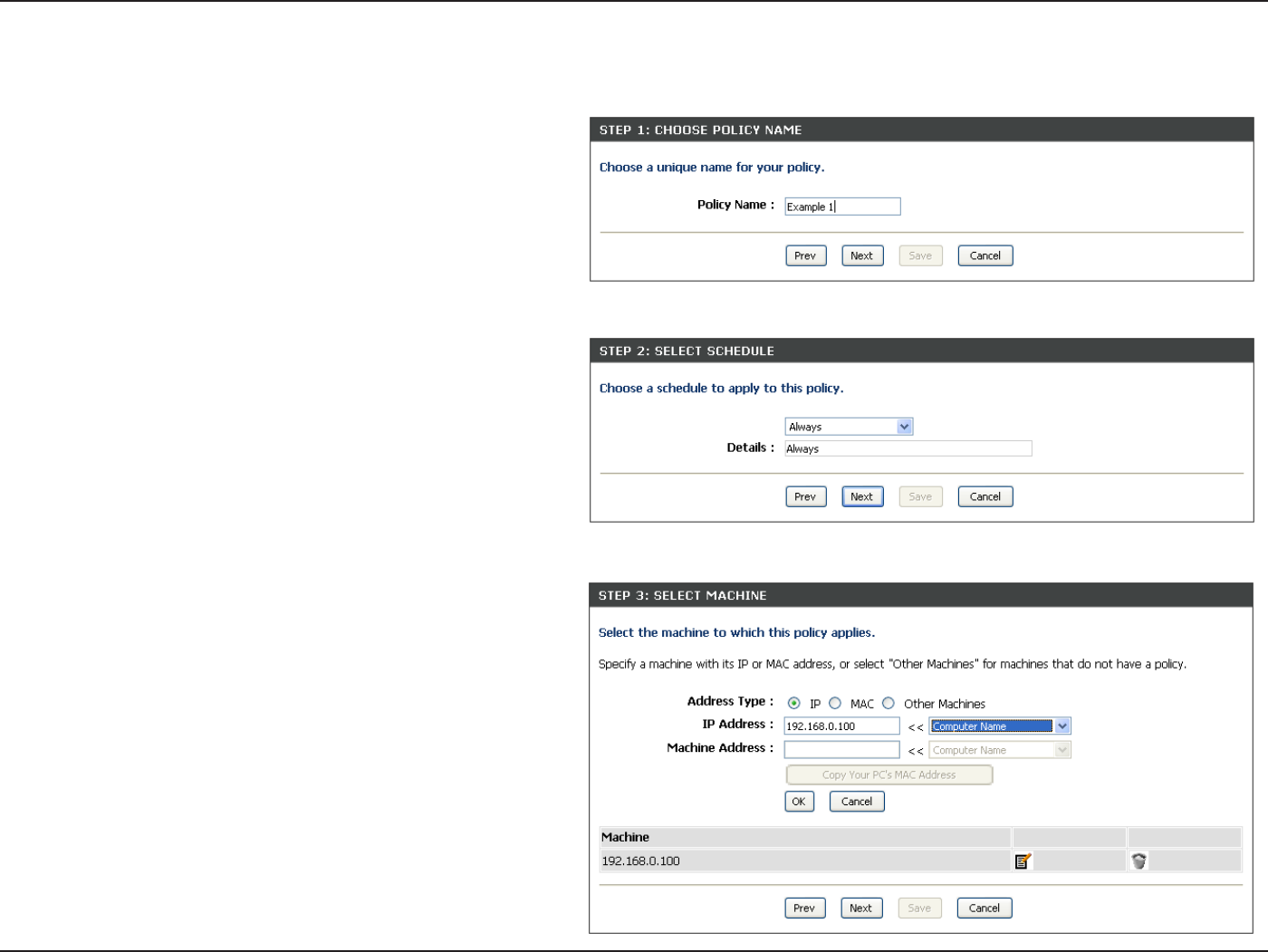
45
D-Link DIR-605 User Manual
Section 3 - Conguration
Enter a name for the policy and then click Next to continue.
Access Control Wizard (continued)
Select a schedule (I.E. Always) from the drop-down menu
and then click Next to continue.
Enter the following information and then click Next to
continue.
t"EESFTT5ZQF 4FMFDU*1 BEESFTT."$BEESFTTPS
Other Machines.
t*1"EESFTT &OUFSUIF*1 BEESFTTPG UIFDPNQVUFS
you want to apply the rule to.
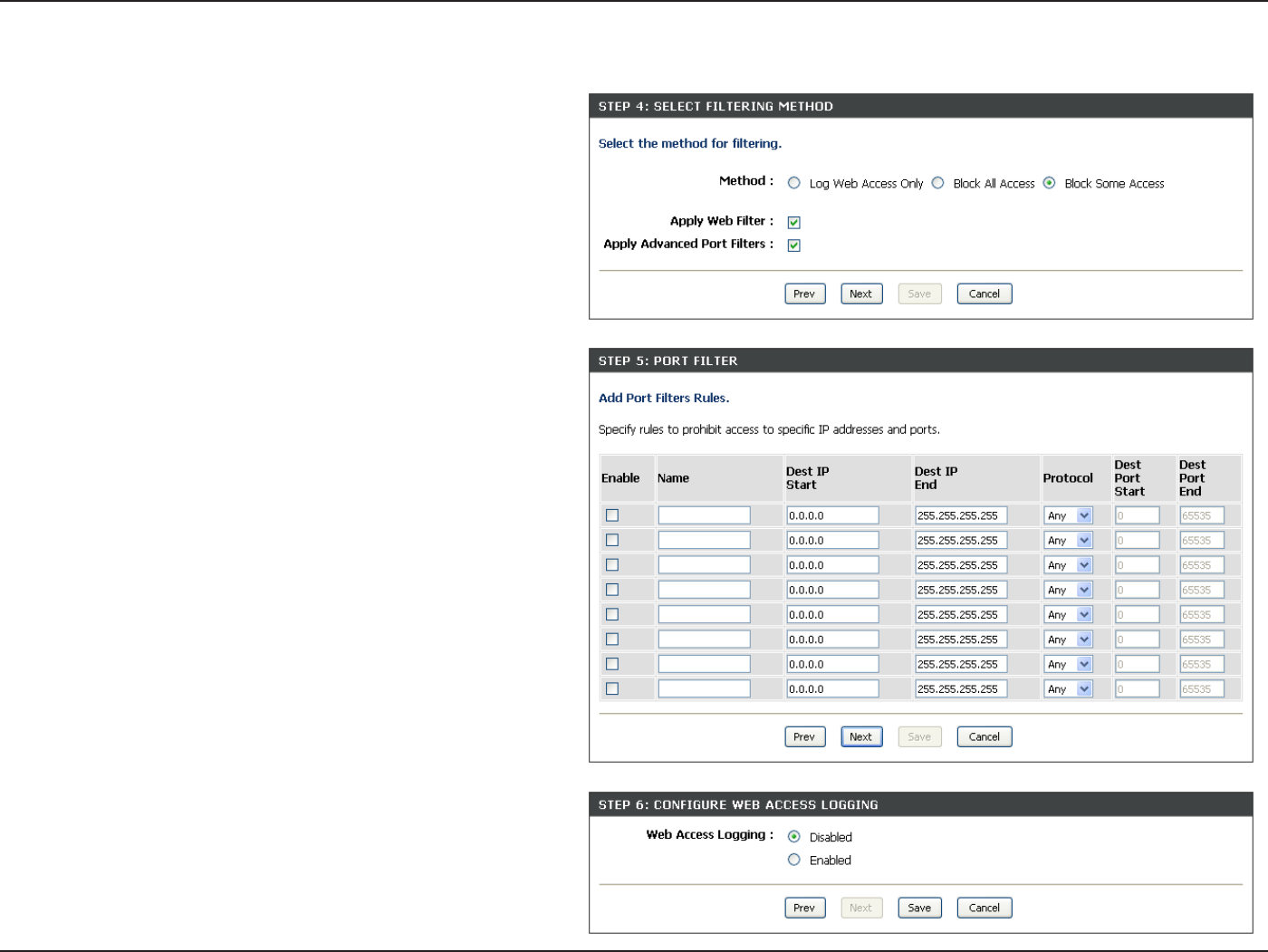
46
D-Link DIR-605 User Manual
Section 3 - Conguration
Select the ltering method and then click Next to continue.
Access Control Wizard (continued)
Enter the rule:
Enable - Check to enable the rule.
Name - Enter a name for your rule.
Dest IP Start - Enter the starting IP address.
Dest IP End - Enter the ending IP address.
Protocol - Select the protocol.
Dest Port Start - Enter the starting port number.
Dest Port End - Enter the ending port number.
To enable web logging, click Enable.
Click Save to save the access control rule.
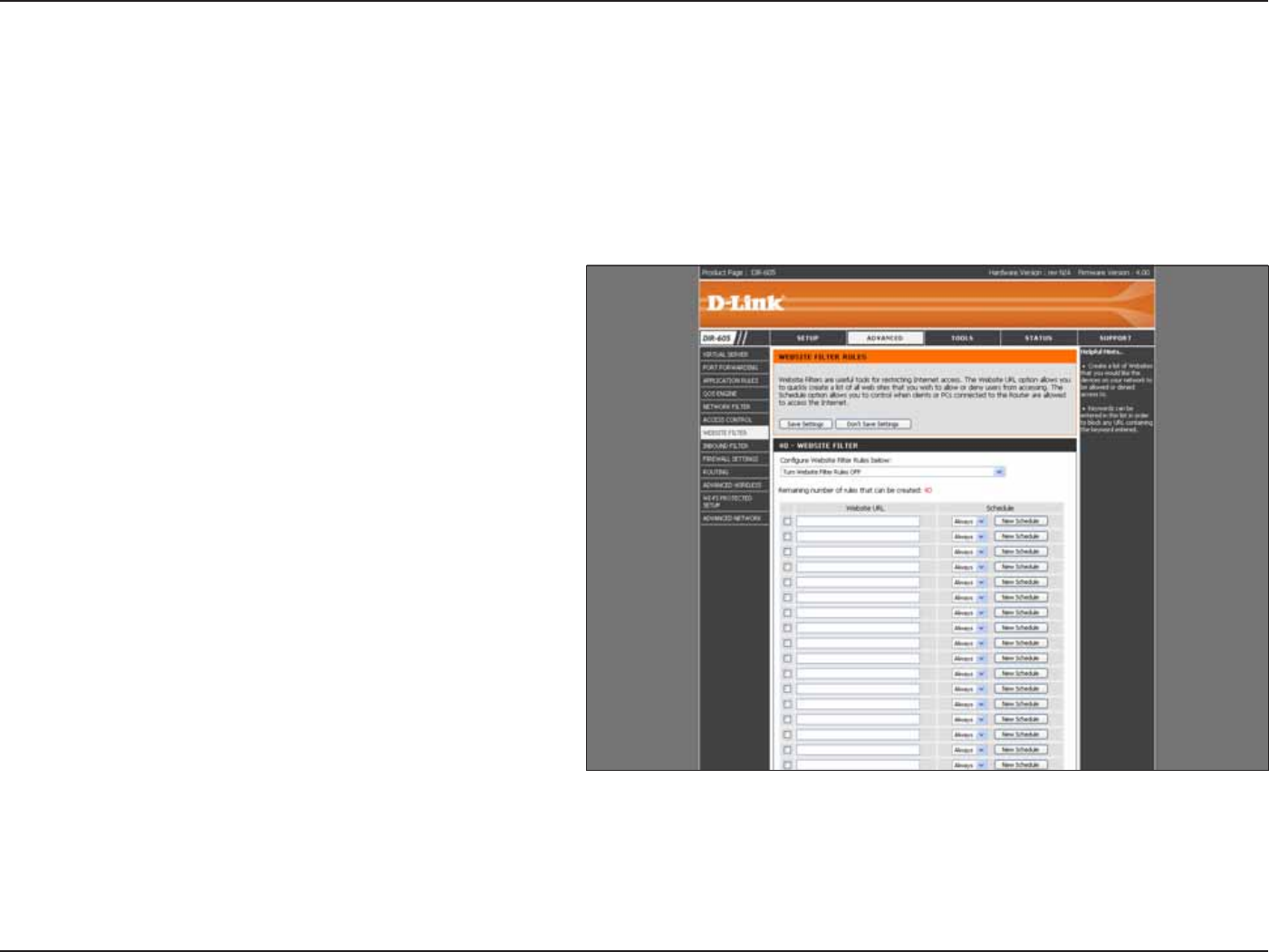
47
D-Link DIR-605 User Manual
Section 3 - Conguration
Select Deny or Allow computers access to
only these sites.
Click to delete all entries in the list.
Enter the keywords or URLs that you want to allow
or deny.
Select to set the new scheulde.
Congure Website
Filter Below:
Clear the list
below:
Website URL/
Domain:
New Schedule:
Website Filters
Website Filters are used to allow you to set up a list of allowed Web sites that can be used by multiple users through
the network. To use this feature select to Allow or Deny, enter the domain or website and click Add, and then click
Save Settings:PVNVTUBMTPTFMFDUApply Web Filter under the Access Control section (page 40).
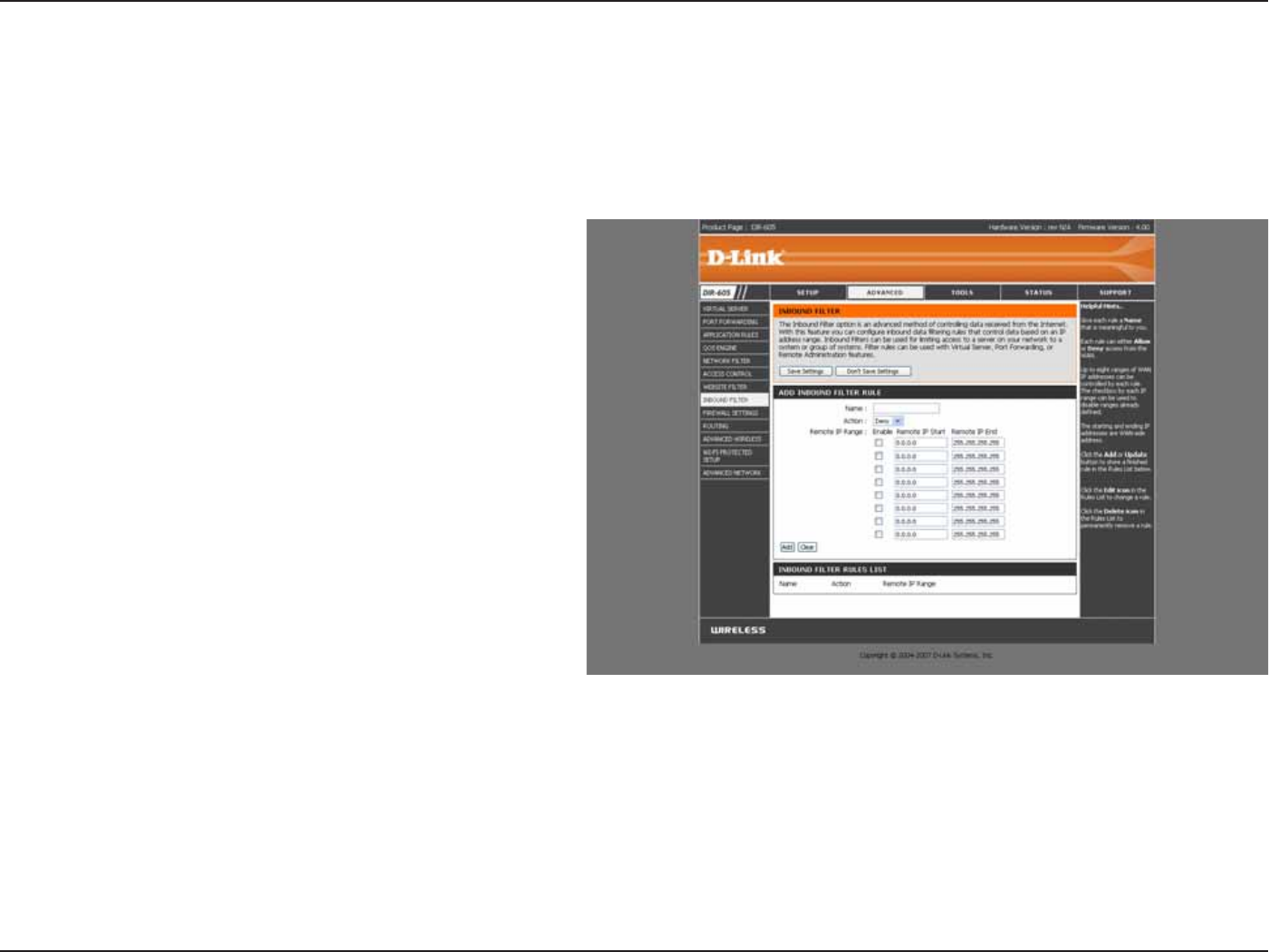
48
D-Link DIR-605 User Manual
Section 3 - Conguration
Enter a name for the inbound lter rule.
Select Allow or Deny.
Check to enable rule.
Enter the starting IP address. Enter 0.0.0.0 if
you do not want to specify an IP range.
Enter the ending IP address. Enter
255.255.255.255 if you do not want to specify
and IP range.
Click the Save button to apply your settings.
:PV NVTUDMJDL4BWF4FUUJOHTBU UIFUPQUP
save the settings.
This section will list any rules that are created.
:PV NBZDMJDL UIF Edit icon to change the
settings or enable/disable the rule, or click the
Delete icon to remove the rule.
Name:
Action:
Enable:
Source IP Start:
Source IP End:
Save:
Inbound Filter
Rules List:
The Inbound Filter option is an advanced method of controlling data received from the Internet. With this feature you
can congure inbound data ltering rules that control data based on an IP address range. Inbound Filters can be used
with Virtual Server, Port Forwarding, or Remote Administration features.
Inbound Filters
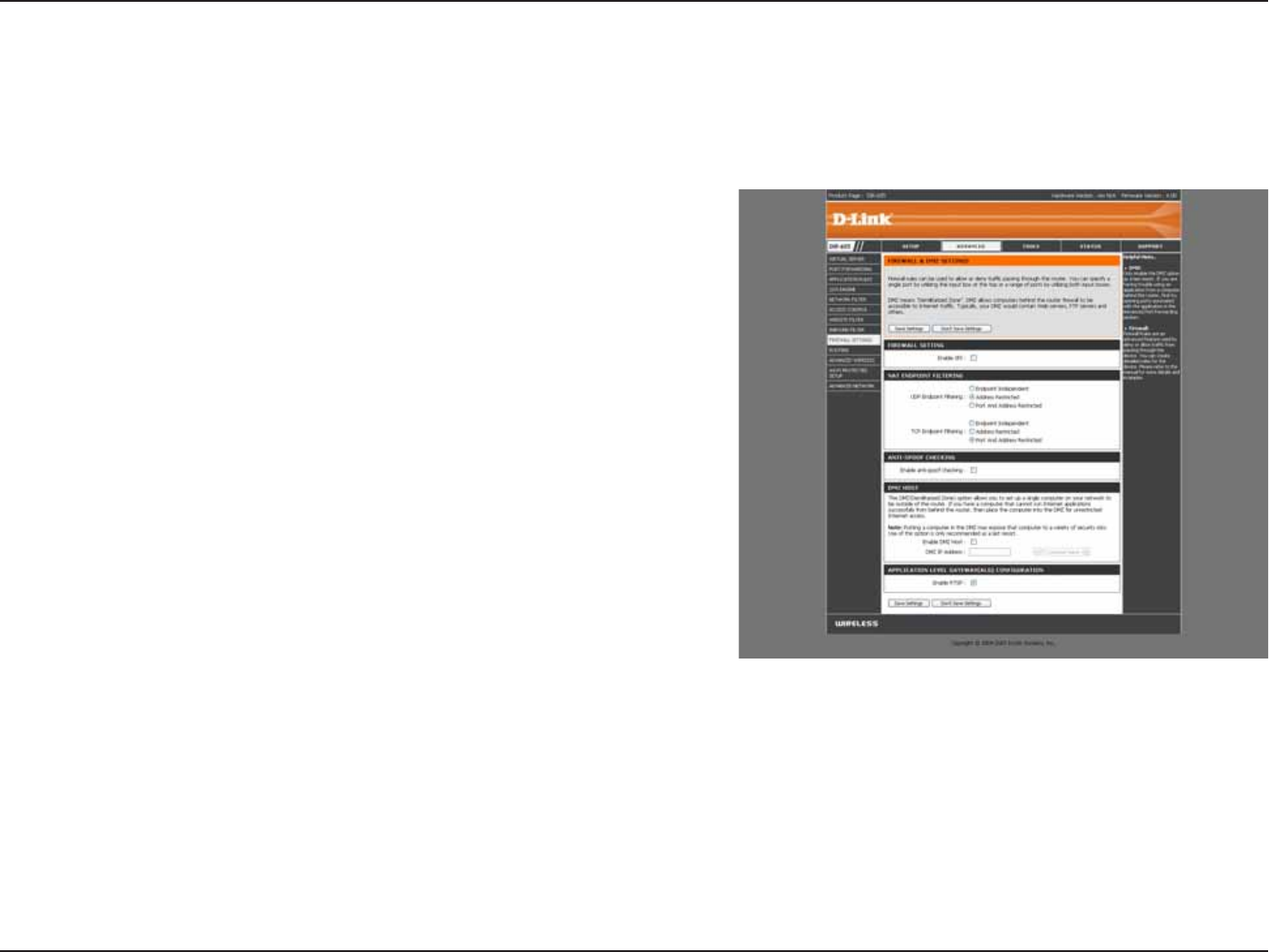
49
D-Link DIR-605 User Manual
Section 3 - Conguration
SPI (Stateful Packet Inspection, also known as dynamic packet
ltering) helps to prevent cyber attacks by tracking more state per
session. It validates that the trac passing through the session
conforms to the protocol.
Select one of the following for TCP and UDP ports:
Endpoint Independent - Any incoming trac sent to an open port
will be forwarded to the application that opened the port. The port
will close if idle for 5 minutes.
Address Restricted - Incoming trac must match the IP address of
the outgoing connection.
Address + Port Restriction - Incoming trac must match the IP
address and port of the outgoing connection.
Enable this option to provide protection from certain kinds of
“spoong” attacks.
If an application has trouble working from behind the router, you
can expose one computer to the Internet and run the application on that computer.
Note: Placing a computer in the DMZ may expose that computer to a variety of security risks. Use of this option is only
recommended as a last resort.
Specify the IP address of the computer on the LAN that you want to have unrestricted Internet communication. If this
computer obtains its IP address automatically using DHCP, be sure to make a static reservation on the System > Network
Settings page so that the IP address of the DMZ machine does not change.
Enable SPI:
NAT Endpoint
Filtering:
Enable Anti-Spoof
Checking:
Enable DMZ Host:
IP Address:
Firewall Settings
A rewall protects your network from the outside world. The D-Link DIR-605 oers a rewall type functionality. The SPI feature helps prevent cyber
attacks. Sometimes you may want a computer exposed to the outside world for certain types of applications. If you choose to expose a computer,
you can enable DMZ. DMZ is short for Demilitarized Zone. This option will expose the chosen computer completely to the outside world.
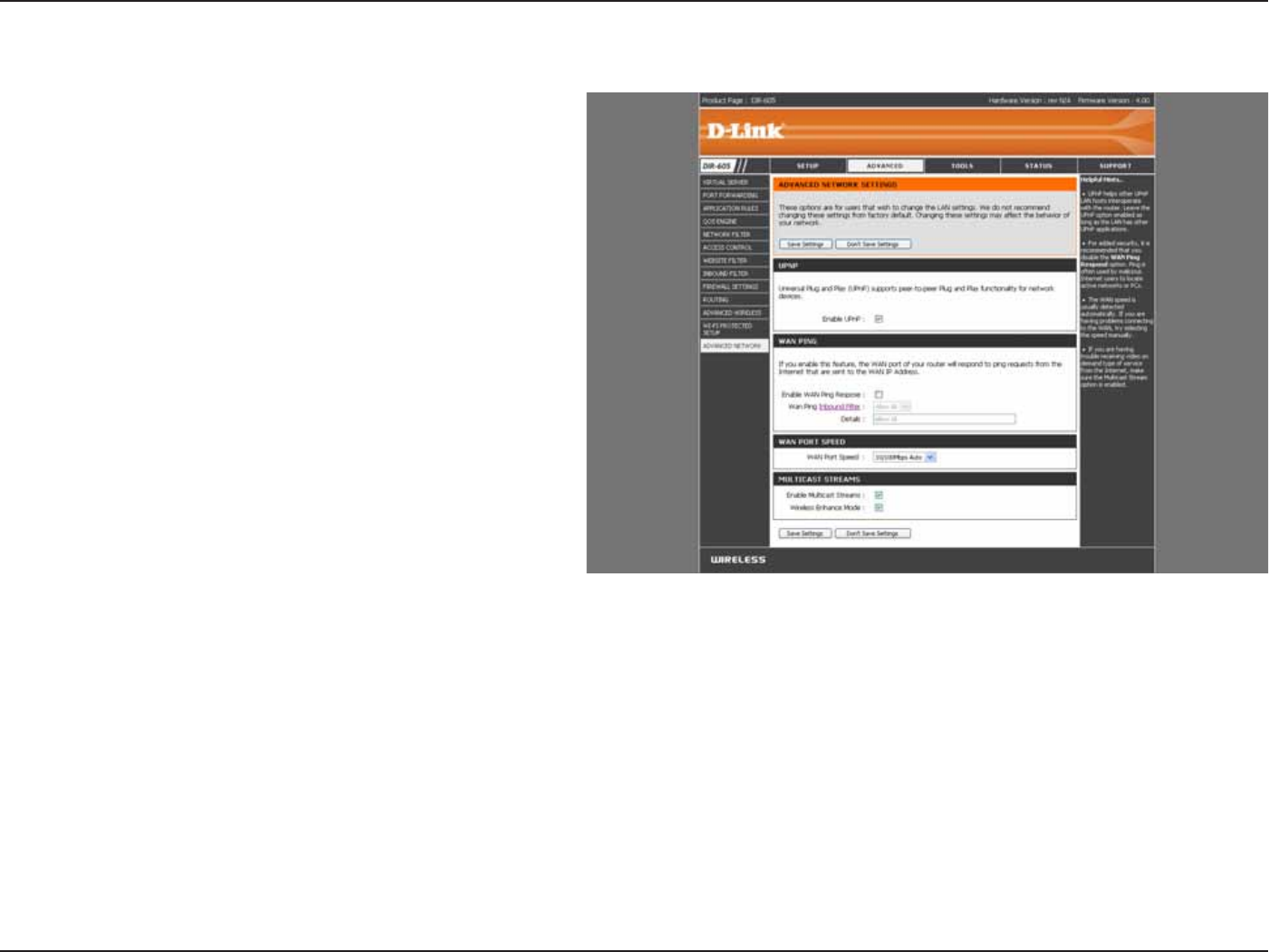
50
D-Link DIR-605 User Manual
Section 3 - Conguration
To use the Universal Plug and Play (UPnP™) feature,
click on Enabled. UPNP provides compatibility
with networking equipment, software and
peripherals.
Unchecking the box will not allow the device to
respond to pings. Blocking the ping may provide
some extra security from hackers. Check the box
to allow the Internet port to be “pinged”.
:PV NBZTFU UIFTQFFEPGUIF *OUFSOFUQPSU UP
10Mbps, 100Mbps, or auto. Older cable/DSL
modems may require you to set your port speed
to 10Mps.
Check the box to allow multicast trac to pass
through the router from the Internet.
UPnP Settings:
WAN Ping:
WAN Port Speed:
Multicast
Streams:
Advanced Network Settings (Routing)
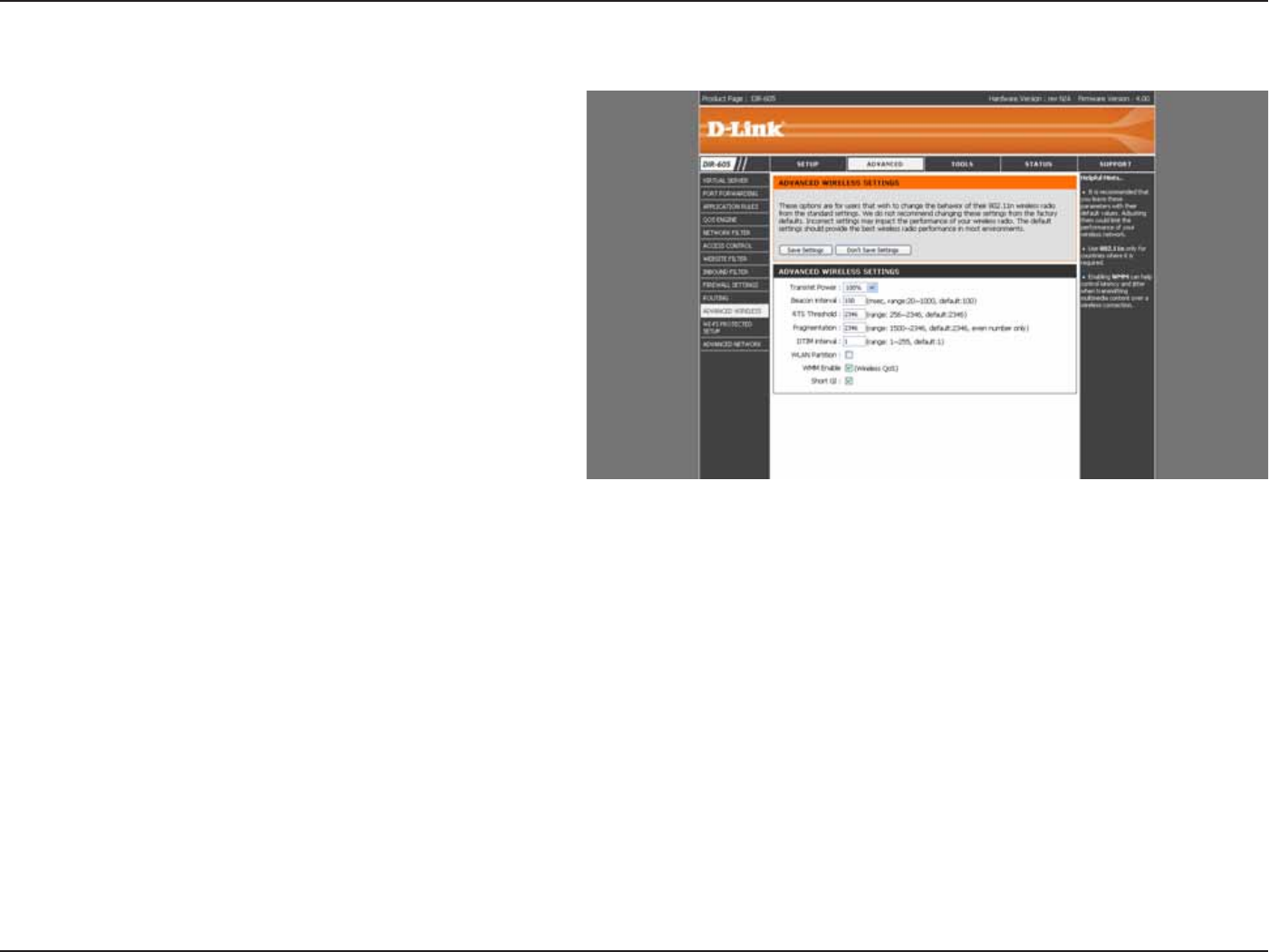
51
D-Link DIR-605 User Manual
Section 3 - Conguration
Set the transmit power of the antennas.
Beacons are packets sent by an Access Point to
synchronize a wireless network. Specify a value.
100 is the default setting and is recommended.
This value should remain at its default setting of
2432. If inconsistent data ow is a problem, only
a minor modication should be made.
The fragmentation threshold, which is specied
in bytes, determines whether packets will be
fragmented. Packets exceeding the 2346 byte
setting will be fragmented before transmission.
2346 is the default setting.
(Delivery Traffic Indication Message) 3 is
the default setting. A DTIM is a countdown informing clients of the next window for listening to broadcast and multicast
messages.
This enables 802.11d operation. 802.11d is a wireless specication developed to allow implementation of wireless networks in
countries that cannot use the 802.11 standard. This feature should only be enabled if you are in a country that requires it.
WMM is QoS for your wireless network. This will improve the quality of video and voice applications for your wireless
clients.
Check this box to reduce the guard interval time therefore increasing the data capacity. However, it’s less reliable and may
create higher data loss.
Transmit Power:
Beacon Period:
RTS Threshold:
Fragmentation
Threshold:
DTIM Interval:
WLAN Partition:
WMM Enable:
Short GI:
Advanced Wireless Settings
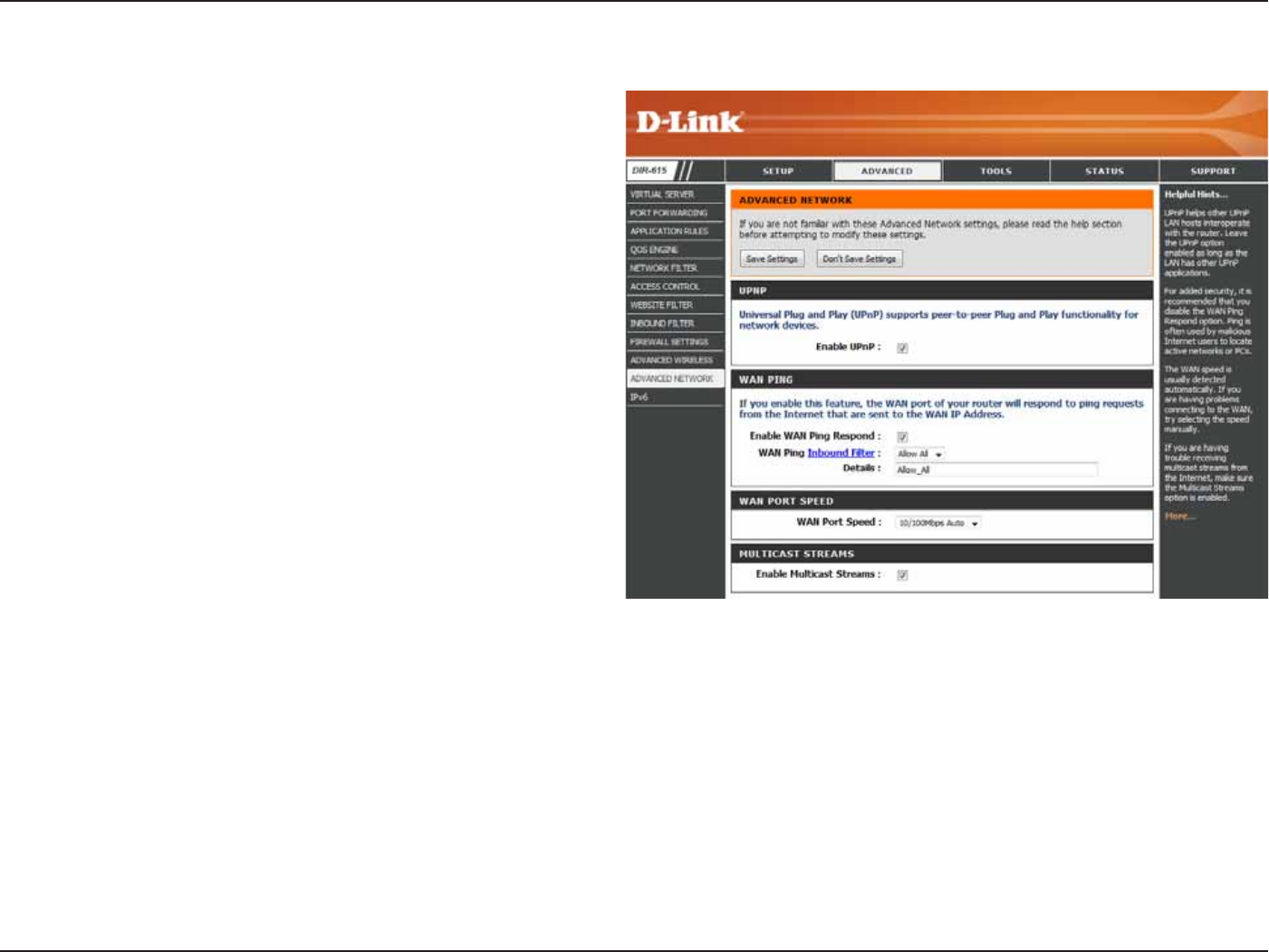
52
D-Link DIR-605 User Manual
Section 3 - Conguration
UPnP
Internet Ping Block
Internet Port Speed
Multicast Streams
To use the Universal Plug and Play (UPnP™)
feature click on Enabled. UPNP provides
compatibility with networking equipment, software
and peripherals.
Unchecking the box will not allow the DIR-605 to
respond to pings. Blocking the Ping may provide
some extra security from hackers. Check the box to
allow the Internet port to be “pinged”.
:PV NBZTFU UIFQPSUTQFFE PGUIF*OUFSOFUQPSU
to 10Mbps, 100Mbps, or auto. Some older cable
or DSL modems may require you to set the port
speed to 10Mbps.
Check the box to allow multicast traffic to pass
through the router from the Internet.
UPnP Settings:
WAN Ping:
WAN Port Speed:
Multicast
Streams:
Advanced Network Settings

53
D-Link DIR-605 User Manual
Section 3 - Conguration
My IPv6 Connection:
PPPoE:
Address Mode:
IP Address:
User Name:
Password:
Service Name:
Reconnection Mode:
Maximum Idle Time:
Select PPPoE from the drop-down menu.
Enter the PPPoE account settings supplied by your Internet provider (ISP).
Select Static if your ISP assigned you the IP address, subnet mask, gateway, and DNS server addresses. In most cases, select
Dynamic.
Enter the IP address (Static PPPoE only).
Enter your PPPoE user name.
Enter your PPPoE password and then retype the password in the next box.
Enter the ISP Service Name (optional).
Select either Always-on, On-Demand, or Manual.
Enter a maximum idle time during which the Internet connection is maintained during inactivity. To disable this feature,
enable Auto-reconnect.
Select either Obtain DNS server address automatically or Use the following DNS Address.
Enter the primary and secondary DNS server addresses.
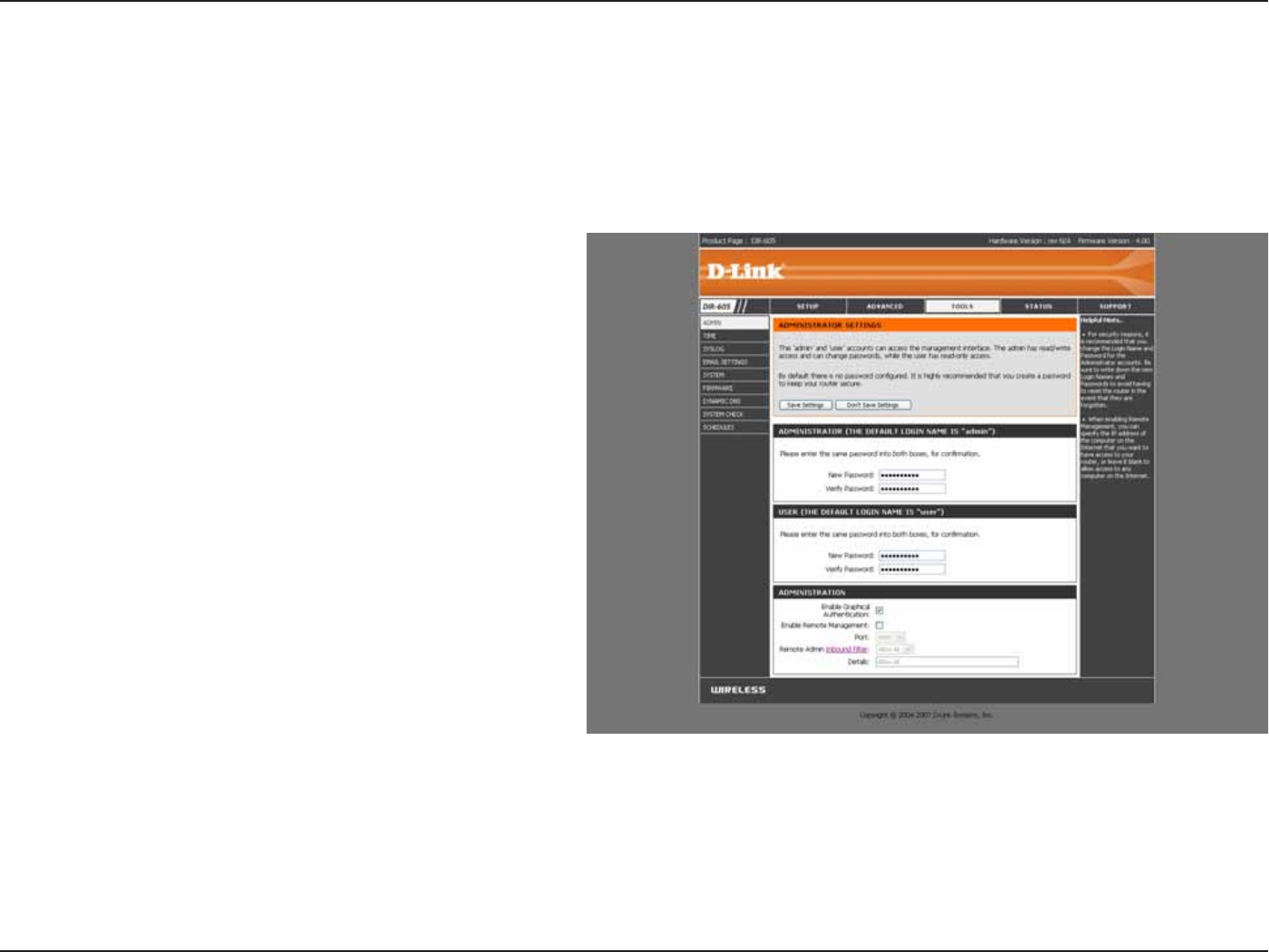
54
D-Link DIR-605 User Manual
Section 3 - Conguration
Change Password
Remote Management
Enter a new password for the Administrator Login
Name. The administrator can make changes to the
settings.
Enter the new password for the User login. If you
login as the User, you can only see the settings, but
cannot change them.
Remote management allows the DIR-605 to be
congured from the Internet by a web browser. A
username and password is still required to access
the Web-Management interface. In general, only a
member of your network can browse the built-in
web pages to perform Administrator tasks. This
feature enables you to perform Administrator tasks
from the remote (Internet) host.
The port number used to access the DIR-605.
Example: http://x.x.x.x:8080 whereas x.x.x.x is the
Internet IP address of the DIR-605 and 8080 is the
port used for the Web Management interface.
5IJTTFDUJPOXJMMMJTUBOZSVMFTUIBUBSFDSFBUFE:PVNBZDMJDLUIFEdit icon to change the settings or enable/disable the rule, or click
the ADVANCED-Inbound lter web page to congure.
The device supports this function to prevent phishing.
Admin Password:
User Password:
Remote
Management:
Remote Admin
Port:
Inbound Filter:
Enable Graphical
Authentication:
Administrator Settings
5IJTQBHFXJMMBMMPXZPVUPDIBOHF UIF"ENJOJTUSBUPSBOE6TFSQBTTXPSET:PV DBOBMTPFOBCMF 3FNPUF.BOBHFNFOU
There are two accounts that can access the management interface through the web browser. The accounts are admin
and user. Admin has read/write access while user has read-only access. User can only view the settings but cannot
make any changes. Only the admin account has the ability to change both admin and user account passwords.
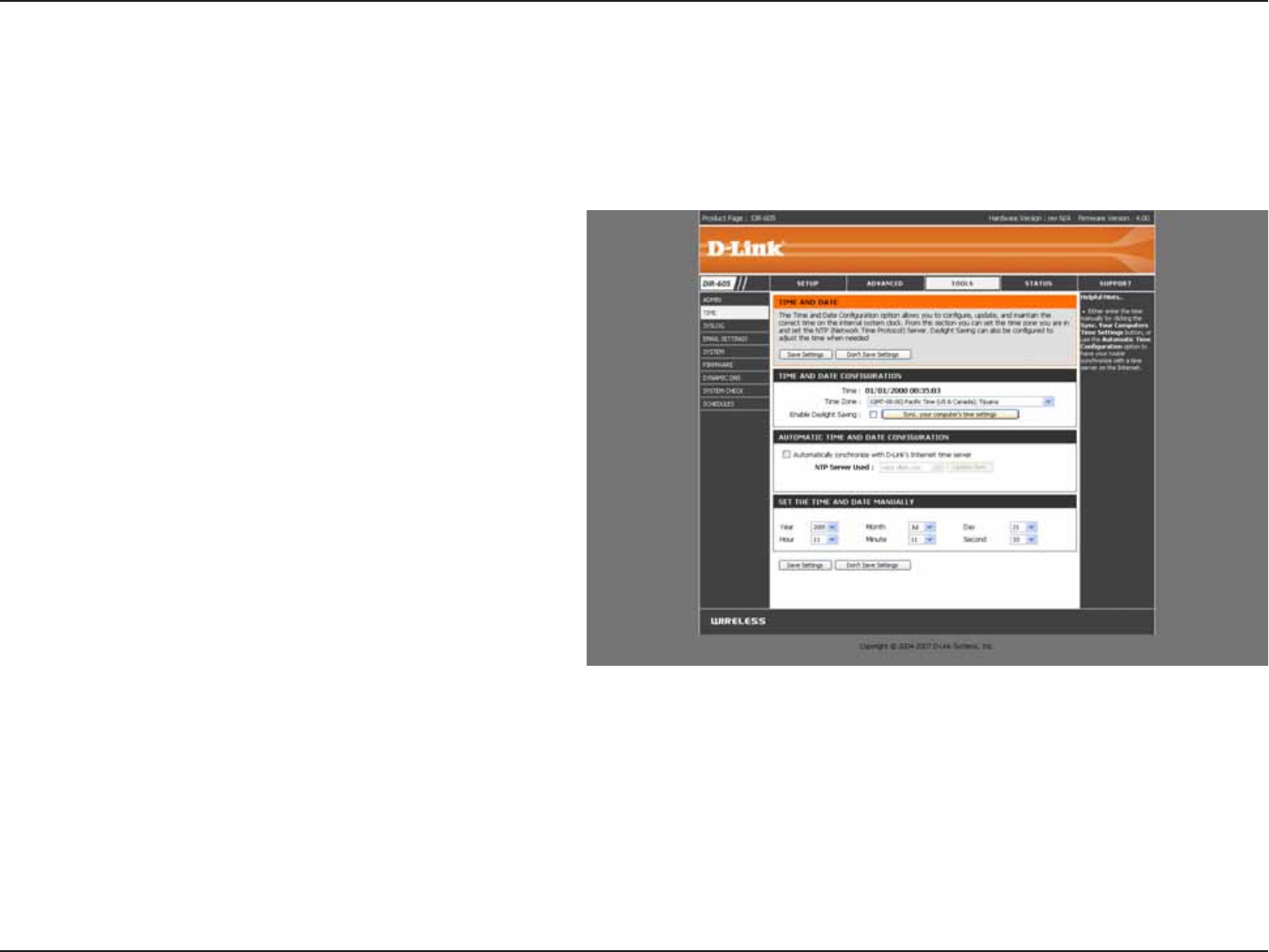
55
D-Link DIR-605 User Manual
Section 3 - Conguration
Time Settings
Select the Time Zone from the drop-down
menu.
To select Daylight Saving time manually, select
enabled or disabled, and enter a start date and
an end date for daylight saving time.
Press this button to set the device’s time the same
to local PC.
NTP is short for Network Time Protocol. NTP
synchronizes computer clock times in a network
of computers. Check this box to use a NTP server.
This will only connect to a server on the Internet,
not a local server.
Enter the NTP server or select one from the drop-
down menu, then the DIR-605 will sync the same
time to D-Link Internet time server.
To manually input the time, enter the values in
UIFTFöFMETGPSUIF:FBS.POUI%BZ)PVS.JOVUF
and Second and then click Set Time.
Time Zone:
Daylight Saving:
Sync your
Computer’s Time
Settings:
Enable NTP
Server:
NTP Server Used:
Manual:
The Time Conguration option allows you to congure, update, and maintain the correct time on the internal system
clock. From this section you can set the time zone that you are in and set the Time Server. Daylight Saving can also
be congured to automatically adjust the time when needed.
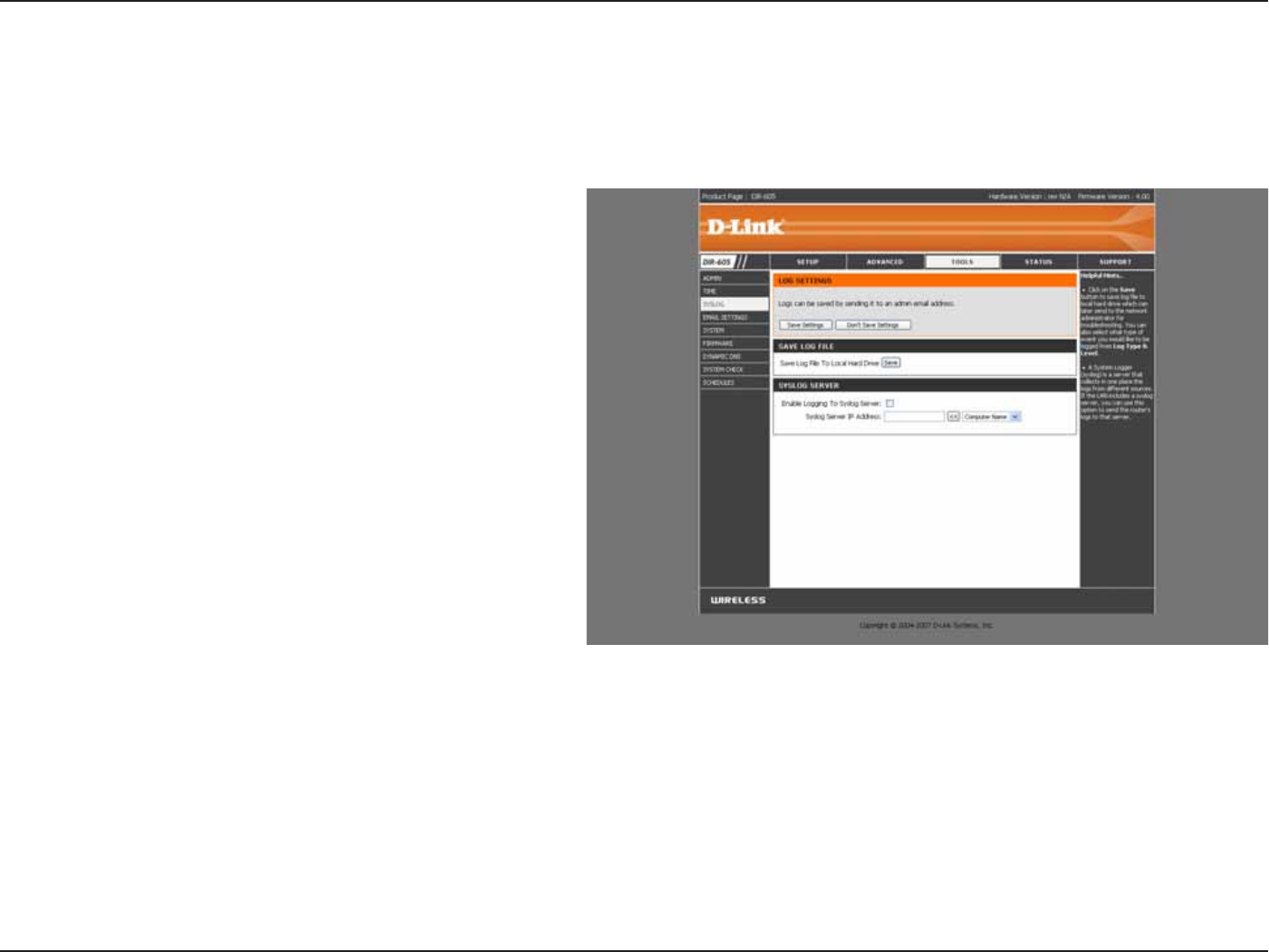
56
D-Link DIR-605 User Manual
Section 3 - Conguration
SysLog
5IF#SPBECBOE3PVUFSLFFQTBSVOOJOHMPHPGFWFOUTBOEBDUJWJUJFTPDDVSSJOHPOUIF 3PVUFS:PVNBZTFOE UIFTFMPHT
to a SysLog server on your network.
Save Log Files to
Local Hard Drive:
Enable Logging to
SysLog Server:
SysLog Server IP
Address:
Click on the Save button to save log le to local
hard drive which can later send to the network
administrator for troubleshooting.
Check this box to send the router logs to a SysLog
Server.
The address of the SysLog server that will be
VTFEUPTFOEUIFMPHT:PVNBZBMTPTFMFDU
your computer from the drop-down menu (only
if receiving an IP address from the router via
DHCP).
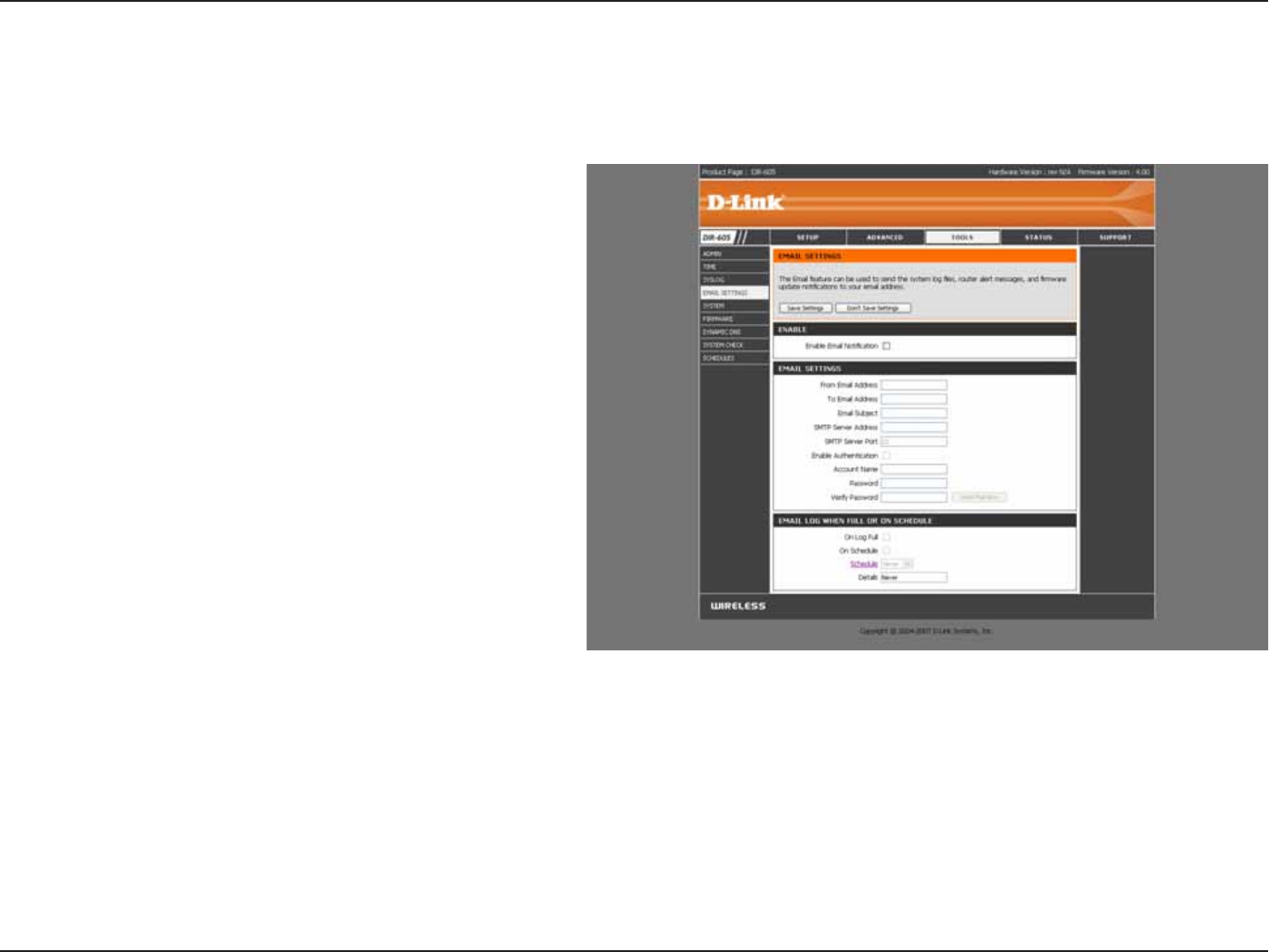
57
D-Link DIR-605 User Manual
Section 3 - Conguration
E-mail Settings
The Email feature can be used to send the system log files, router alert messages, and firmware update notification
to your e-mail address.
Enable Email
Notication:
From Email
Address:
To Email Address:
SMTP Server
Address:
Enable
Authentication:
Account Name:
Password:
On Log Full:
On Schedule:
Schedule:
When this option is enabled, router activity logs are
e-mailed to a designated e-mail address.
This e-mail address will appear as the sender
when you receive a log le or rmware upgrade
notication via e-mail.
Enter the e-mail address where you want the e-mail
sent.
Enter the SMTP server address for sending
e-mail. If your SMTP server requires authentication,
select this option.
Check this box if your SMTP server requires
authentication.
Enter your account for sending e-mail.
Enter the password associated with the account.
Re-type the password associated with the
account.
When this option is selected, logs will be sent via e-mail when the log is full.
Selecting this option will send the logs via e-mail according to schedule.
5IJTPQUJPOJTFOBCMFEXIFO0O4DIFEVMFJTTFMFDUFE:PVDBOTFMFDUBTDIFEVMFGSPNUIFMJTUPGEFöOFETDIFEVMFT5PDSFBUFBTDIFEVMF
go to Tools > Schedules.
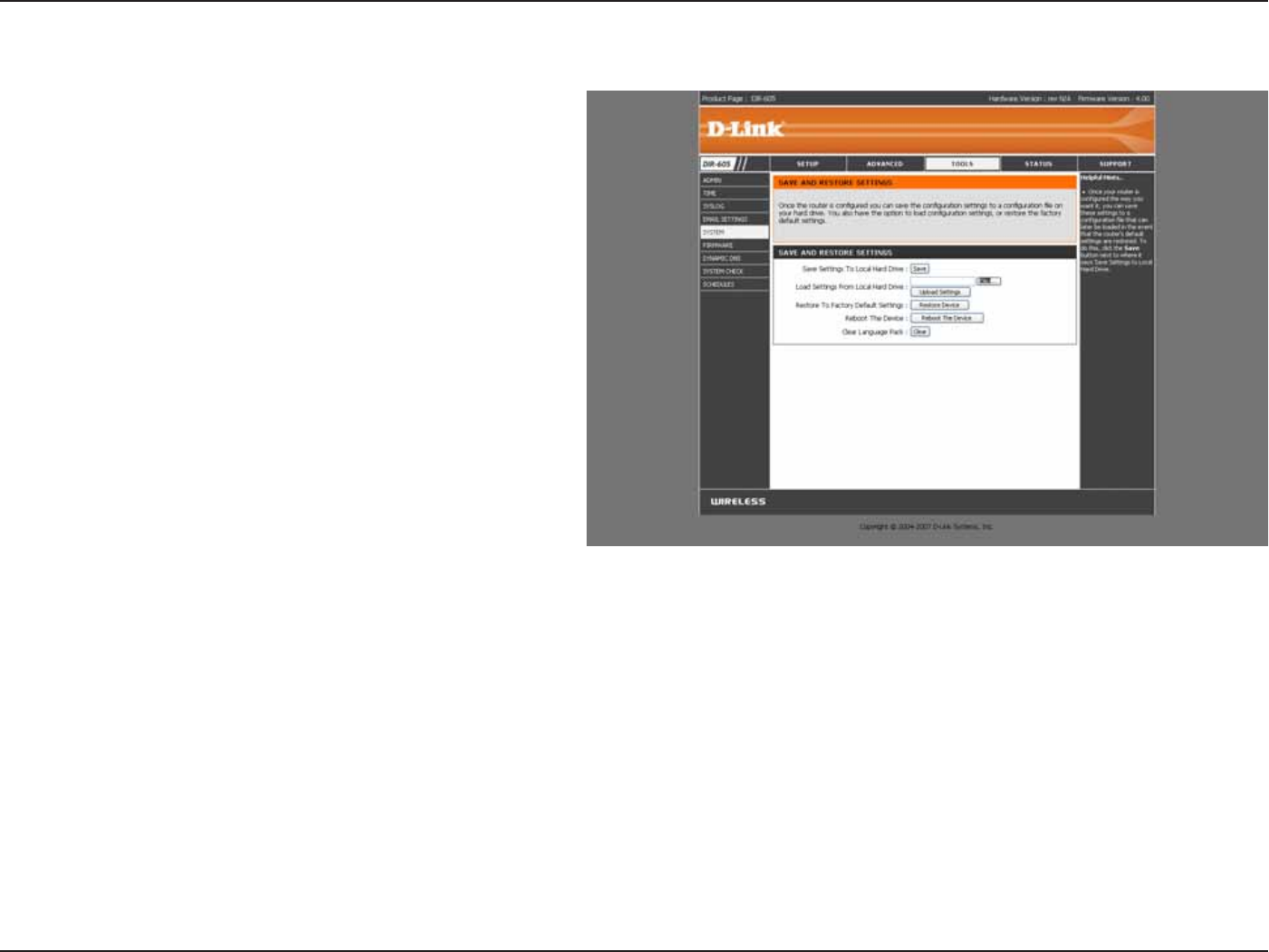
58
D-Link DIR-605 User Manual
Section 3 - Conguration
Use this option to save the current router
conguration settings to a le on the hard disk
of the computer you are using. First, click the
SaveCVUUPO:PVXJMM UIFOTFFBGJMF EJBMPH
where you can select a location and le name
for the settings.
Use this option to load previously saved
router configuration settings. First, use the
Browse control to find a previously save file
of configuration settings. Then, click the Load
button to transfer those settings to the router.
This option will restore all conguration settings
back to the settings that were in effect at the
time the router was shipped from the factory.
Any settings that have not been saved will be
lost, including any rules that you have created. If
you want to save the current router conguration
settings, use the Save button above.
Click to reboot the router.
This is to restore the device back to English version
only. Remove other languages installed for the
system web pages.
Save Settings to
Local Hard Drive:
Load Settings
from Local Hard
Drive:
Restore to Factory
Default Settings:
Reboot Device:
Clear Language
Pack:
System Settings
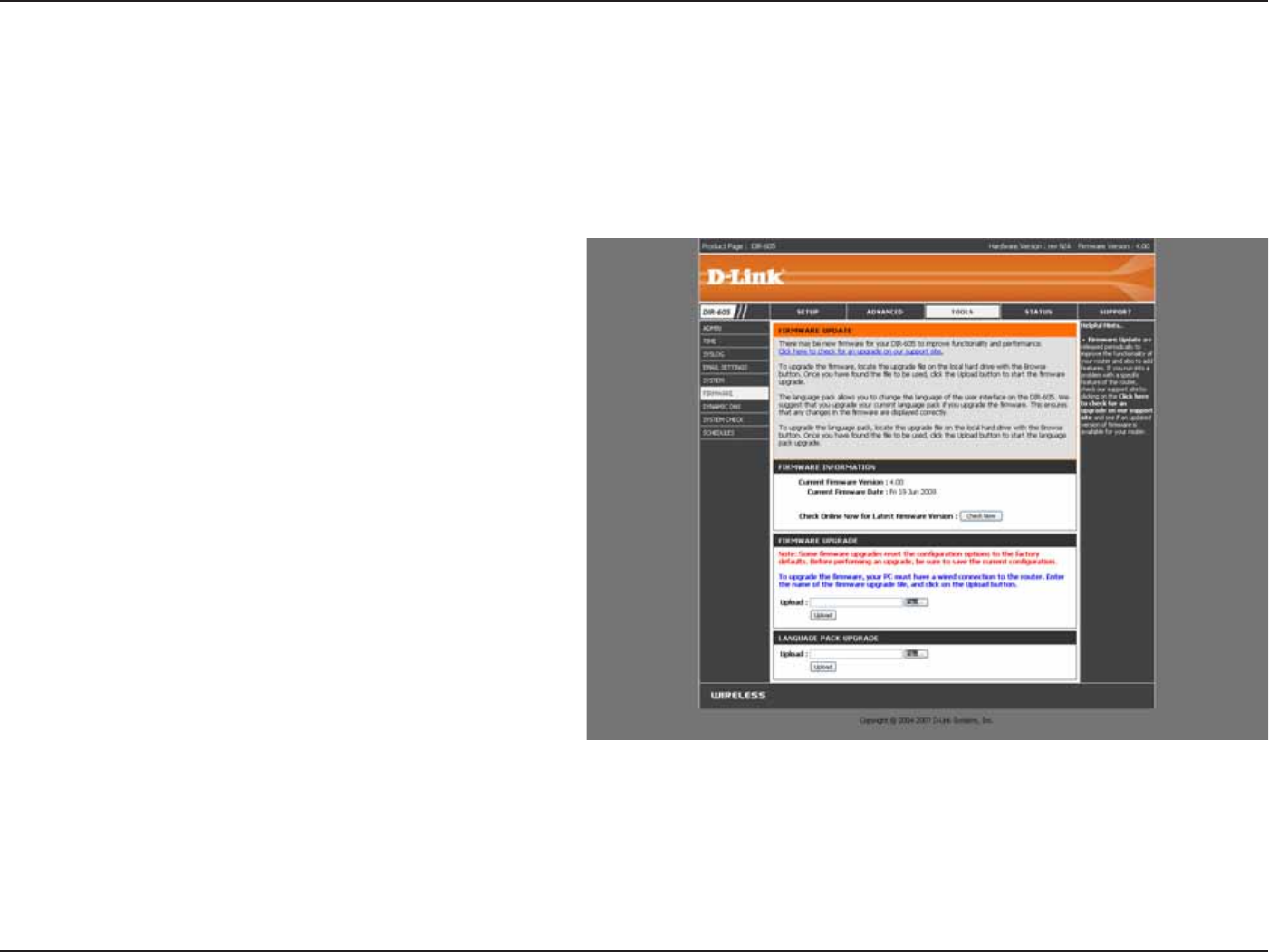
59
D-Link DIR-605 User Manual
Section 3 - Conguration
Displays the current rmware version and date.
:PV DBOBMTPDIFDL UIF BWBJMBCJMJUZPGB OFX
rmware version online. If so, download the new
rmware to your hard drive.
After you have downloaded the new rmware,
click Browse to locate the rmware update on
your hard drive. Click Upload to complete the
rmware upgrade.
This function allows the user to transfer the
language of GUI from English to theirs by upgrading
the language pack.
Firmware
Information:
Firmware
Upgrade:
Language Pack
Upgrade:
Update Firmware
:PVDBOVQHSBEFUIF öSNXBSFPGUIF 3PVUFSIFSF.BLF TVSFUIFöSNXBSFZPVXBOU UPVTFJTPO UIFMPDBMIBSEESJWFPG
the computer. Click on Browse to locate the rmware le to be used for the update. Please check the D-Link support
TJUFGPSöSNXBSFVQEBUFTBUIUUQTVQQPSUEMJOLDPN:PVDBO EPXOMPBEöSNXBSFVQHSBEFTUPZPVSIBSEESJWFGSPNUIF
D-Link support site.
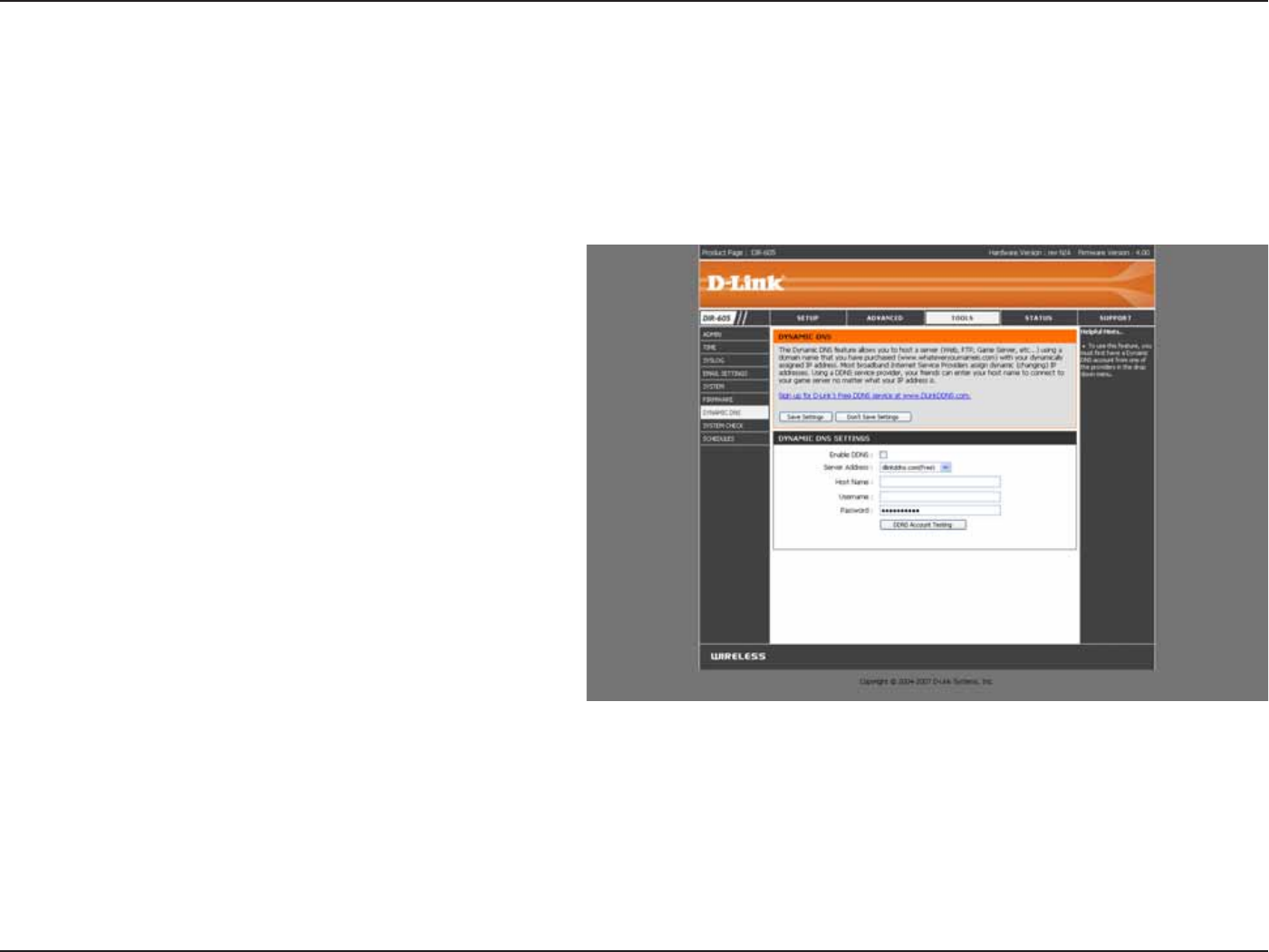
60
D-Link DIR-605 User Manual
Section 3 - Conguration
Dynamic Domain Name System is a method of
keeping a domain name linked to a changing IP
Address. Check the box to enable DDNS.
Choose your DDNS provider from the drop
down menu.
Enter the Host Name that you registered with
your DDNS service provider.
Enter the Username for your DDNS account.
Enter the Password for your DDNS account.
This is to test if the DDNS account is valid for use.
DDNS:
Server Address:
Host Name:
Username or Key:
Password or Key:
DDNS Account
Testing:
DDNS
The DDNS feature allows you to host a server (Web, FTP, Game Server, etc…) using a domain name that you have
purchased (www.whateveryournameis.com) with your dynamically assigned IP address. Most broadband Internet
Service Providers assign dynamic (changing) IP addresses. Using a DDNS service provider, your friends can enter in
your domain name to connect to your server no matter what your IP address is.
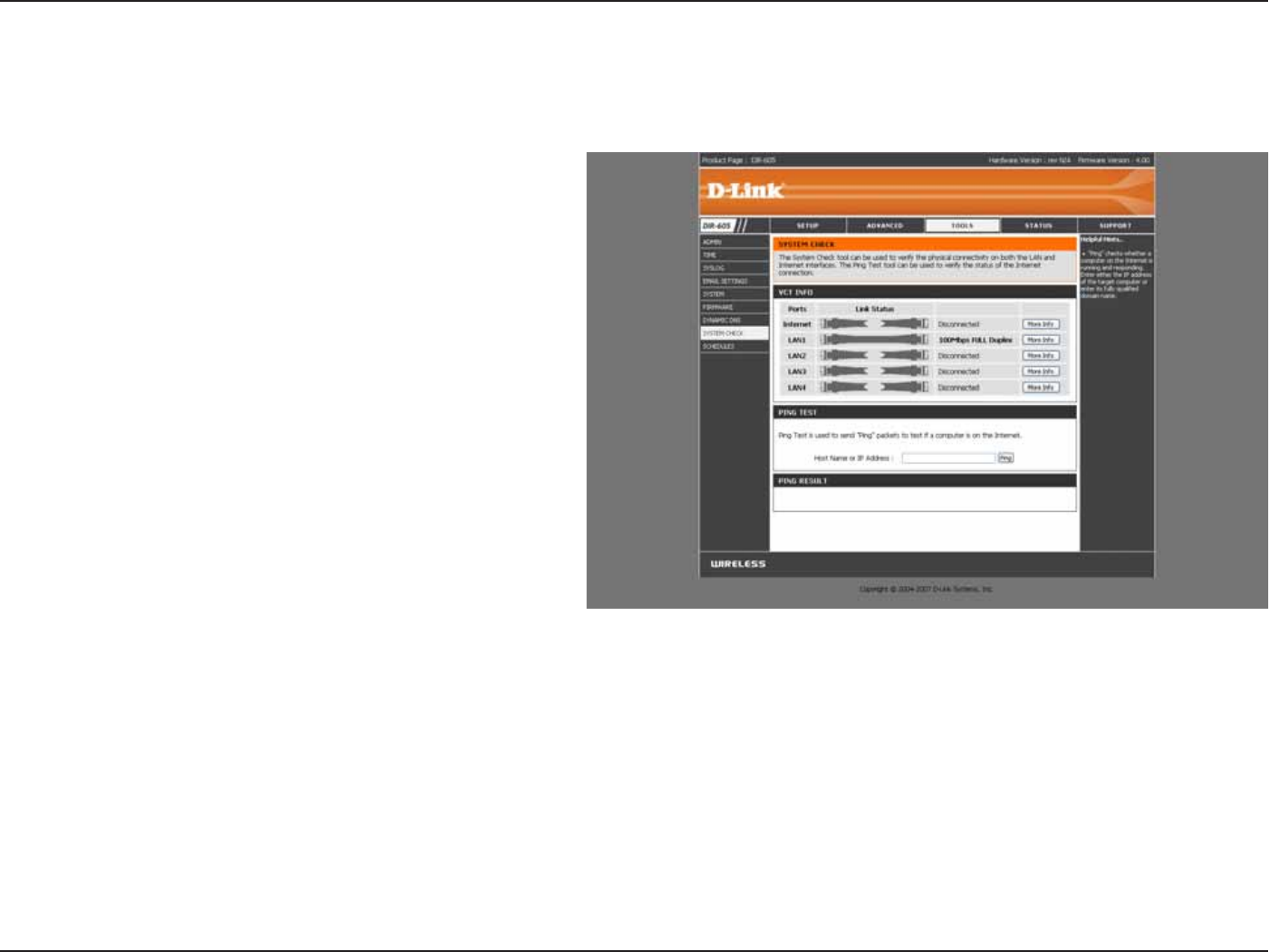
61
D-Link DIR-605 User Manual
Section 3 - Conguration
The Ping Test is used to send Ping packets
to test if a computer is on the Internet. Enter
the IP Address that you wish to Ping, and
click Ping.
The results of your ping attempts will be
displayed here.
The System Check tool can be used to verify
the physical connectivity on both the LAN and
Internet interfaces.
Ping Test:
Ping Results:
System Check:
The System Check feature allows you to verify the physical connectivity on both LAN and Internet interface.
System Check
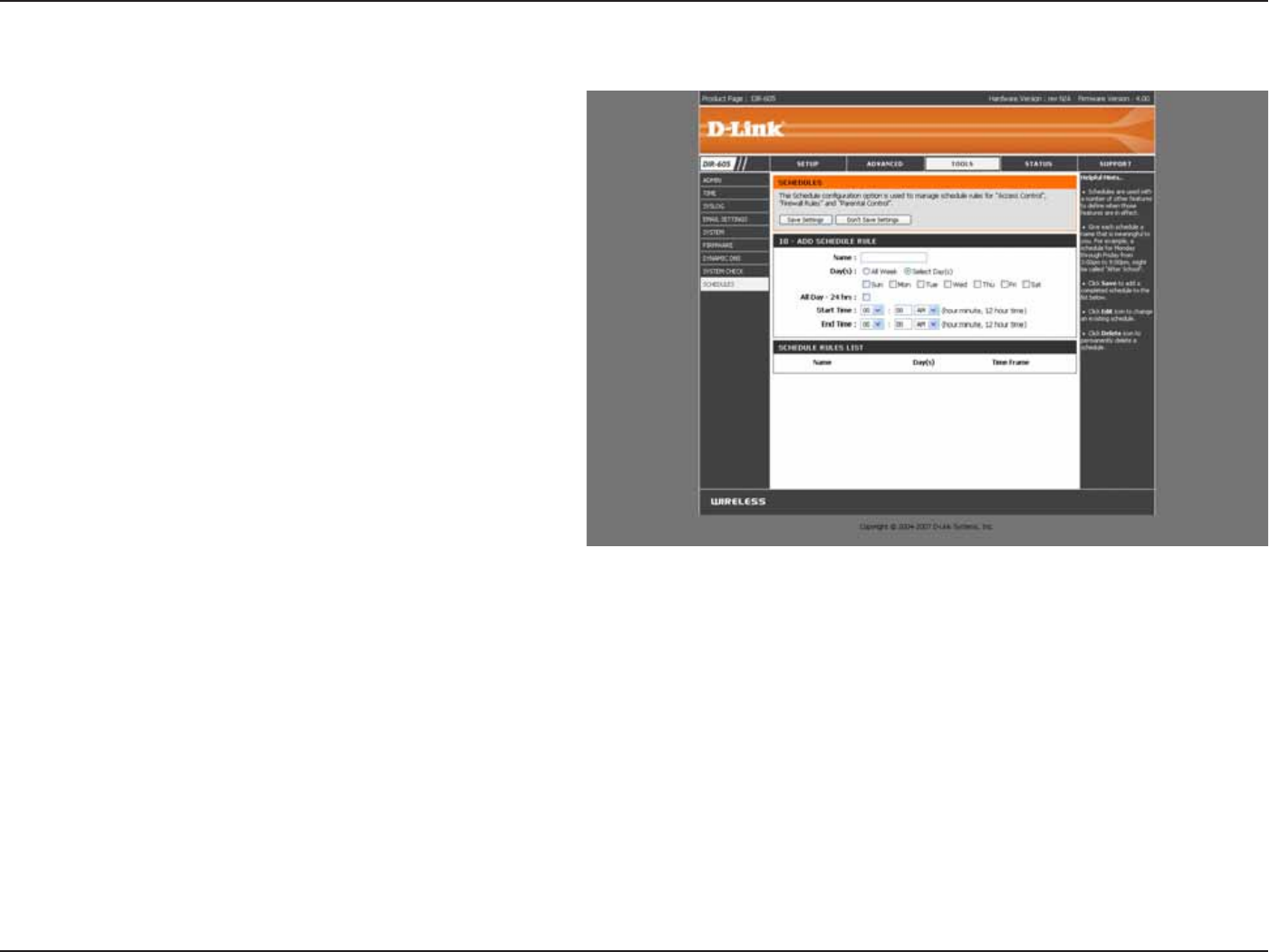
62
D-Link DIR-605 User Manual
Section 3 - Conguration
Enter a name for your new schedule.
Select a day, a range of days, or All Week to
include every day.
Check All Day - 24hrs or enter a start and
end time for your schedule.
Click Save UP TBWF ZPVS TDIFEVMF :PV
must click Save Settings at the top for your
schedules to go into eect.
The list of schedules will be listed here. Click
the Edit icon to make changes or click the
Delete icon to remove the schedule.
Name:
Days:
Time:
Save:
Schedule Rules
List:
Schedules
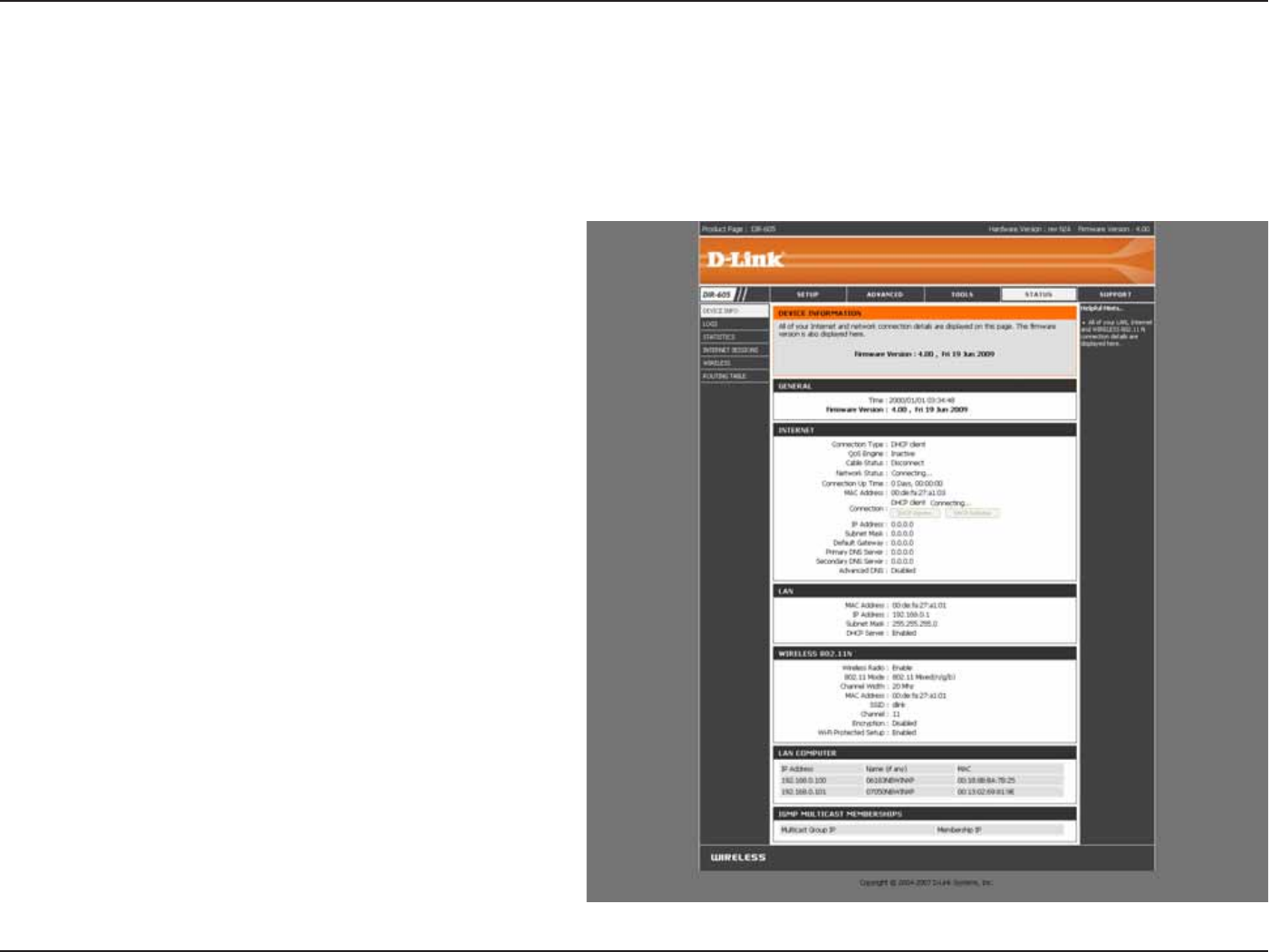
63
D-Link DIR-605 User Manual
Section 3 - Conguration
This page displays the current information for the DIR-605. It will display the LAN, WAN (Internet), and Wireless information.
If your Internet connection is set up for a Dynamic IP address then a Release button and a Renew button will be
displayed. Use Release to disconnect from your ISP and use Renew to connect to your ISP.
If your Internet connection is set up for PPPoE, a Connect
button and a Disconnect button will be displayed. Use
Disconnect to drop the PPPoE connection and use
Connect to establish the PPPoE connection.
See the following page for more information.
Device Information
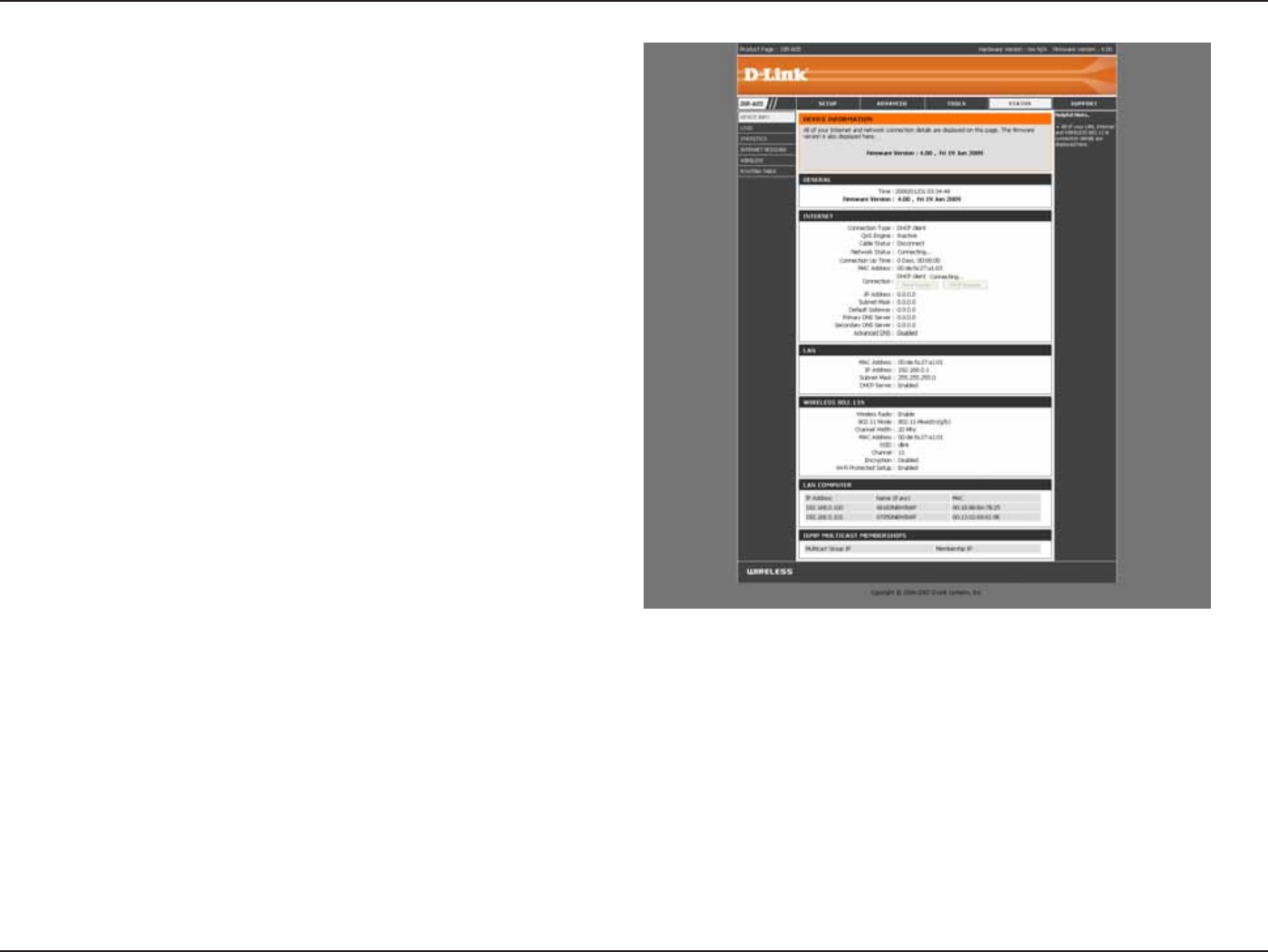
64
D-Link DIR-605 User Manual
Section 3 - Conguration
Displays the router’s time and rmware version.
Displays the MAC address and the public IP
settings for the router.
Displays the MAC address and the private (local)
IP settings for the router.
Displays the wireless MAC address and your
wireless settings such as SSID and Channel.
Displays computers and devices that are connected
to the router via Ethernet and that are receiving an
IP address assigned by the router (DHCP).
Displays the Multicast Group IP Address.
General:
Internet:
LAN:
Wireless LAN:
LAN Computers:
IGMP Multicast
Memberships:
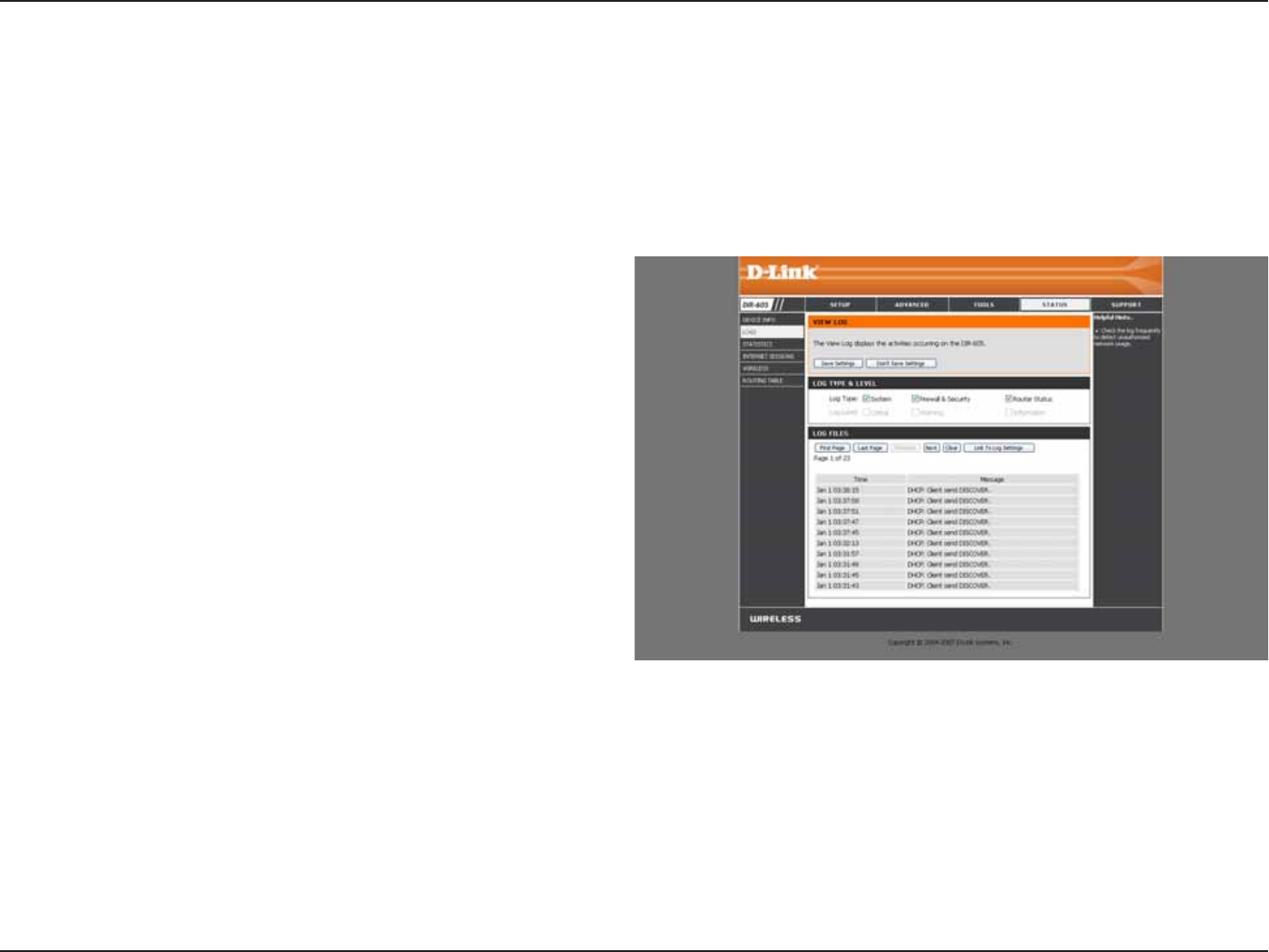
65
D-Link DIR-605 User Manual
Section 3 - Conguration
Log
What to View:
View Levels:
Clear:
Link to Log
Settings:
:PV DBOTFMFDUUIFUZQFTPGNFTTBHFT UIBUZPVXBOU
to display from the log. Firewall & Security, System,
and Router Status messages can be selected.
There are three levels of message importance:
Informational, Warning, and Critical. Select the levels
that you want displayed in the log.
Clears all of the log contents.
The user can click the button to “ link to log settings” and
save the logs to local hard drive or to syslog server.
The router automatically logs (records) events of possible interest in it’s internal memory. If there isn’t enough internal
memory for all events, logs of older events are deleted but logs of the latest events are retained. The Logs option allows
ZPVUPWJFXUIFSPVUFSMPHT:PVDBOEFöOFXIBUUZQFTPGFWFOUTZPVXBOUUPWJFXBOE UIFMFWFMPGUIF FWFOUTUPWJFX
This router also has external Syslog Server support so you can send the log les to a computer on your network that
is running a Syslog utility.
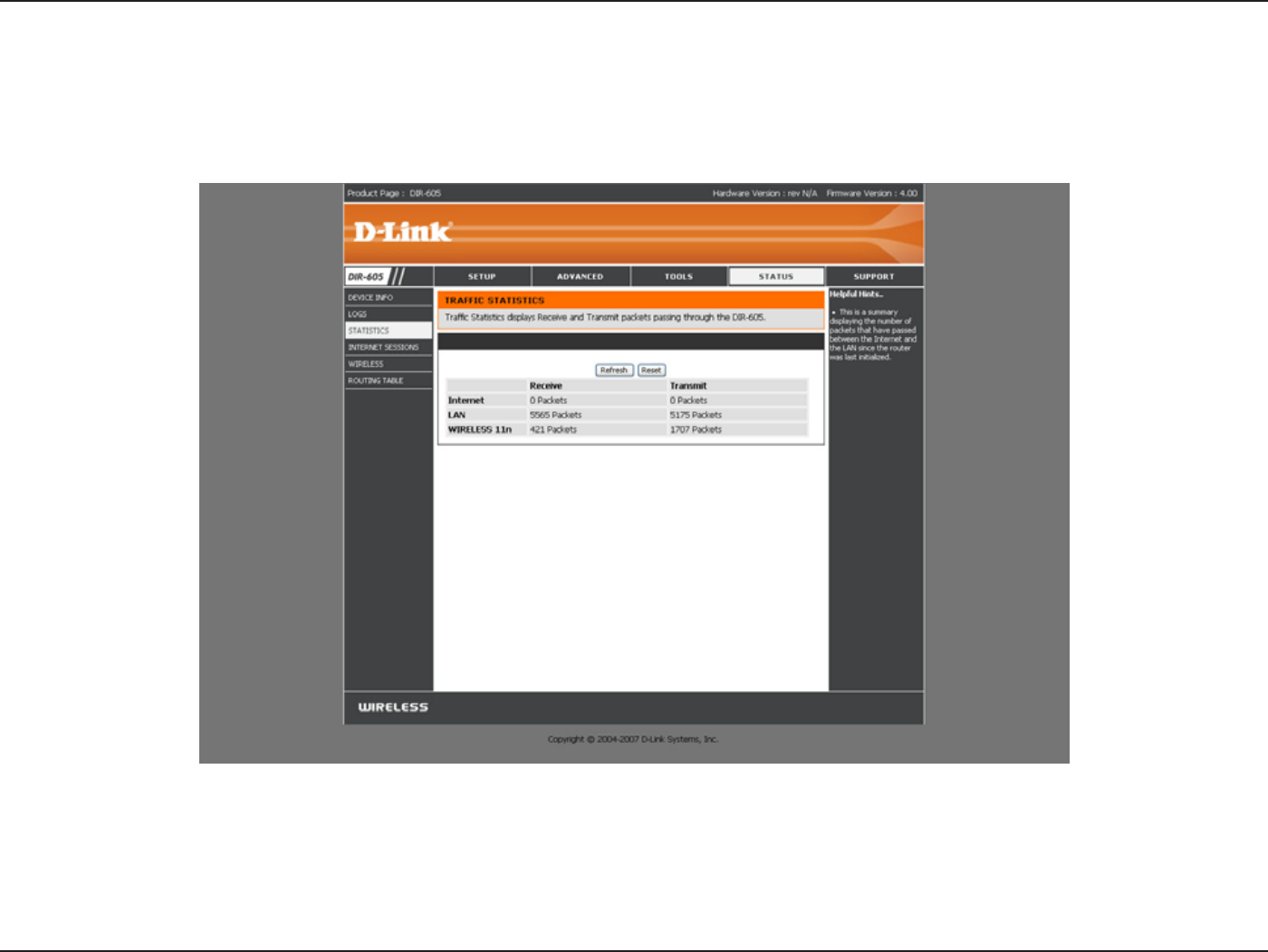
66
D-Link DIR-605 User Manual
Section 3 - Conguration
Stats
The screen below displays the Trac Statistics. Here you can view the amount of packets that pass through the DIR-605 on both the
Internet and the LAN ports. The trac counter will reset if the device is rebooted.
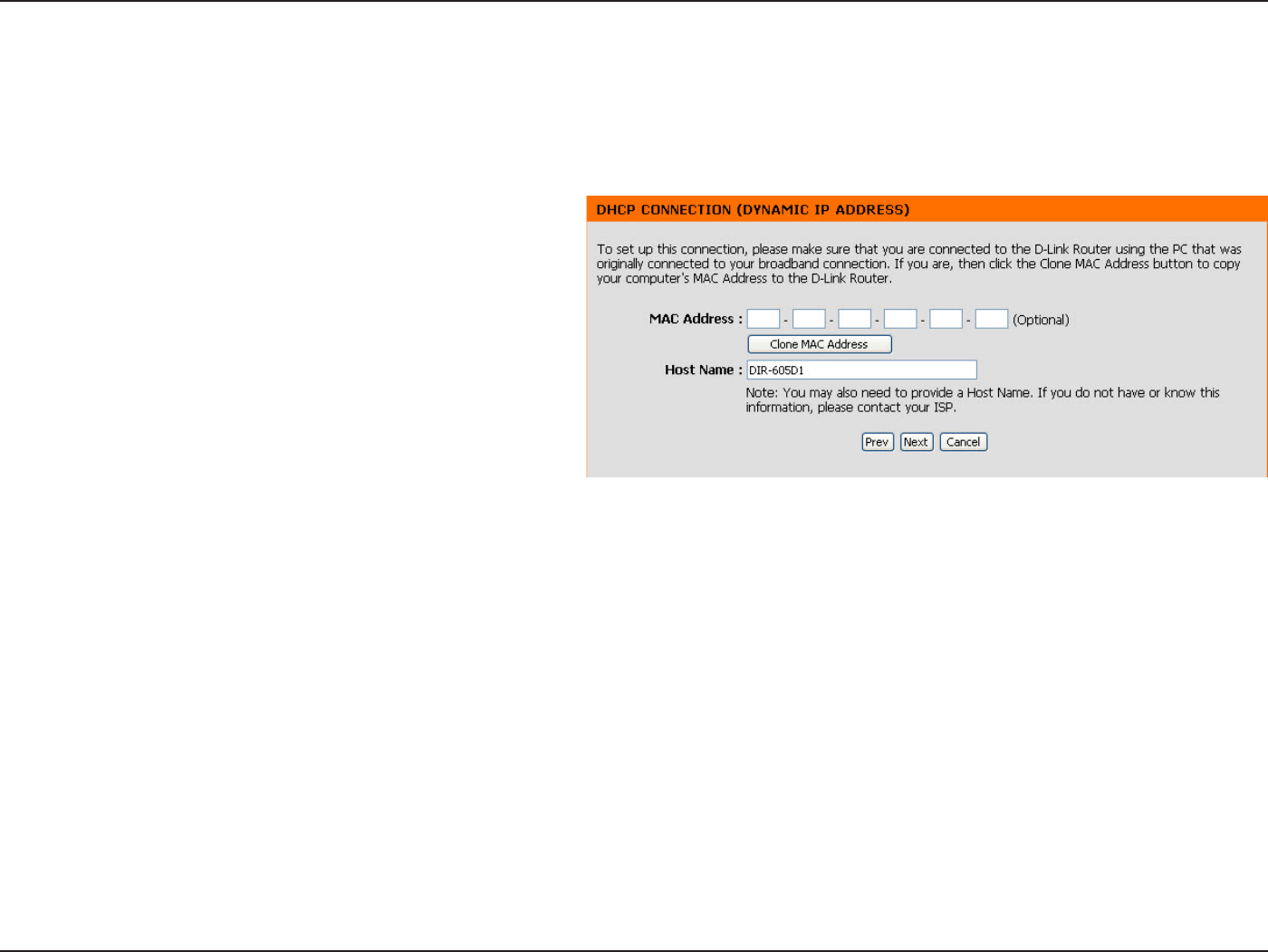
67
D-Link DIR-605 User Manual
Section 3 - Conguration
Internet Sessions
The Internet Sessions page displays full details of active Internet sessions through your router. An Internet session is
a conversation between a program or application on a LAN-side computer and a program or application on a WAN-
side computer.
IP Address:
TCP Session:
UDP Session:
The IP address and, where appropriate, port number
of the local application.
This shows the number of TCP packets being sent
from the source IP address.
This shows the number of UDP packets being sent
from the source IP address.
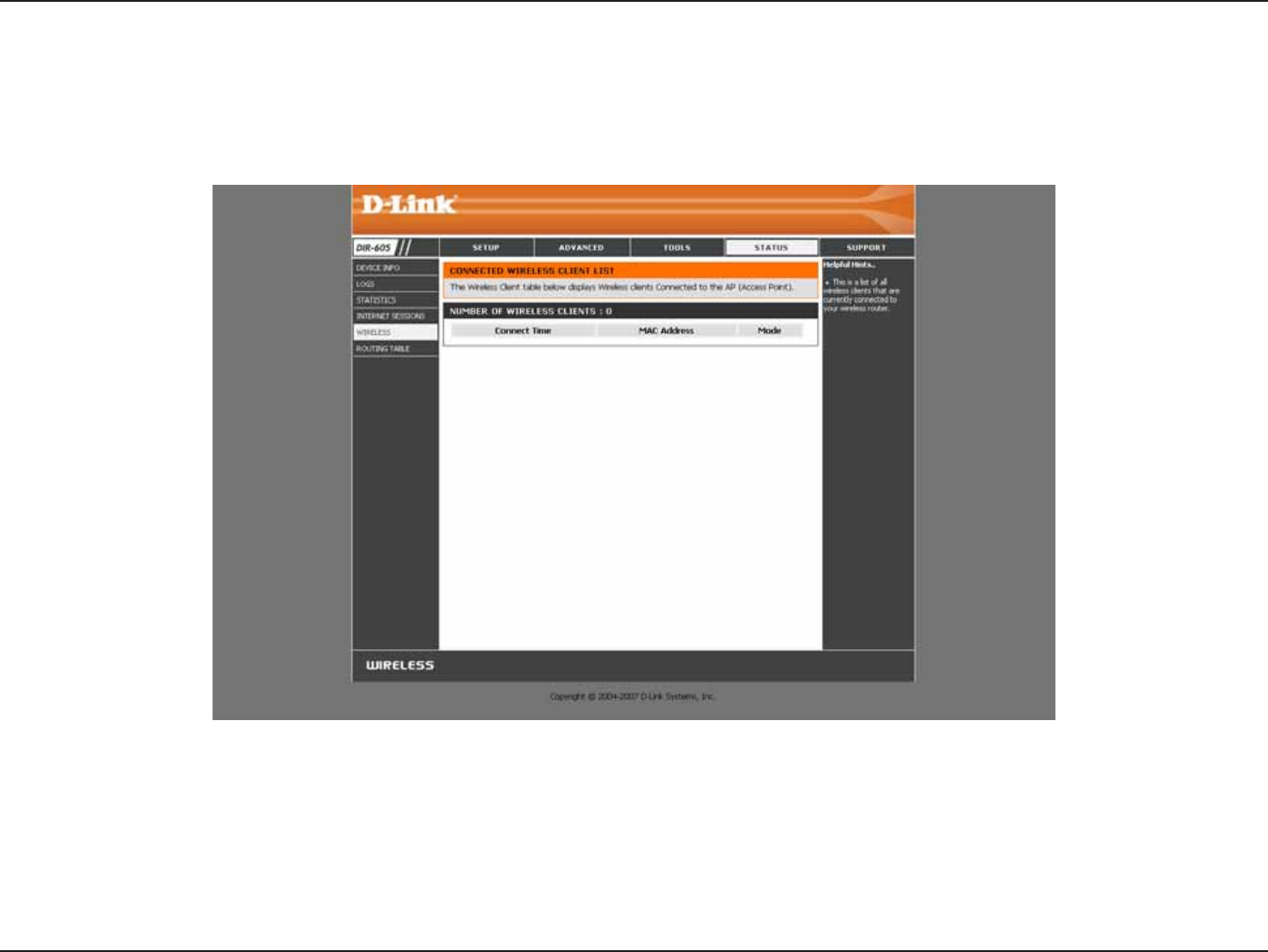
68
D-Link DIR-605 User Manual
Section 3 - Conguration
The wireless client table displays a list of current connected wireless clients. This table also displays the connection
time and MAC address of the connected wireless clients.
Wireless
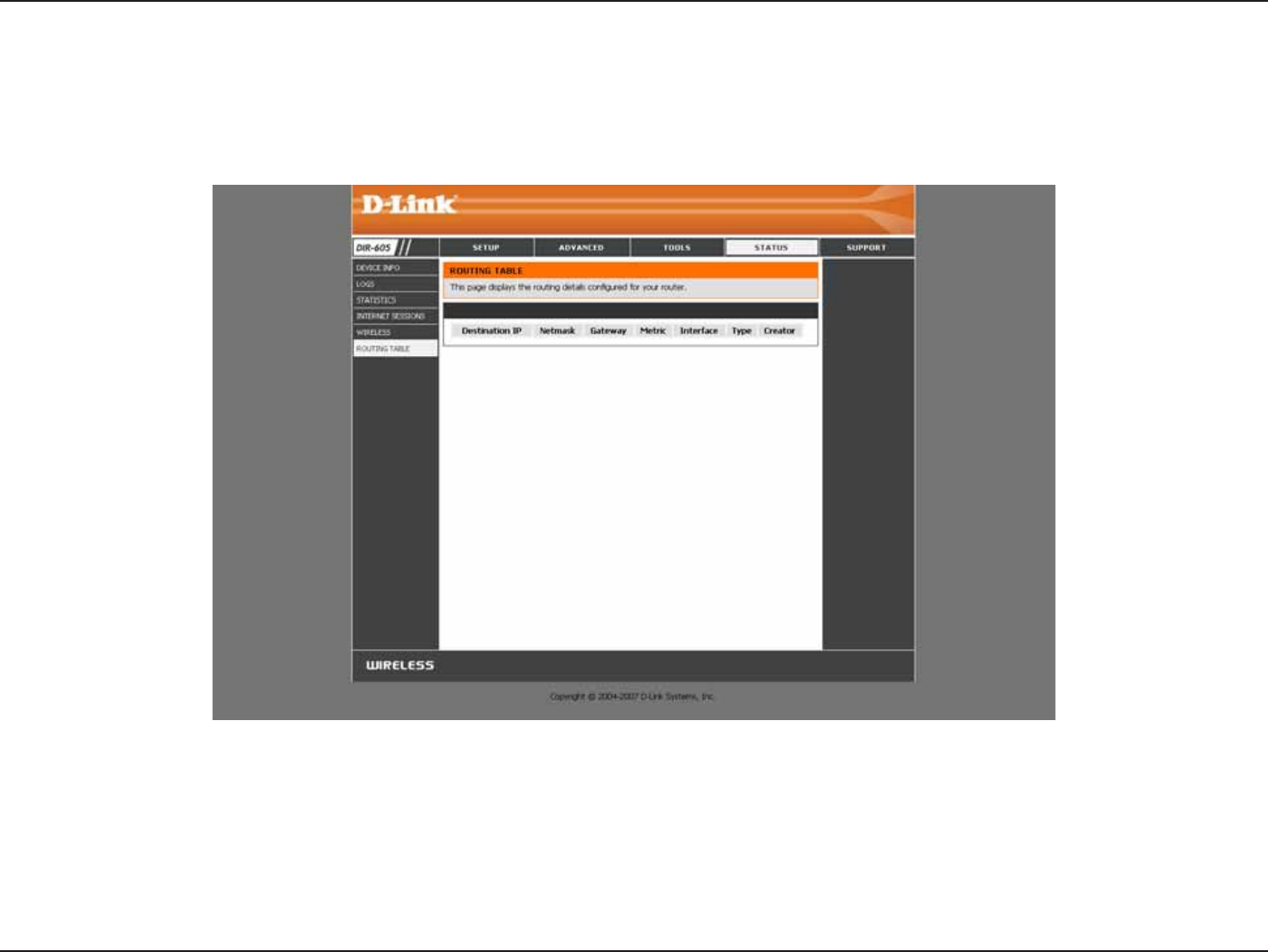
69
D-Link DIR-605 User Manual
Section 3 - Conguration
The routing table displays all routing related information congured for your router.
Routing Table
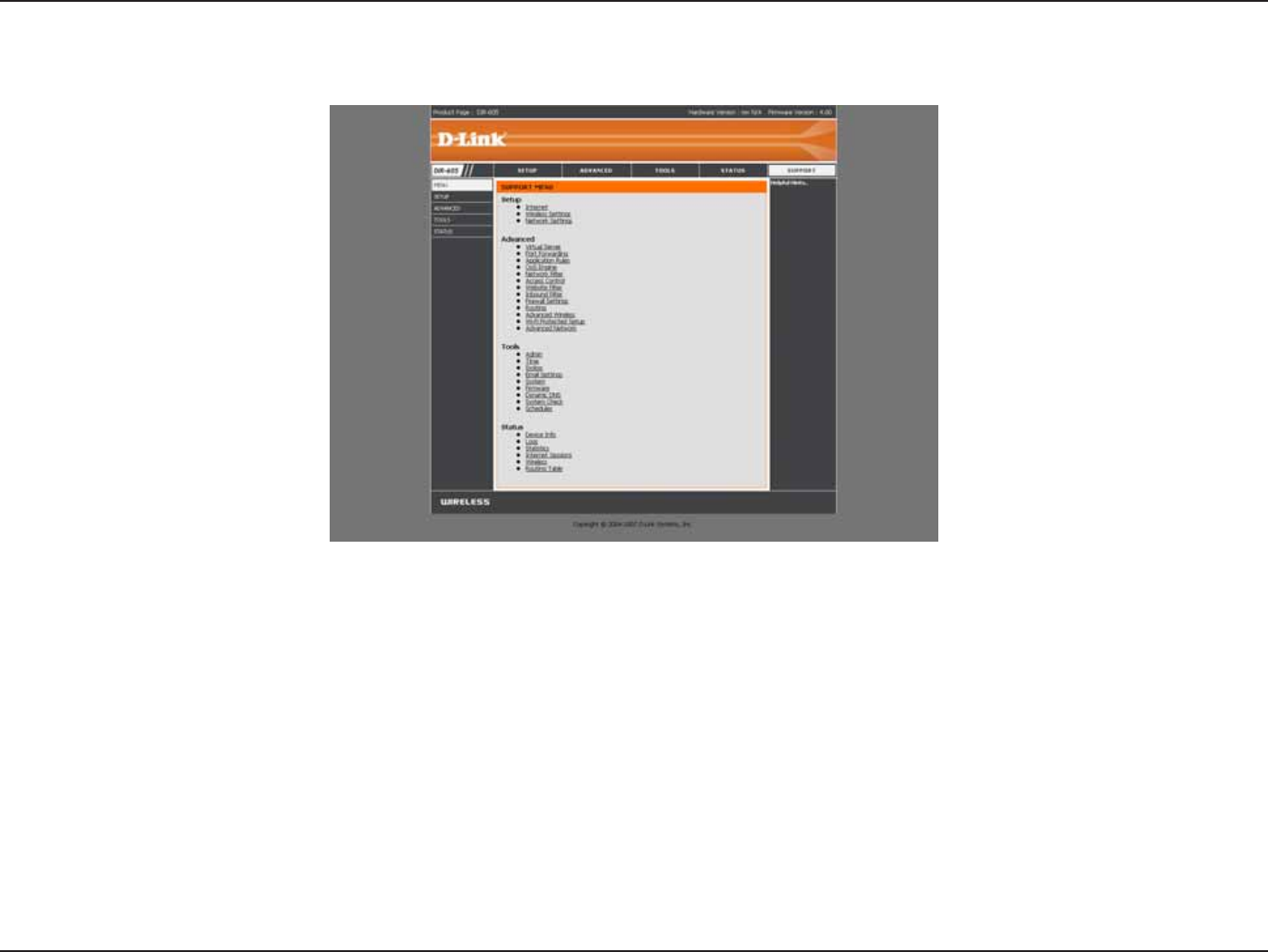
70
D-Link DIR-605 User Manual
Section 3 - Conguration
Support

71
D-Link DIR-605 User Manual
Section 4 - Security
Wireless Security
This section will show you the dierent levels of security you can use to protect your data from intruders. The DIR-605 oers
the following types of security:
t81"8J'J1SPUFDUFE"DDFTT t81"14,1SF4IBSFE,FZ
t81"8J'J1SPUFDUFE"DDFTT t81"14,1SF4IBSFE,FZ
What is WPA?
WPA, or Wi-Fi Protected Access, is a Wi-Fi standard that was designed to improve the security features of WEP (Wired
Equivalent Privacy).
The 2 major improvements over WEP:
t*NQSPWFEEBUBFODSZQUJPOUISPVHIUIF5FNQPSBM,FZ *OUFHSJUZ1SPUPDPM5,*15,*1TDSBNCMFTUIF LFZT
using a hashing algorithm and, by adding an integrity-checking feature, ensures that the keys haven’t
been tampered with. WPA2 is based on 802.11i and uses Advanced Encryption Standard (AES) instead
of TKIP.
t6TFSBVUIFOUJDBUJPOXIJDI JTHFOFSBMMZNJTTJOH JO8&1 UISPVHIUIFFYUFOTJCMFBVUIFOUJDBUJPOQSPUPDPM
(EAP). WEP regulates access to a wireless network based on a computer’s hardware-specific MAC
address, which is relatively simple to be snied out and stolen. EAP is built on a more secure public-key
encryption system to ensure that only authorized network users can access the network.
WPA-PSK/WPA2-PSK uses a passphrase or key to authenticate your wireless connection. The key is an alpha-numeric
password between 8 and 63 characters long. The password can include symbols (!?*&_) and spaces. This key must
be the exact same key entered on your wireless router or access point.
WPA/WPA2 incorporates user authentication through the Extensible Authentication Protocol (EAP). EAP is built on a
more secure public key encryption system to ensure that only authorized network users can access the network.
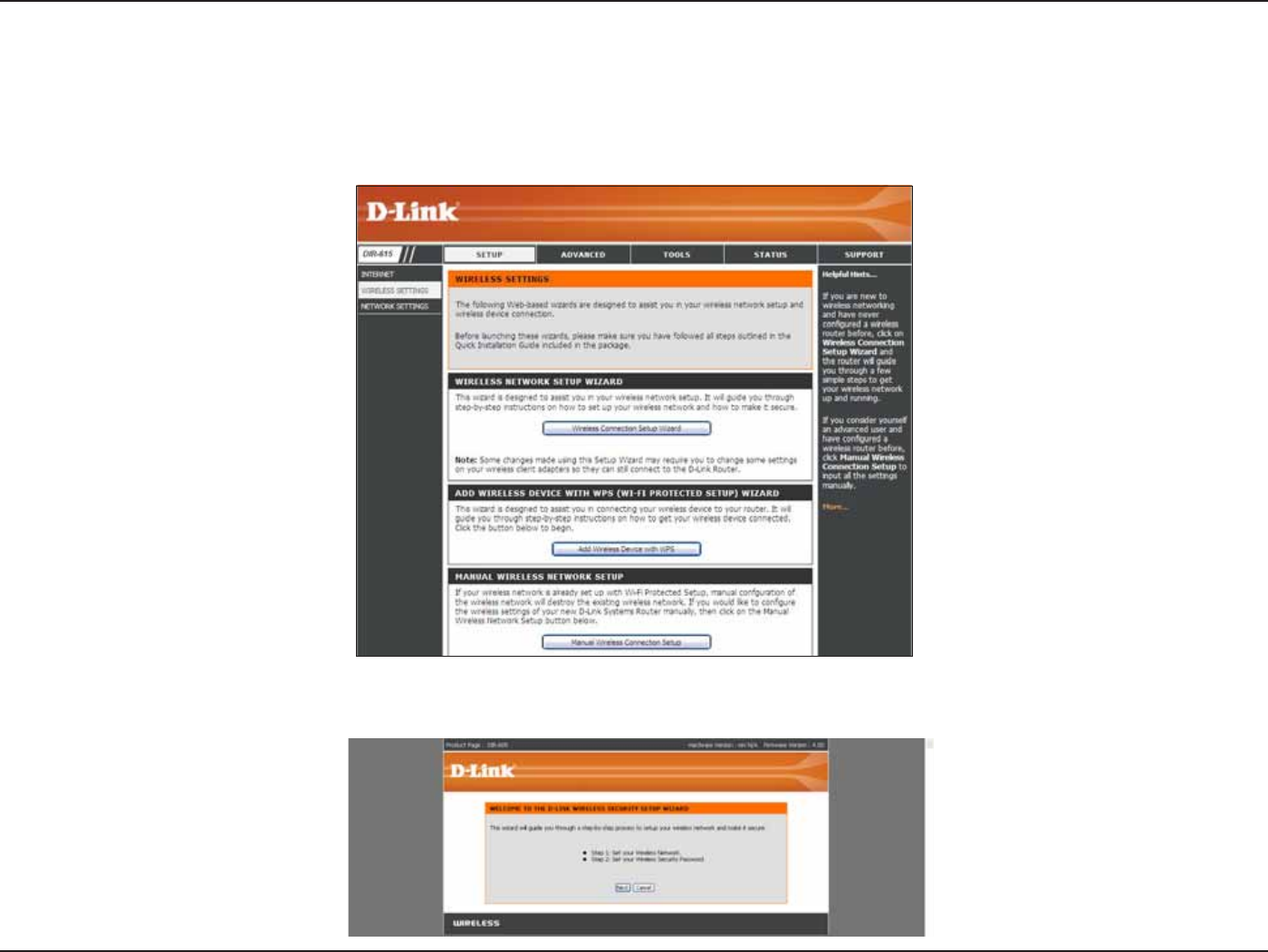
72
D-Link DIR-605 User Manual
Section 4 - Security
Wireless Connection Setup Wizard
To run the security wizard, browse to the Setup page and then click the Wireless Connection Setup Wizard
button.
Click Next to continue.
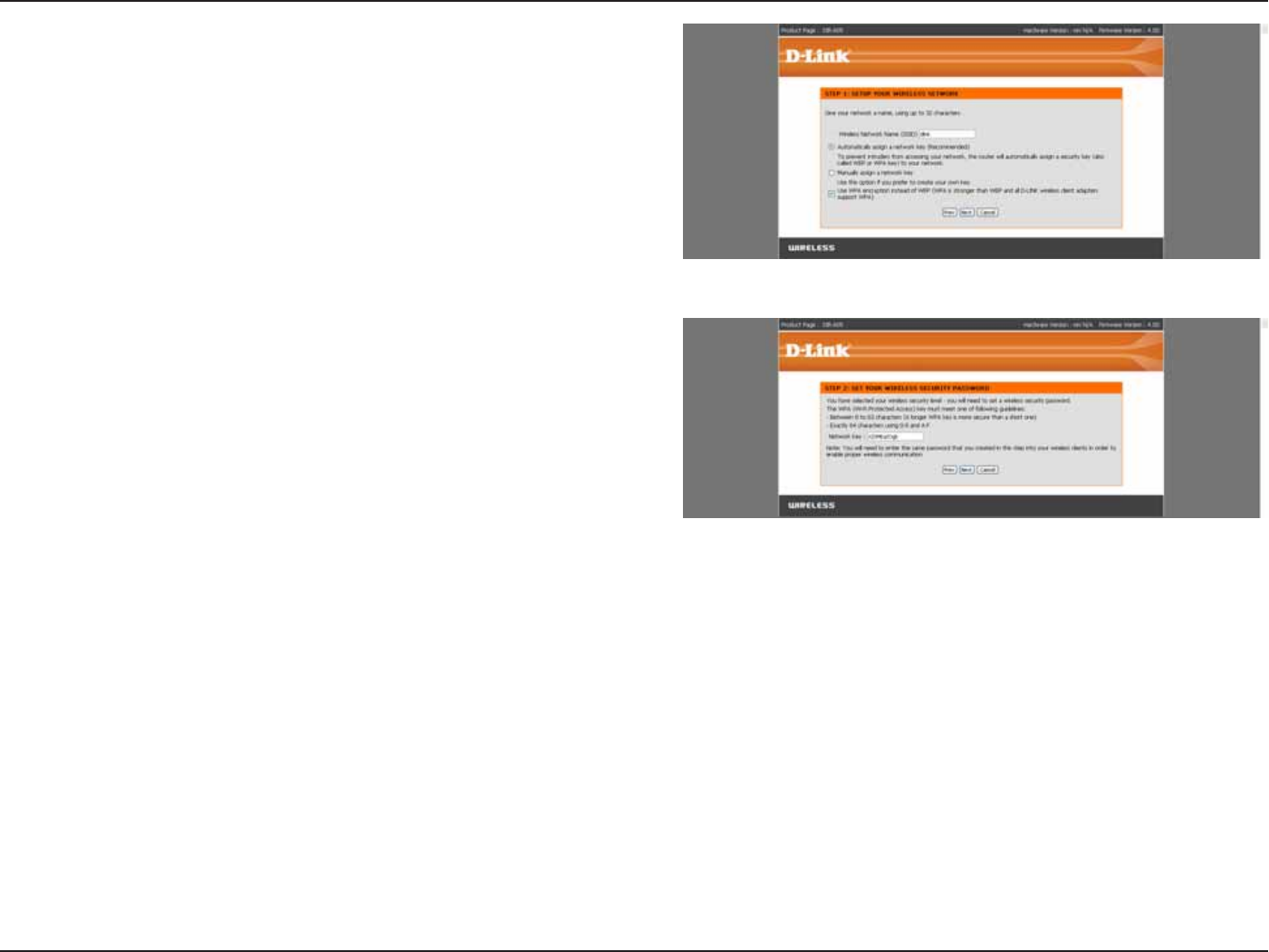
73
D-Link DIR-605 User Manual
Section 4 - Security
Enter the SSID (Service Set Identifier). The SSID is the
name of your wireless network. Create a name using up to
32 characters. The SSID is case-sensitive.
Select the level of security for your wireless network:
t#FTU81""VUIFOUJDBUJPO
t#FUUFS81""VUIFOUJDBUJPO
t/POF/PTFDVSJUZ
Click Next to continue.
If you selected Best or Better, enter a password between
8-63 characters.
If you selected Good, enter 13 characters or 26 Hex digits.
Click Next to continue.
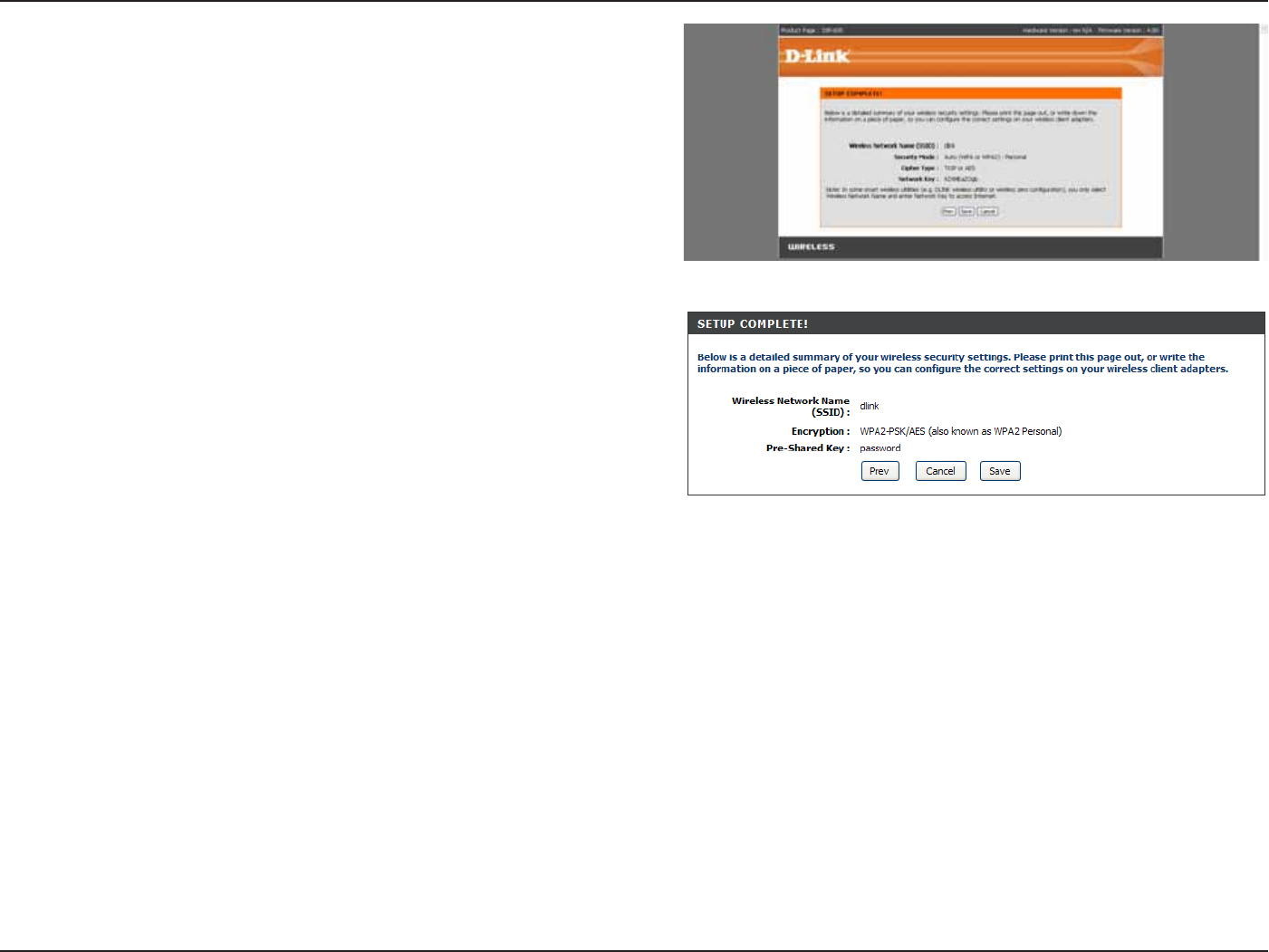
74
D-Link DIR-605 User Manual
Section 4 - Security
If you selected Better, the following screen will show you your
Pre-Shared Key to enter on your wireless clients.
Click Save to nish the Security Wizard.
If you selected Best, the following screen will show you your Pre-
Shared Key to enter on your wireless clients.
Click Save to nish the Security Wizard.
If you selected WPA-Enterprise, the RADIUS information will be displayed. Click Save to nish the Security Wizard.
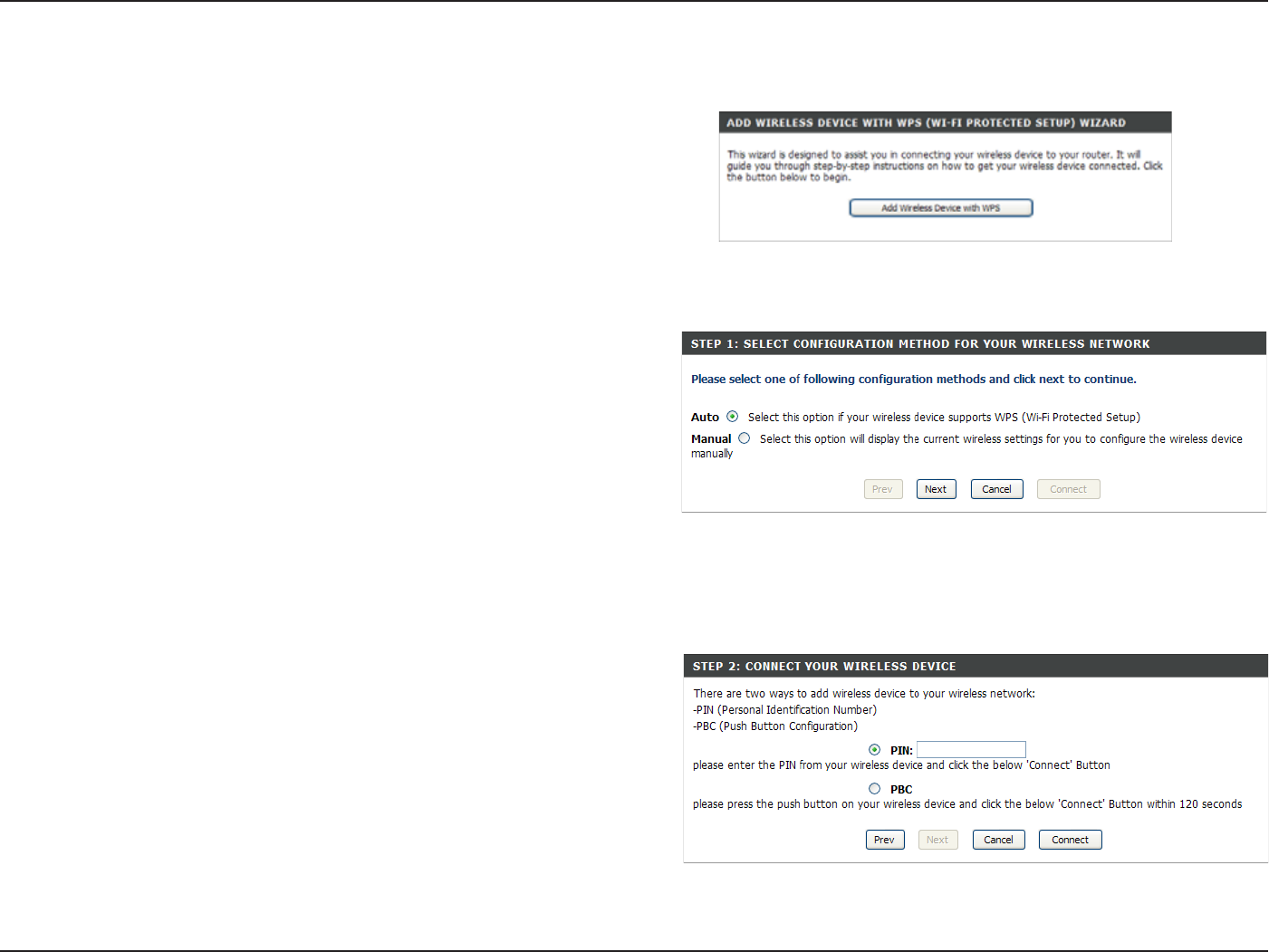
75
D-Link DIR-605 User Manual
Section 4 - Security
From the Setup > Wireless Settings screen, click Add
Wireless Device with WPS.
Add Wireless Device with WPS Wizard
PIN: Select this option to use PIN method. In order to use this
method you must know the wireless client’s 8 digit PIN and
click Connect.
PBC: Select this option to use PBC (Push Button) method to
add a wireless client. Click Connect.
Select Auto to add a wireless client using WPS (Wi-Fi Protected
Setup). Once you select Auto and click Connect, you will have
a 120 second time limit to apply the settings to your wireless
client(s) and successfully establish a connection.
If you select Manual, a settings summary screen will appear.
Write down the security key and enter this on your wireless
clients.
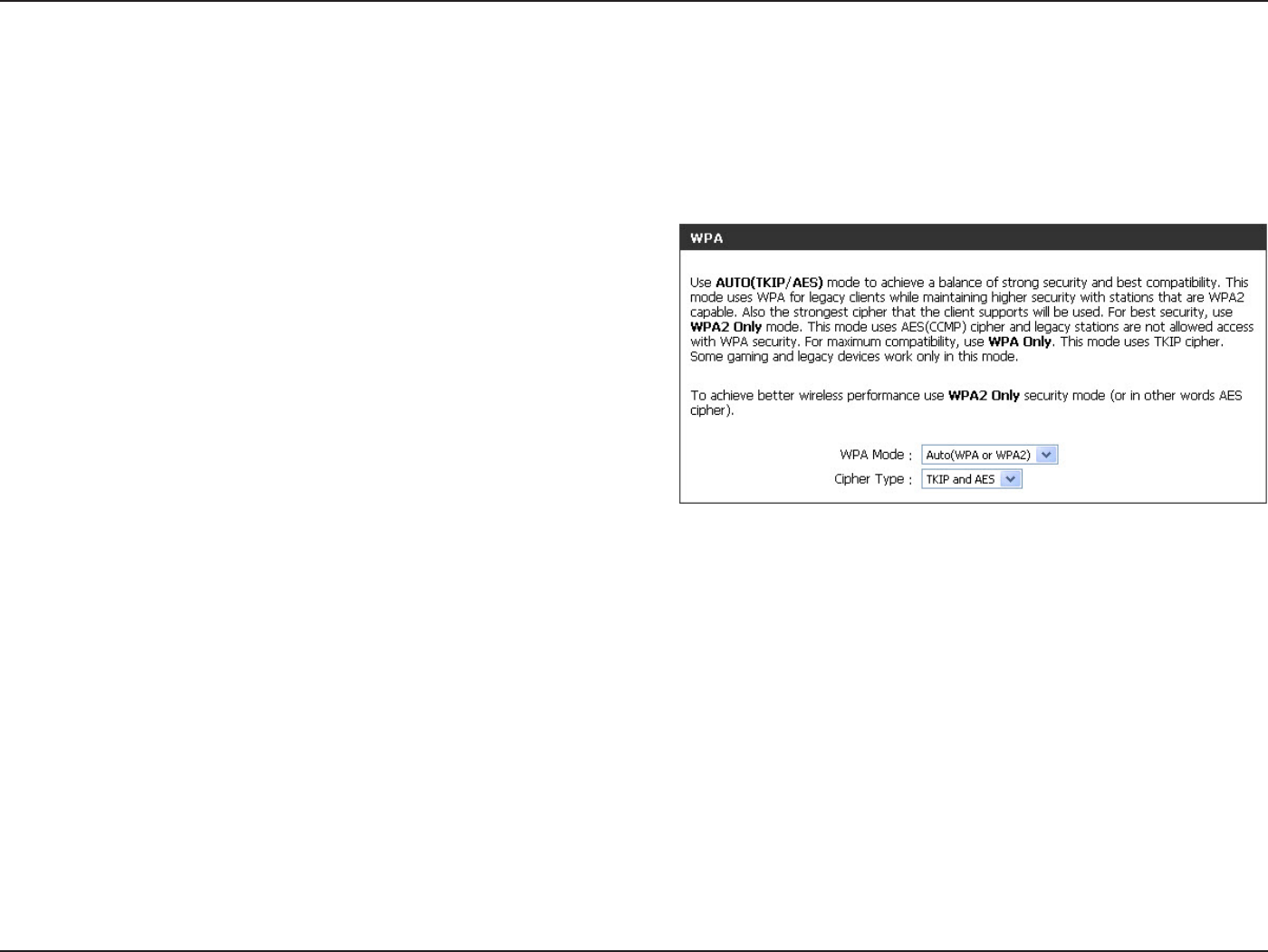
76
D-Link DIR-605 User Manual
Section 4 - Security
Congure WPA-Personal (PSK)
It is recommended to enable encryption on your wireless router before your wireless network adapters. Please establish
XJSFMFTTDPOOFDUJWJUZ CFGPSFFOBCMJOHFODSZQUJPO:PVSXJSFMFTTTJHOBMNBZEFHSBEFXIFOFOBCMJOH FODSZQUJPOEVFUP
the added overhead.
1. Log into the web-based conguration by opening a web browser
and entering the IP address of the router (192.168.0.1). Click on
Setup and then click Wireless Settings on the left side.
2. Next to Security Mode, select WPA-Personal.
3. Next to WPA Mode, select Auto, WPA2 Only, or WPA Only. Use
Auto if you have wireless clients using both WPA and WPA2.
4. Next to Cypher Type, select TKIP and AES, TKIP, or AES. If you have
wireless clients that use both types, use TKIP and AES.
5. Next to Group Key Update Interval, enter the amount of time before the group key used for broadcast and multicast data is
changed (3600 is default).
6. Next to Pre-Shared Key, enter a key (passphrase). The key is entered as a pass-phrase in ASCII format at both ends of the
wireless connection. The pass-phrase must be between 8-63 characters.
7. Click Save Settings to save your settings. If you are conguring the router with a wireless adapter, you will lose connectivity
until you enable WPA-PSK on your adapter and enter the same passphrase as you did on the router.
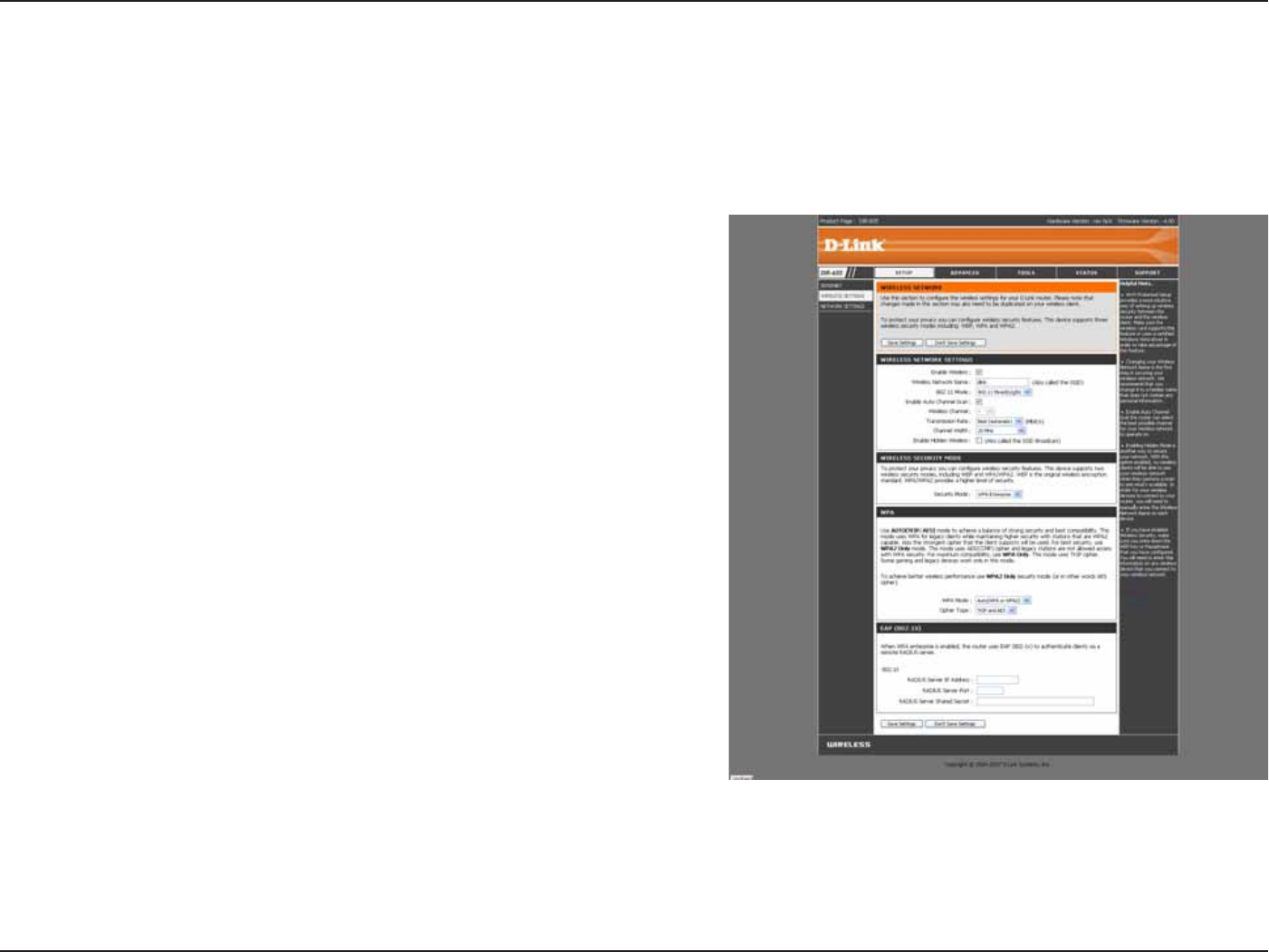
77
D-Link DIR-605 User Manual
Section 4 - Security
It is recommended to enable encryption on your wireless router before your wireless network adapters. Please establish
XJSFMFTTDPOOFDUJWJUZ CFGPSFFOBCMJOHFODSZQUJPO:PVSXJSFMFTTTJHOBMNBZEFHSBEFXIFOFOBCMJOH FODSZQUJPOEVFUP
the added overhead.
1. Log into the web-based conguration by opening a web browser and
entering the IP address of the router (192.168.0.1). Click on Setup
and then click Wireless Settings on the left side.
2. Next to Security Mode, select WPA-Enterprise.
3. Next to WPA Mode, select Auto, WPA2 Only, or WPA Only. Use Auto
if you have wireless clients using both WPA and WPA2.
4. Next to Cypher Type, select TKIP and AES, TKIP, or AES. If you have
wireless clients that use both types, use TKIP and AES.
5. Next to Group Key Update Interval, enter the amount of time before
the group key used for broadcast and multicast data is changed
(3600 is default).
6. Next to Authentication Timeout, enter the amount of time before a
client is required to re-authenticate (60 minutes is default).
7. Next to RADIUS Server IP Address enter the IP Address of your RADIUS
server.
8. Next to RADIUS Server Port, enter the port you are using with your RADIUS server. 1812 is the default port.
9. Next to RADIUS Server Shared Secret, enter the security key.
Congure WPA-Enterprise (RADIUS)
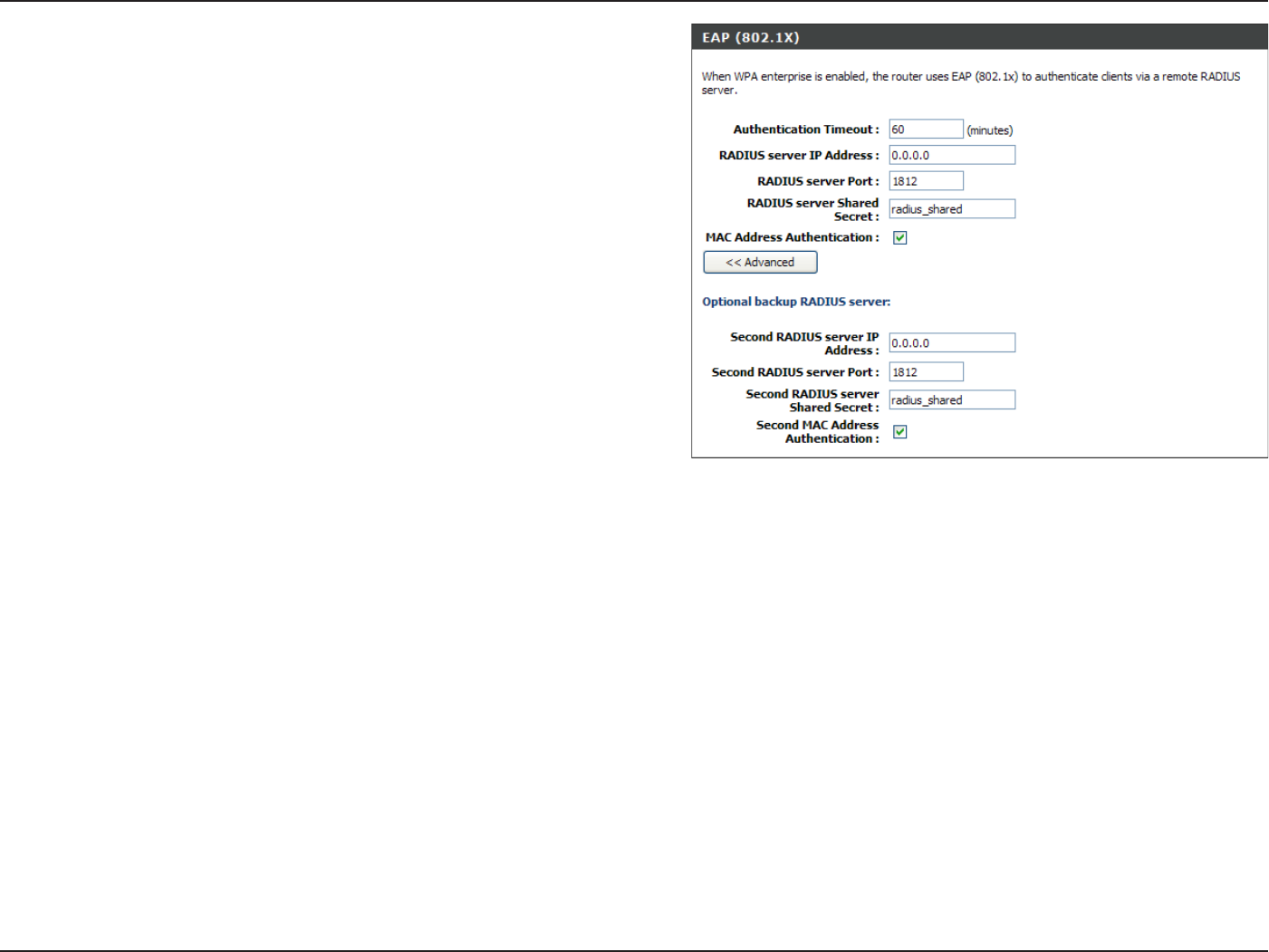
78
D-Link DIR-605 User Manual
Section 4 - Security
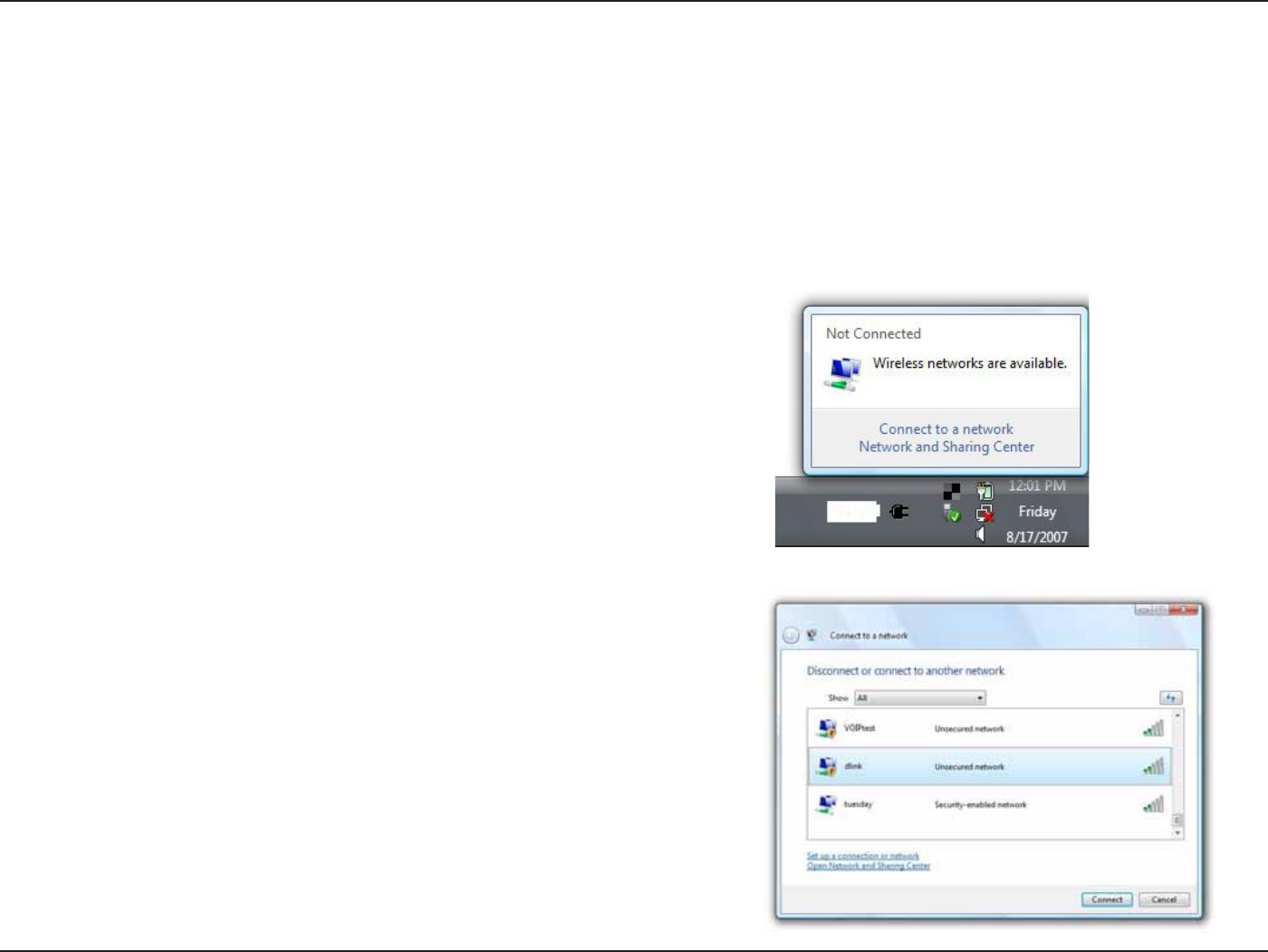
79
D-Link DIR-605 User Manual
Section 5 - Connecting to a Wireless Network
Connect to a Wireless Network
Using Windows Vista®
Windows Vista® users may use the built-in wireless utility. If you are using another company’s utility or Windows® 2000,
please refer to the user manual of your wireless adapter for help with connecting to a wireless network. Most utilities
will have a “site survey” option similar to the Windows Vista® utility as seen below.
Right-click on the wireless computer icon in your system tray
(lower-right corner next to the time). Select Connect to a
network.
If you receive the Wireless Networks Detected bubble, click
on the center of the bubble to access the utility.
or
The utility will display any available wireless networks in your
area. Click on a network (displayed using the SSID) and click
the Connect button.
If you get a good signal but cannot access the Internet,
check you TCP/IP settings for your wireless adapter. Refer
to the Networking Basics section in this manual for more
information.
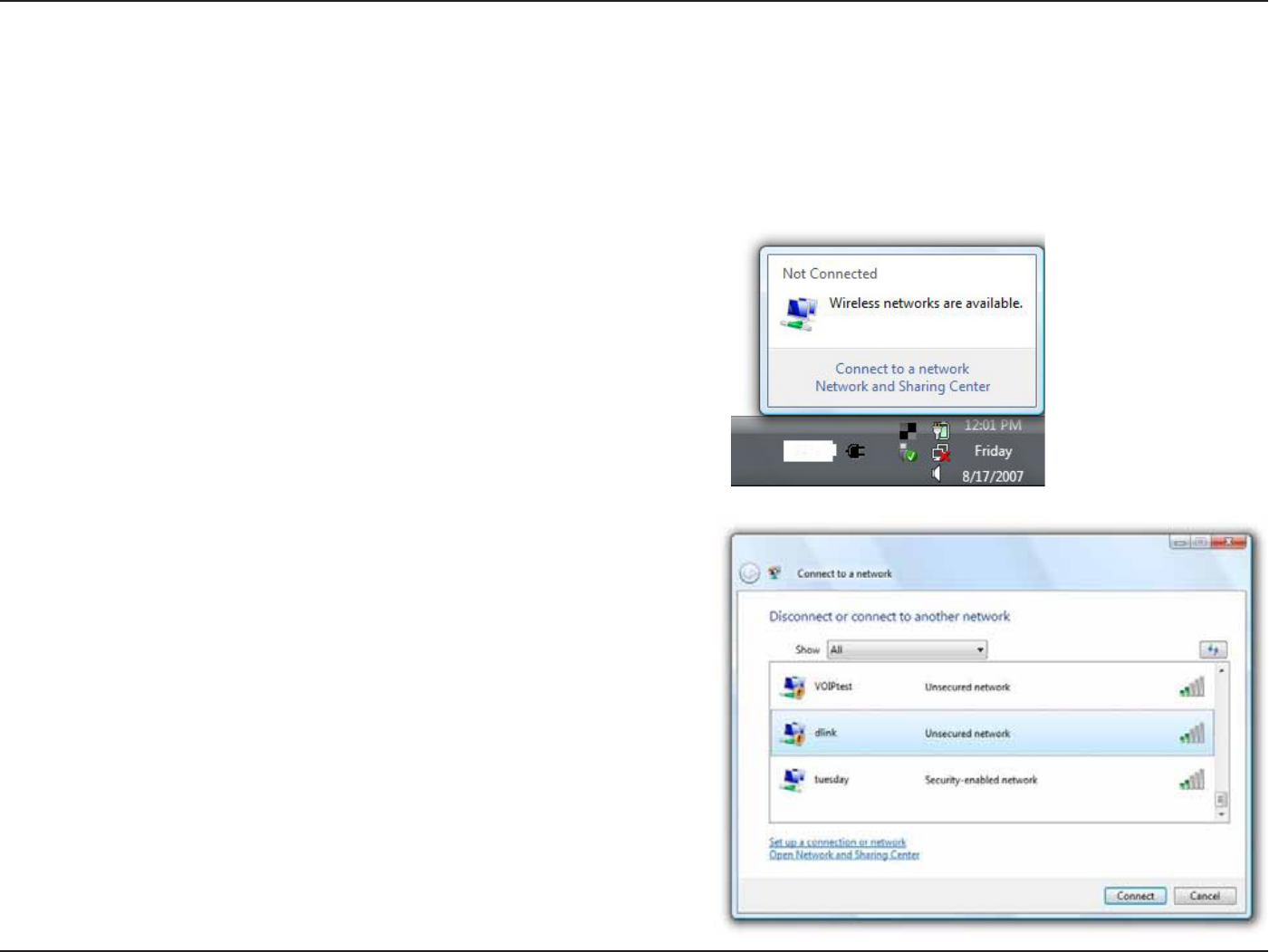
80
D-Link DIR-605 User Manual
Section 5 - Connecting to a Wireless Network
Congure WPA/WPA2
It is recommended to enable wireless security (WPA/WPA2) on your wireless router or access point before conguring
your wireless adapter. If you are joining an existing network, you will need to know the security key or passphrase
being used.
2. Highlight the wireless network (SSID) you would like to
connect to and click Connect.
1. Open the Windows Vista® Wireless Utility by right-clicking
on the wireless computer icon in your system tray (lower
right corner of screen). Select Connect to a network.
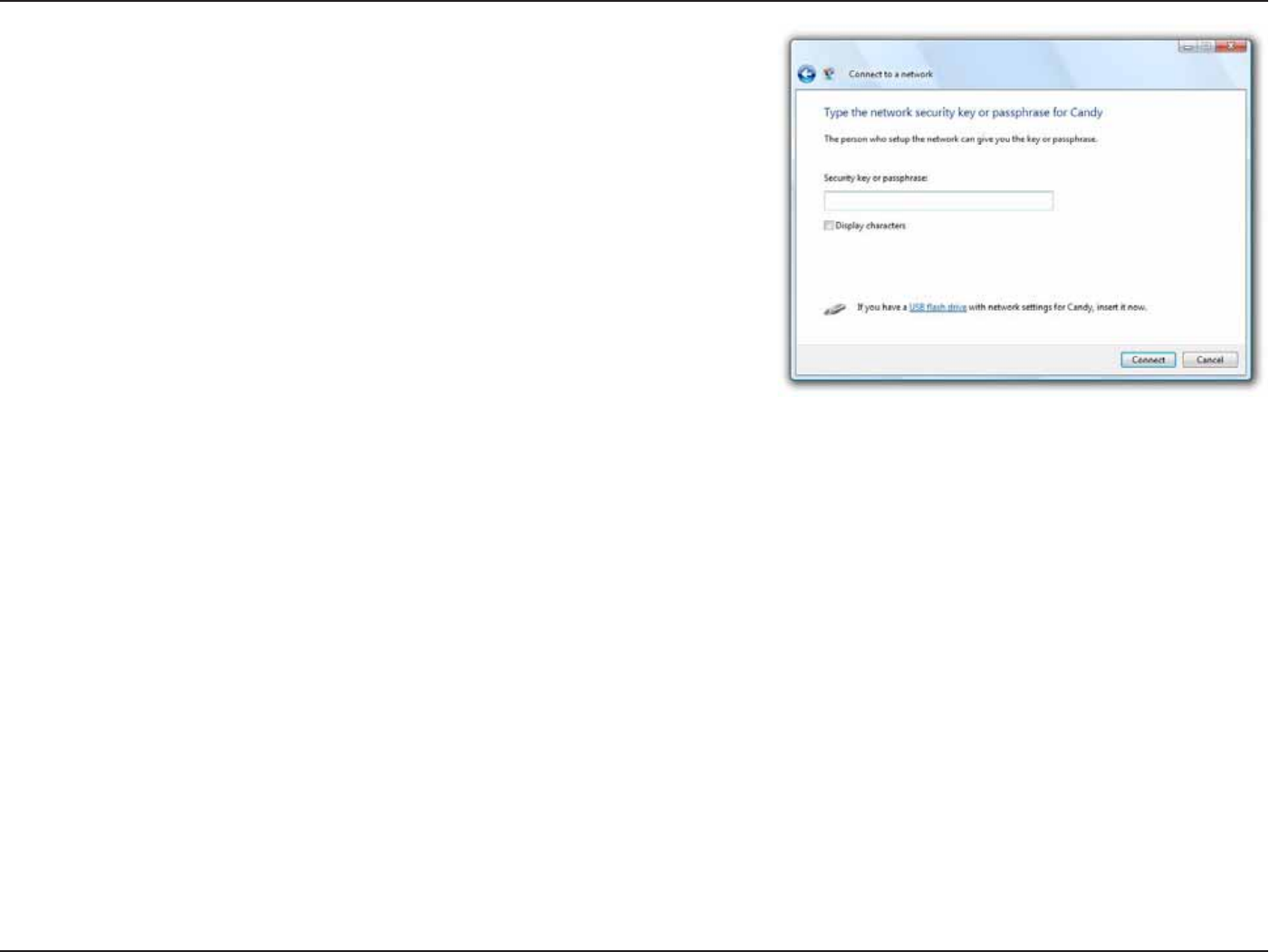
81
D-Link DIR-605 User Manual
Section 5 - Connecting to a Wireless Network
3. Enter the same security key or passphrase that is on your router
and click Connect.
It may take 20-30 seconds to connect to the wireless network. If the
connection fails, please verify that the security settings are correct.
The key or passphrase must be exactly the same as on the wireless
router.
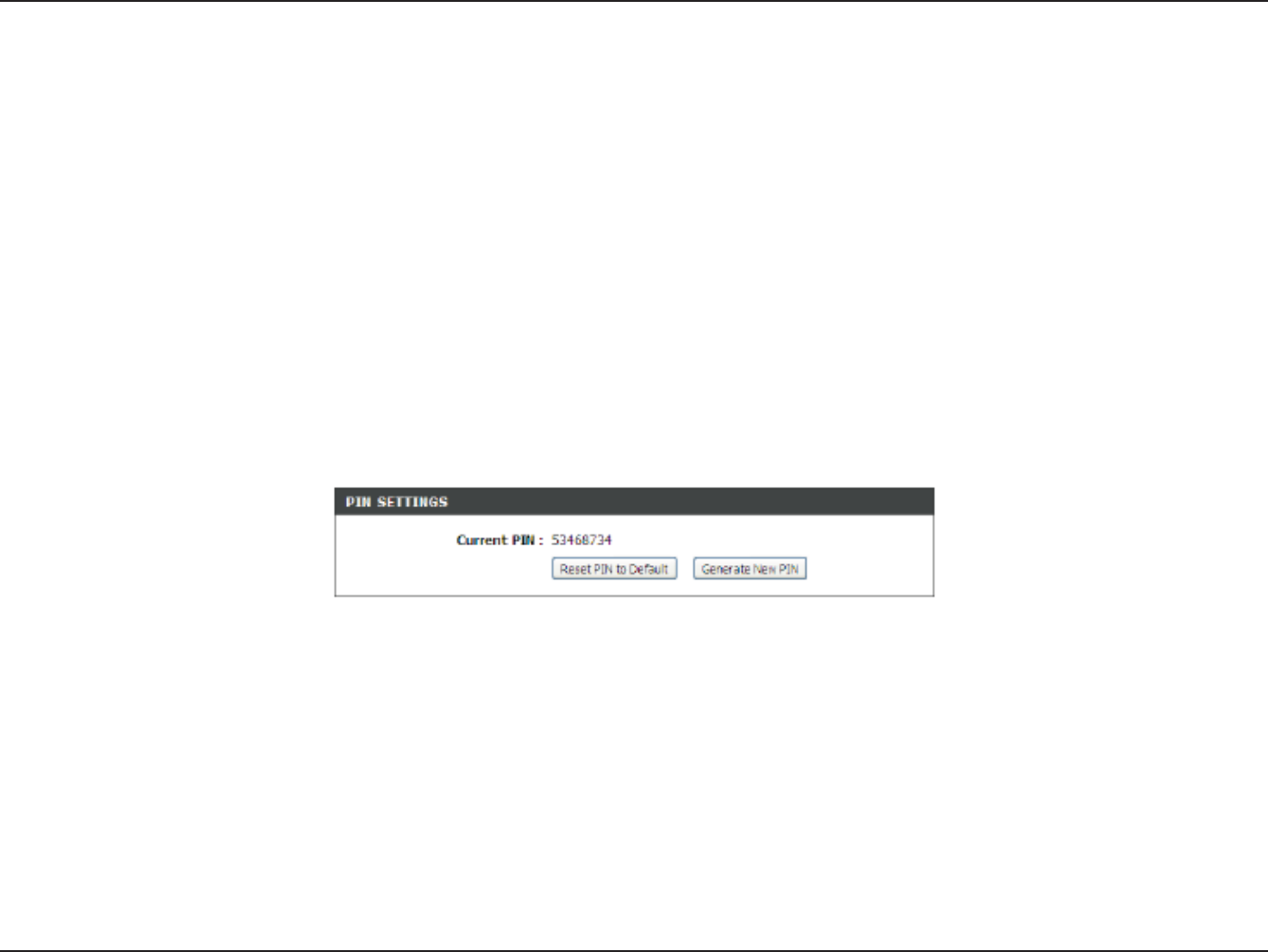
82
D-Link DIR-605 User Manual
Section 5 - Connecting to a Wireless Network
Connect Using WCN 2.0
The router supports Wi-Fi protection, referred to as WCN 2.0 in Windows Vista®. The following instructions for setting
this up depends on whether you are using Windows Vista® to congure the router or third party software.
When you rst set up the router, Wi-Fi protection is disabled and uncongured. To enjoy the benets of Wi-Fi protection,
the router must be both enabled and configured. There are three basic methods to accomplish this: use Windows
Vista’s built-in support for WCN 2.0, use software provided by a third party, or manually congure.
If you are running Windows Vista®, log into the router and click the Enable checkbox in the Basic > Wireless section.
Use the Current PIN that is displayed on the Advanced > Wi-Fi Protected Setup section or choose to click the
Generate New PIN button or Reset PIN to Default button.
If you are using third party software to set up Wi-Fi Protection, carefully follow the directions. When you are nished,
proceed to the next section to set up the newly-congured router.
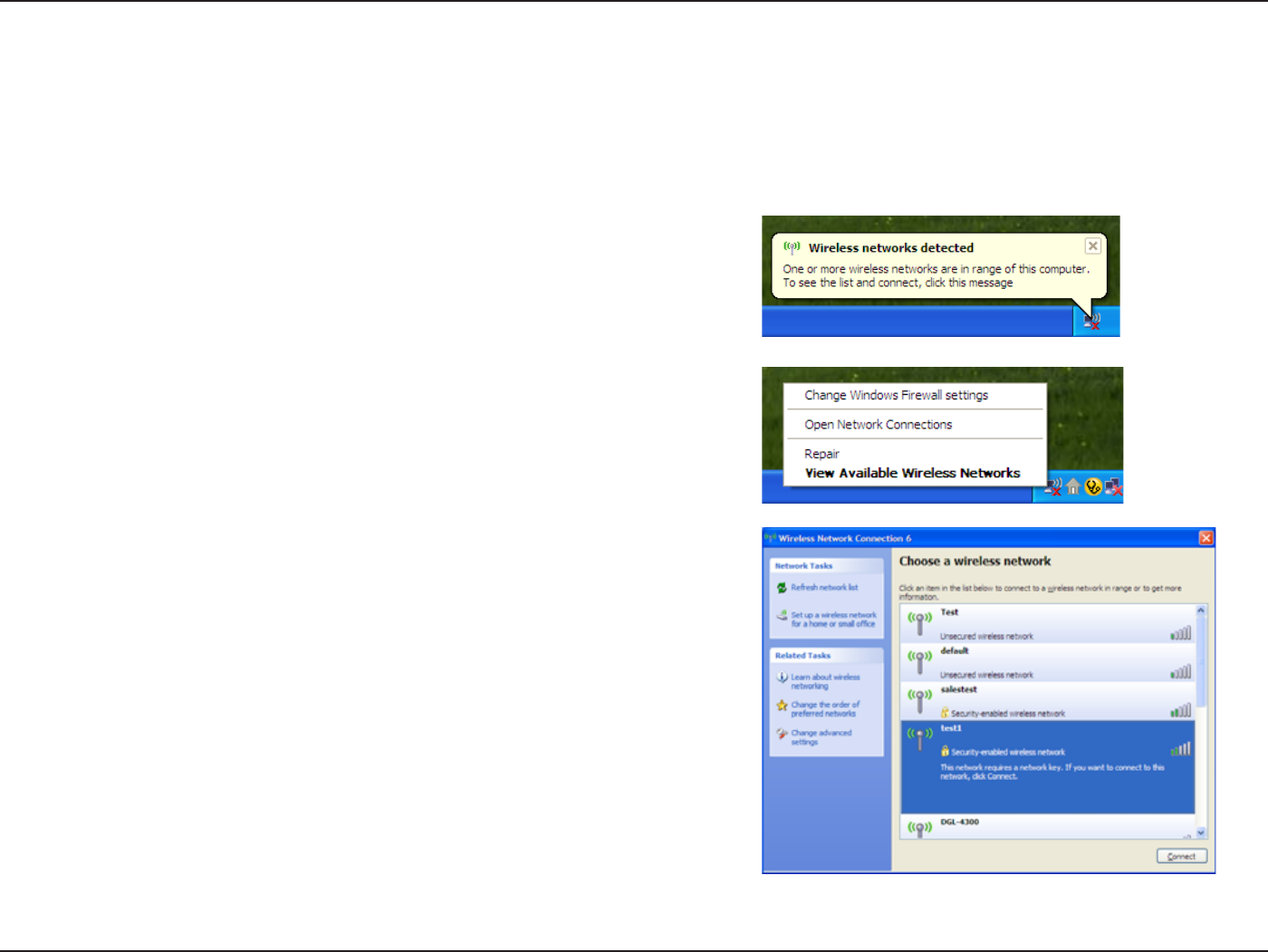
83
D-Link DIR-605 User Manual
Section 5 - Connecting to a Wireless Network
Using Windows® XP
Windows® XP users may use the built-in wireless utility (Zero Conguration Utility). The following instructions are for
Service Pack 2 users. If you are using another company’s utility or Windows® 2000, please refer to the user manual
of your wireless adapter for help with connecting to a wireless network. Most utilities will have a “site survey” option
similar to the Windows® XP utility as seen below.
If you receive the Wireless Networks Detected bubble, click
on the center of the bubble to access the utility.
or
Right-click on the wireless computer icon in your system tray
(lower-right corner next to the time). Select View Available
Wireless Networks.
The utility will display any available wireless networks in your
area. Click on a network (displayed using the SSID) and click
the Connect button.
If you get a good signal but cannot access the Internet, check you
TCP/IP settings for your wireless adapter. Refer to the Networking
Basics section in this manual for more information.
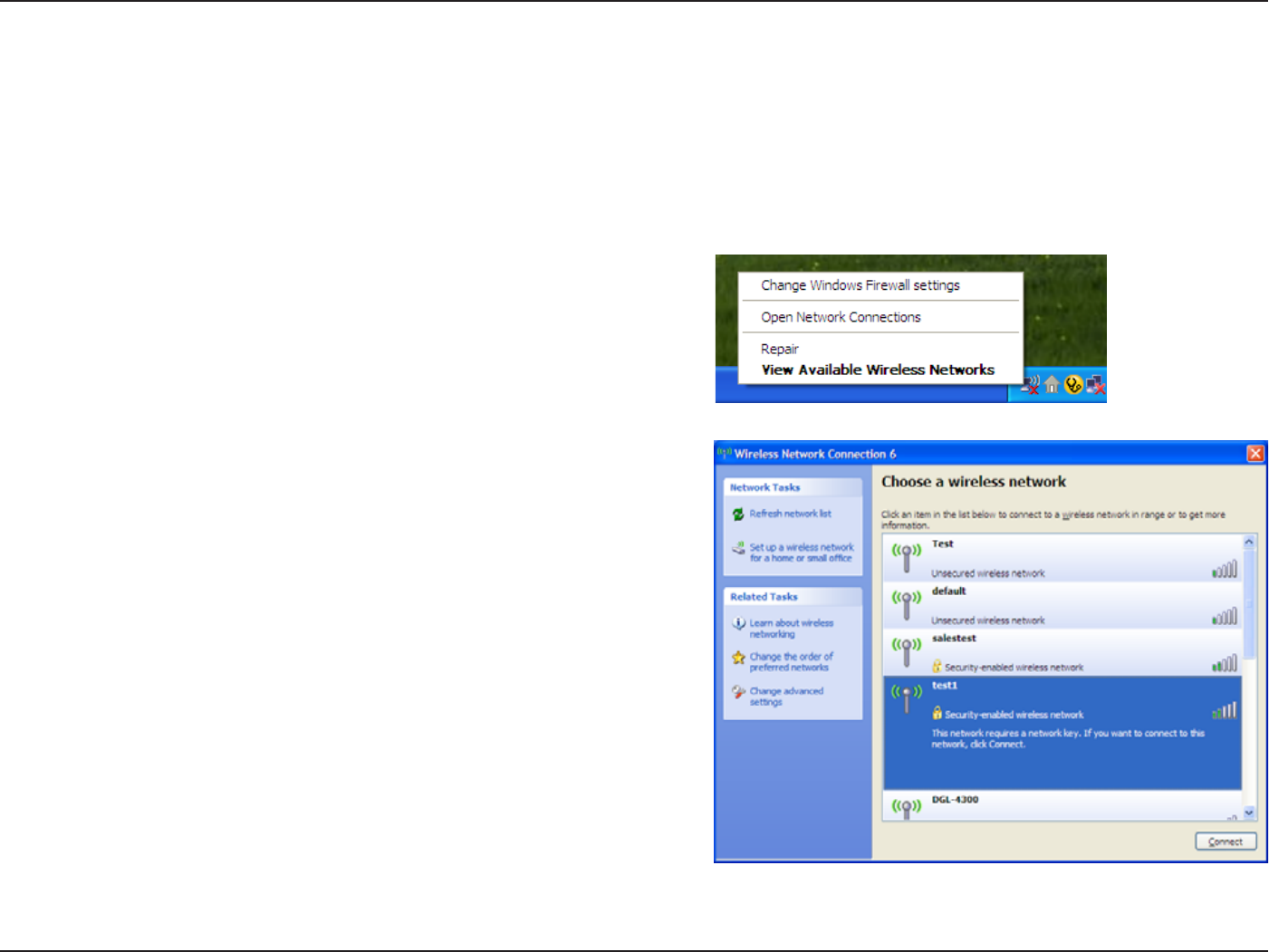
84
D-Link DIR-605 User Manual
Section 5 - Connecting to a Wireless Network
Congure WPA-PSK
It is recommended to enable WEP on your wireless router or access point before conguring your wireless adapter. If
you are joining an existing network, you will need to know the WEP key being used.
2. Highlight the wireless network (SSID) you would like to
connect to and click Connect.
1. Open the Windows® XP Wireless Utility by right-clicking
on the wireless computer icon in your system tray
(lower-right corner of screen). Select View Available
Wireless Networks.
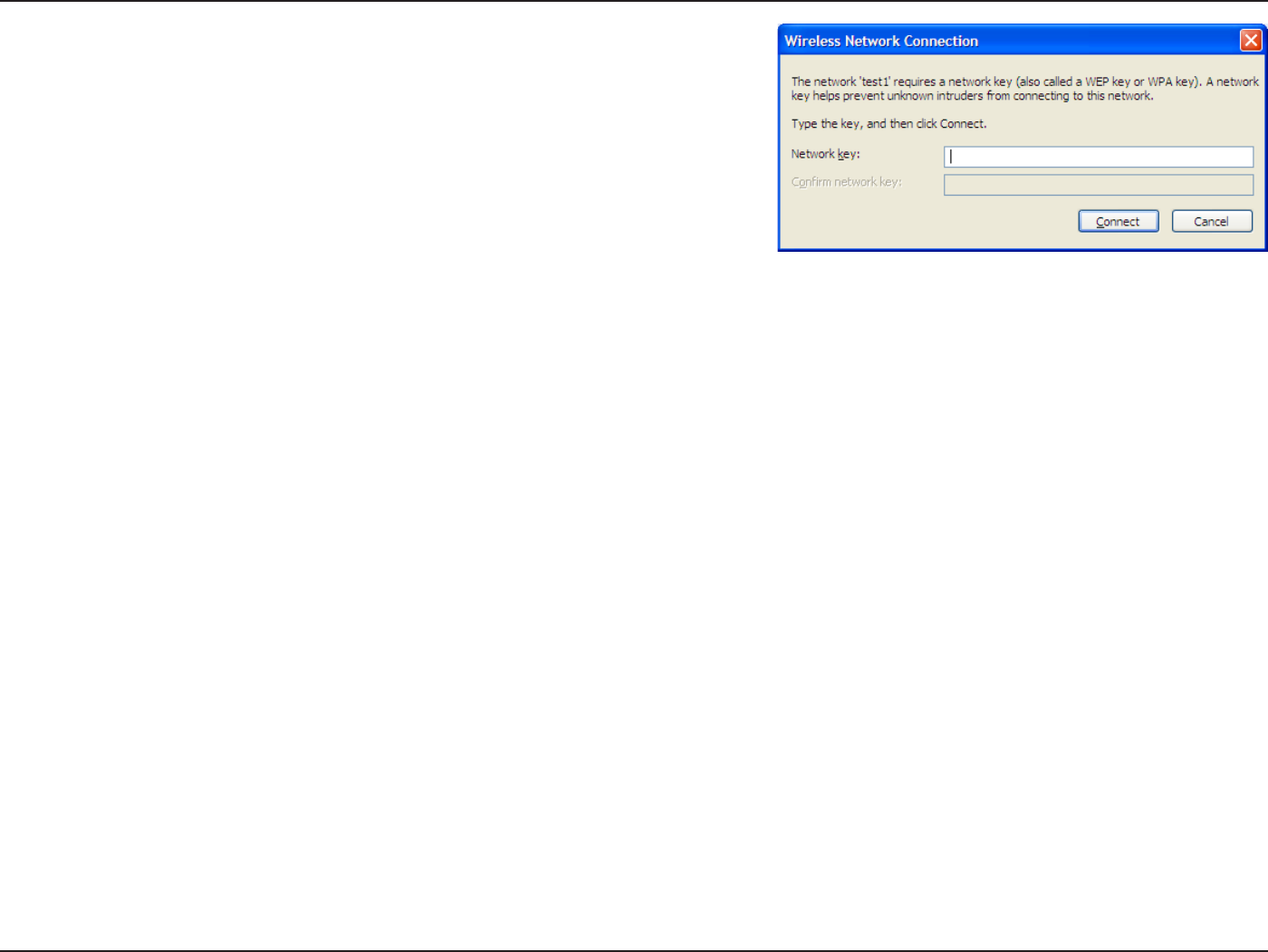
85
D-Link DIR-605 User Manual
Section 5 - Connecting to a Wireless Network
3. The Wireless Network Connection box will appear. Enter the
WPA-PSK passphrase and click Connect.
It may take 20-30 seconds to connect to the wireless network. If the
connection fails, please verify that the WPA-PSK settings are correct.
The WPA-PSK passphrase must be exactly the same as on the
wireless router.

86
D-Link DIR-605 User Manual
Section 6 - Troubleshooting
Troubleshooting
This chapter provides solutions to problems that can occur during the installation and operation of the DIR-605. Read the
following descriptions if you are having problems. (The examples below are illustrated in Windows® XP. If you have a dierent
operating system, the screen shots on your computer will look similar to the following examples.)
1. Why can’t I access the web-based conguration utility?
When entering the IP address of the D-Link router (192.168.0.1 for example), you are not connecting to a website on
the Internet or have to be connected to the Internet. The device has the utility built-in to a ROM chip in the device itself.
:PVSDPNQVUFSNVTUCFPOUIFTBNF*1TVCOFUUPDPOOFDUUPUIFXFCCBTFEVUJMJUZ
t.BLFTVSFZPVIBWFBOVQEBUFE+BWBFOBCMFEXFCCSPXTFS8FSFDPNNFOEUIFGPMMPXJOH
t*OUFSOFU&YQMPSFSPSIJHIFS
t/FUTDBQFPSIJHIFS
t.P[JMMBPSIJHIFS
t0QFSBPSIJHIFS
t4BGBSJPSIJHIFSXJUI+BWBPSIJHIFS
t$BNJOPPSIJHIFS
t'JSFGPYPSIJHIFS
t7FSJGZ QIZTJDBMDPOOFDUJWJUZCZDIFDLJOHGPSTPMJEMJOLMJHIUT POUIFEFWJDF*G ZPVEPOPUHFU BTPMJEMJOL MJHIUUSZVTJOH
a dierent cable or connect to a dierent port on the device if possible. If the computer is turned o, the link light may
not be on.
t%JTBCMFBOZ*OUFSOFUTFDVSJUZTPGUXBSFSVOOJOHPO UIFDPNQVUFS4PGUXBSFGJSFXBMMTTVDIBT;POF"MBSN#MBDL*DF
Sygate, Norton Personal Firewall, and Windows® XP rewall may block access to the conguration pages. Check the
help les included with your rewall software for more information on disabling or conguring it.

87
D-Link DIR-605 User Manual
Section 6 - Troubleshooting
t$POöHVSFZPVS*OUFSOFUTFUUJOHT
t(PUPStart > Settings > Control Panel. Double-click the Internet Options Icon. From the Security tab,
click the button to restore the settings to their defaults.
t$MJDLUIFConnection tab and set the dial-up option to Never Dial a Connection. Click the LAN Settings
button. Make sure nothing is checked. Click OK.
t(PUPUIF Advanced tab and click the button to restore these settings to their defaults. Click OK three
times.
t$MPTFZPVSXFCCSPXTFSJGPQFOBOEPQFOJU
t"DDFTTUIFXFCNBOBHFNFOU0QFOZPVSXFCCSPXTFSBOE FOUFSUIF*1BEESFTTPGZPVS%-JOLSPVUFSJOUIFBEESFTT
bar. This should open the login page for your the web management.
t*G ZPVTUJMMDBOOPUBDDFTTUIF DPOGJHVSBUJPOVOQMVHUIFQPXFSUPUIFSPVUFSGPSTFDPOETBOEQMVH CBDLJO8BJU
about 30 seconds and try accessing the conguration. If you have multiple computers, try connecting using a dierent
computer.
2. What can I do if I forgot my password?
If you forgot your password, you must reset your router. Unfortunately this process will change all your settings back
to the factory defaults.
To reset the router, locate the reset button (hole) on the rear panel of the unit. With the router powered on, use a
paperclip to hold the button down for 10 seconds. Release the button and the router will go through its reboot process.
Wait about 30 seconds to access the router. The default IP address is 192.168.0.1. When logging in, the username is
admin and leave the password box empty.
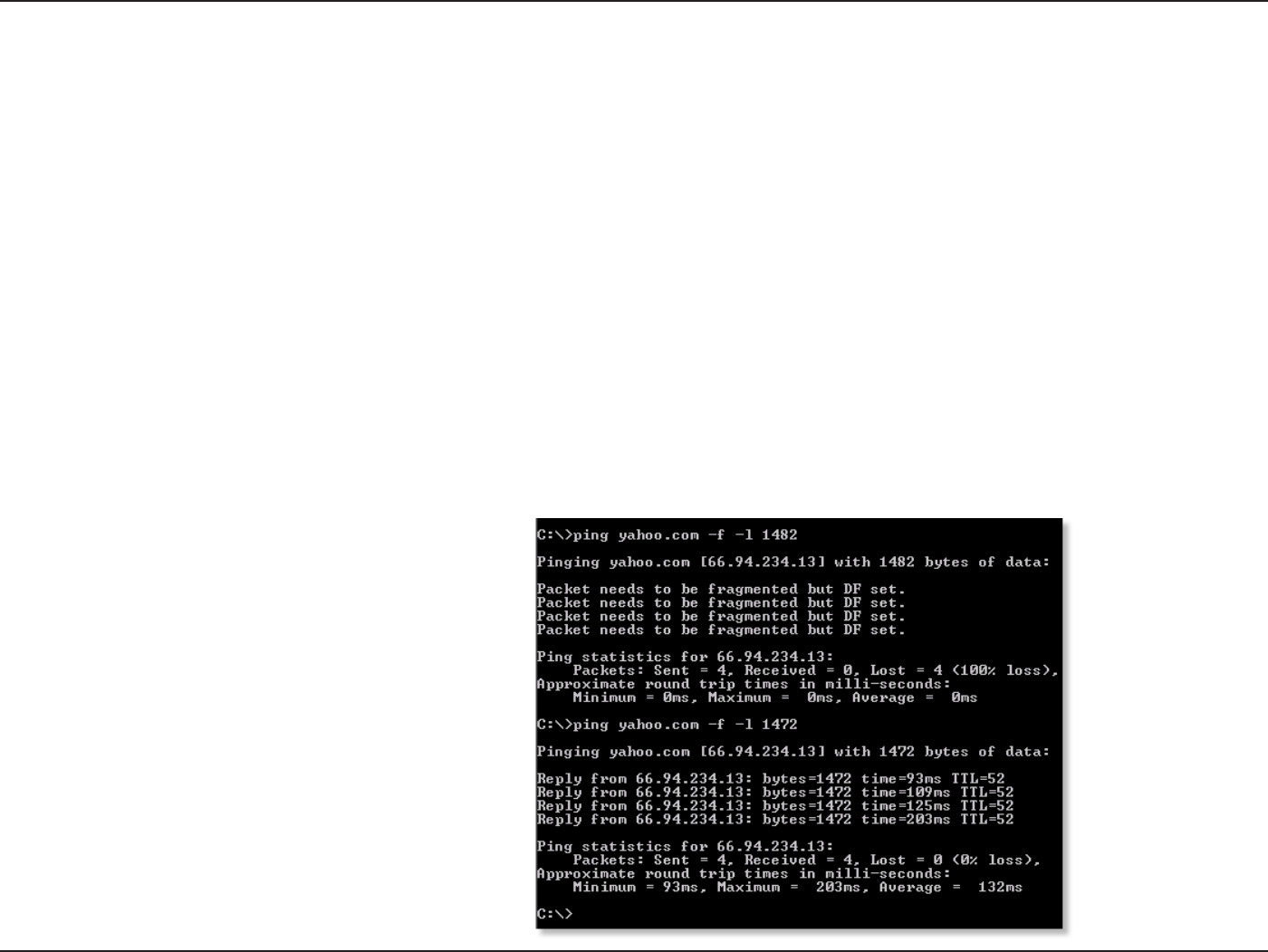
88
D-Link DIR-605 User Manual
Section 6 - Troubleshooting
3. Why can’t I connect to certain sites or send and receive e-mails when connecting through my router?
If you are having a problem sending or receiving e-mail, or connecting to secure sites such as eBay, banking sites,
and Hotmail, we suggest lowering the MTU in increments of ten (Ex. 1492, 1482, 1472, etc).
Note: AOL DSL+ users must use MTU of 1400.
To find the proper MTU Size, you’ll have to do a special ping of the destination you’re trying to go to. A destination
could be another computer, or a URL.
t$MJDLPOStart and then click Run.
t8JOEPXT® 95, 98, and Me users type in command (Windows® NT, 2000, and XP users type in cmd) and
press Enter (or click OK).
t0ODFUIFXJOEPXPQFOTZPVMMOFFEUPEPBTQFDJBMQJOH6TFUIFGPMMPXJOHTZOUBY
ping [url] [-f] [-l] [MTU value]
Example: ping yahoo.com -f -l 1472

89
D-Link DIR-605 User Manual
Section 6 - Troubleshooting
:PVTIPVMETUBSUBU BOEXPSLZPVSXBZEPXOCZFBDIUJNF0ODFZPVHFUBSFQMZ HPVQCZ VOUJMZPVHFUB
fragmented packet. Take that value and add 28 to the value to account for the various TCP/IP headers. For example,
lets say that 1452 was the proper value, the actual MTU size would be 1480, which is the optimum for the network
we’re working with (1452+28=1480).
Once you nd your MTU, you can now congure your router with the proper MTU size.
To change the MTU rate on your router follow the steps below:
t0QFOZPVSCSPXTFSFOUFSUIF*1BEESFTTPGZPVSSPVUFSBOEDMJDLOK.
t&OUFSZPVSVTFSOBNFBENJO BOEQBTTXPSECMBOLCZEFGBVMU $MJDL OK to enter the web conguration
page for the device.
t$MJDLPOSetup and then click Manual Congure.
t5PDIBOHFUIF.56FOUFSUIFOVNCFSJOUIF.56öFMEBOEDMJDLSave Settings to save your settings.
t5FTU ZPVSFNBJM*GDIBOHJOHUIF .56EPFTOPUSFTPMWFUIFQSPCMFNDPOUJOVFDIBOHJOHUIF.56JO
increments of ten.

90
D-Link DIR-605 User Manual
Appendix A - Wireless Basics
D-Link wireless products are based on industry standards to provide easy-to-use and compatible high-speed wireless
connectivity within your home, business or public access wireless networks. Strictly adhering to the IEEE standard,
the D-Link wireless family of products will allow you to securely access the data you want, when and where you want
JU:PVXJMMCFBCMFUPFOKPZUIFGSFFEPNUIBUXJSFMFTTOFUXPSLJOHEFMJWFST
A wireless local area network (WLAN) is a cellular computer network that transmits and receives data with radio signals
instead of wires. Wireless LANs are used increasingly in both home and office environments, and public areas such
as airports, coee shops and universities. Innovative ways to utilize WLAN technology are helping people to work and
communicate more eciently. Increased mobility and the absence of cabling and other xed infrastructure have proven
to be benecial for many users.
Wireless users can use the same applications they use on a wired network. Wireless adapter cards used on laptop
and desktop systems support the same protocols as Ethernet adapter cards.
Under many circumstances, it may be desirable for mobile network devices to link to a conventional Ethernet LAN in
order to use servers, printers or an Internet connection supplied through the wired LAN. A Wireless Router is a device
used to provide this link.
Wireless Basics

91
D-Link DIR-605 User Manual
Appendix A - Wireless Basics
What is Wireless?
Wireless or Wi-Fi technology is another way of connecting your computer to the network without using wires.
Wi-Fi uses radio frequency to connect wirelessly, so you have the freedom to connect computers anywhere
in your home or oce network.
Why D-Link Wireless?
D-Link is the worldwide leader and award winning designer, developer, and manufacturer of networking
products. D-Link delivers the performance you need at a price you can afford. D-Link has all the products
you need to build your network.
How does wireless work?
Wireless works similar to how cordless phone work, through radio signals to transmit data from one point
"UPQPJOU##VUXJSFMFTTUFDIOPMPHZIBT SFTUSJDUJPOTBTUPIPXZPVDBO BDDFTTUIFOFUXPSL:PVNVTUCF
within the wireless network range area to be able to connect your computer. There are two dierent types of
wireless networks Wireless Local Area Network (WLAN), and Wireless Personal Area Network (WPAN).
Wireless Local Area Network (WLAN)
In a wireless local area network, a device called an Access Point (AP) connects computers to the network.
The access point has a small antenna attached to it, which allows it to transmit data back and forth over radio
signals. With an indoor access point as seen in the picture, the signal can travel up to 300 feet. With an outdoor
access point the signal can reach out up to 30 miles to serve places like manufacturing plants, industrial
locations, college and high school campuses, airports, golf courses, and many other outdoor venues.

92
D-Link DIR-605 User Manual
Appendix A - Wireless Basics
Wireless Personal Area Network (WPAN)
Bluetooth is the industry standard wireless technology used for WPAN. Bluetooth devices in WPAN operate
in a range up to 30 feet away.
Compared to WLAN the speed and wireless operation range are both less than WLAN, but in return it
doesn’t use nearly as much power which makes it ideal for personal devices, such as mobile phones, PDAs,
headphones, laptops, speakers, and other devices that operate on batteries.
Who uses wireless?
Wireless technology as become so popular in recent years that almost everyone is using it, whether it’s for
home, oce, business, D-Link has a wireless solution for it.
Home
t (JWFTFWFSZPOFBUIPNFCSPBECBOEBDDFTT
t 4VSGUIFXFCDIFDLFNBJMJOTUBOUNFTTBHFBOEFUD
t (FUTSJEPGUIFDBCMFTBSPVOEUIFIPVTF
t 4JNQMFBOEFBTZUPVTF
Small Oce and Home Oce
t 4UBZPOUPQPGFWFSZUIJOHBUIPNFBTZPVXPVMEBUPóDF
t 3FNPUFMZBDDFTTZPVSPóDFOFUXPSLGSPNIPNF
t 4IBSF*OUFSOFUDPOOFDUJPOBOEQSJOUFSXJUINVMUJQMFDPNQVUFST
t /POFFEUPEFEJDBUFPóDFTQBDF

93
D-Link DIR-605 User Manual
Appendix A - Wireless Basics
Where is wireless used?
Wireless technology is expanding everywhere not just at home or oce. People like the freedom of mobility
and it’s becoming so popular that more and more public facilities now provide wireless access to attract people.
The wireless connection in public places is usually called “hotspots”.
Using a D-Link Cardbus Adapter with your laptop, you can access the hotspot to connect to Internet from
remote locations like: Airports, Hotels, Coee Shops, Libraries, Restaurants, and Convention Centers.
Wireless network is easy to setup, but if you’re installing it for the rst time it could be quite a task not knowing
where to start. That’s why we’ve put together a few setup steps and tips to help you through the process of
setting up a wireless network.
Tips
Here are a few things to keep in mind, when you install a wireless network.
Centralize your router or Access Point
Make sure you place the router/access point in a centralized location within your network for the best
performance. Try to place the router/access point as high as possible in the room, so the signal gets dispersed
throughout your home. If you have a two-story home, you may need a repeater to boost the signal to extend
the range.
Eliminate Interference
Place home appliances such as cordless telephones, microwaves, and televisions as far away as possible
from the router/access point. This would signicantly reduce any interference that the appliances might cause
since they operate on same frequency.

94
D-Link DIR-605 User Manual
Appendix A - Wireless Basics
Security
Don’t let you next-door neighbors or intruders connect to your wireless network. Secure your wireless network
by turning on the WPA or WEP security feature on the router. Refer to product manual for detail information
on how to set it up.
There are basically two modes of networking:
tInfrastructure – All wireless clients will connect to an access point or wireless router.
tAd-Hoc – Directly connecting to another computer, for peer-to-peer communication, using wireless network
adapters on each computer, such as two or more DIR-605 wireless network Cardbus adapters.
An Infrastructure network contains an Access Point or wireless router. All the wireless devices, or clients, will connect
to the wireless router or access point.
An Ad-Hoc network contains only clients, such as laptops with wireless cardbus adapters. All the adapters must be in
Ad-Hoc mode to communicate.
Wireless Modes
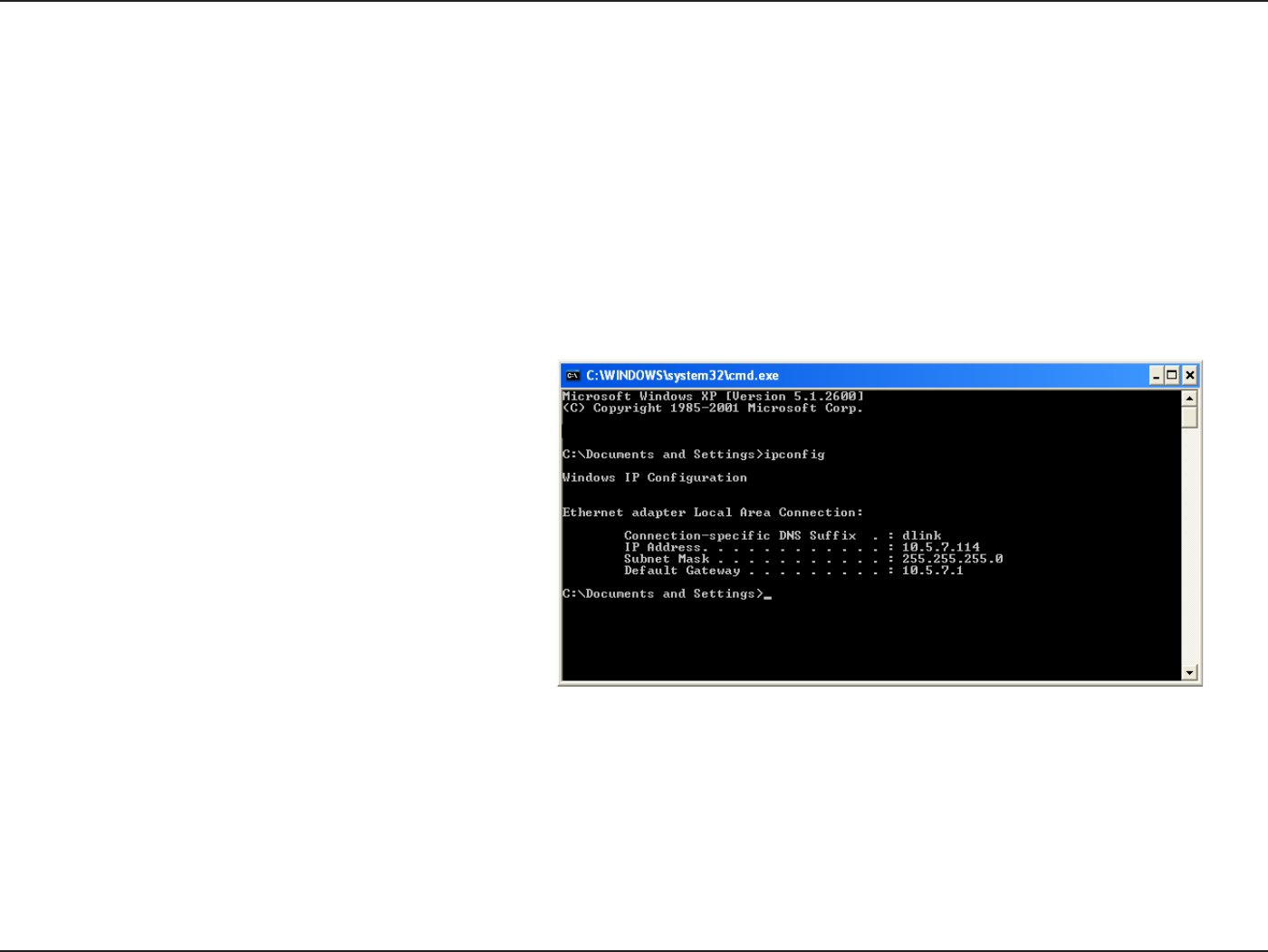
95
D-Link DIR-605 User Manual
Appendix B - Networking Basics
Networking Basics
Check your IP address
After you install your adapter, by default, the TCP/IP settings should be set to obtain an IP address from a DHCP server
(i.e. wireless router) automatically. To verify your IP address, please follow the steps below.
Click on Start > Run. In the run box type cmd and click OK. (Windows Vista® users type cmd in the Start Search
box.)
At the prompt, type ipcong and press Enter.
This will display the IP address, subnet mask, and
the default gateway of your adapter.
If the address is 0.0.0.0, check your adapter
installation, security settings, and the settings
on your router. Some firewall software programs
may block a DHCP request on newly installed
adapters.
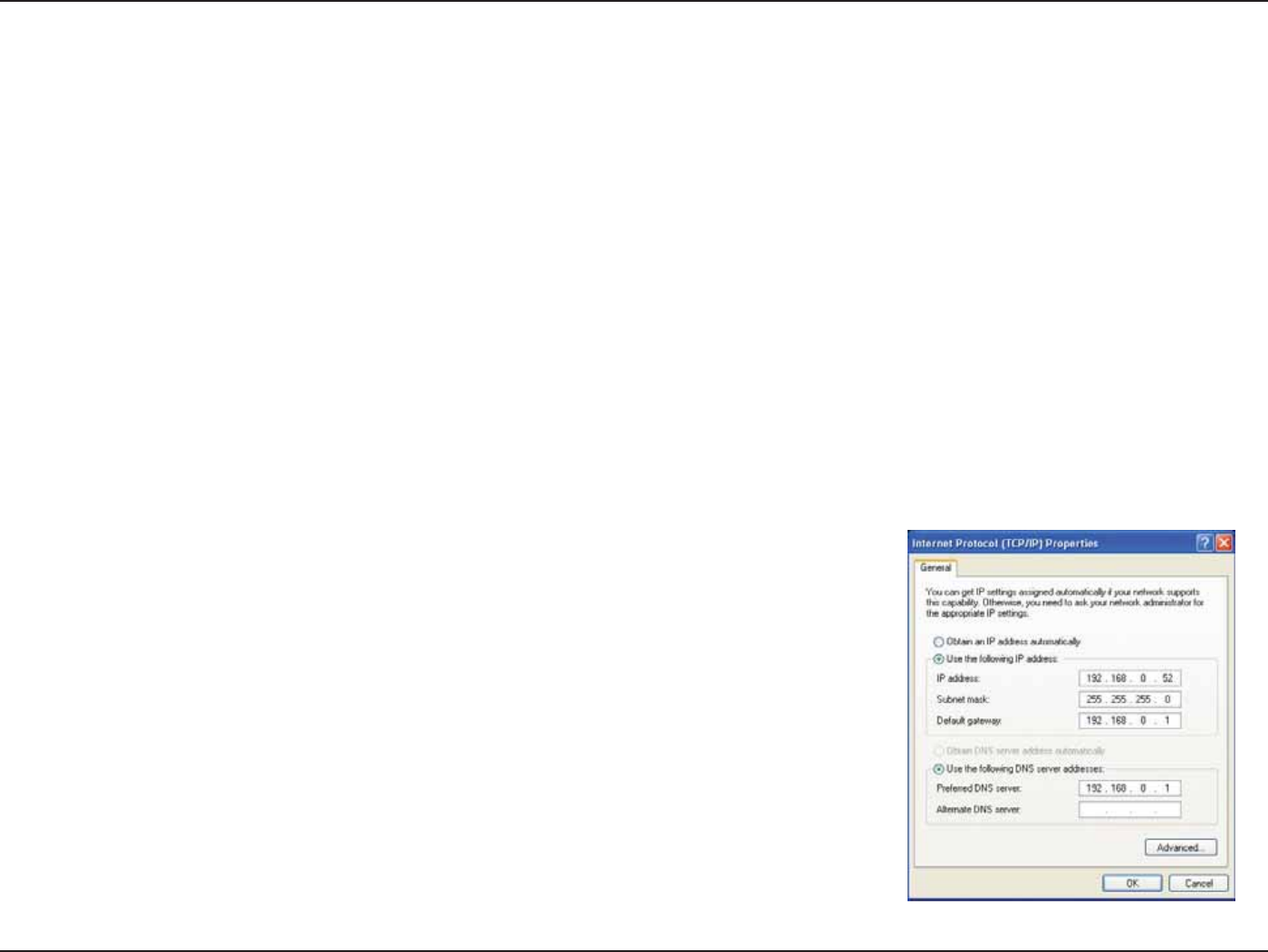
96
D-Link DIR-605 User Manual
Appendix B - Networking Basics
Statically Assign an IP address
If you are not using a DHCP capable gateway/router, or you need to assign a static IP address, please follow the steps
below:
Step 1
Windows Vista® - Click on Start > Control Panel > Network and Internet > Network and Sharing Center > Manage
Network Connections.
Windows® XP - Click on Start > Control Panel > Network Connections.
Windows® 2000 - From the desktop, right-click My Network Places > Properties.
Step 2
Right-click on the Local Area Connection which represents your network adapter and select Properties.
Step 3
Highlight Internet Protocol (TCP/IP) and click Properties.
Step 4
Click Use the following IP address and enter an IP address that is on the same
subnet as your network or the LAN IP address on your router.
Example: If the router´s LAN IP address is 192.168.0.1, make your IP address
192.168.0.X where X is a number between 2 and 99. Make sure that the number
you choose is not in use on the network. Set Default Gateway the same as the LAN
IP address of your router (192.168.0.1).
Set Primary DNS the same as the LAN IP address of your router (192.168.0.1). The
Secondary DNS is not needed or you may enter a DNS server from your ISP.
Step 5
Click OK twice to save your settings.

98
D-Link DIR-605 User Manual
Appendix D - Contacting Technical Support
Copyright ©2008 by D-Link Corporation/D-Link Systems, Inc. All rights reserved.
CE Mark Warning:
This is a Class B product. In a domestic environment, this product may cause radio interference, in which case the user may be required
to take adequate measures.
FCC Statement:
This equipment has been tested and found to comply with the limits for a Class B digital device, pursuant to Part 15 of the FCC Rules.
These limits are designed to provide reasonable protection against harmful interference in a residential installation. This equipment
generates, uses and can radiate radio frequency energy and, if not installed and used in accordance with the instructions, may cause
harmful interference to radio communications. However, there is no guarantee that interference will not occur in a particular installation.
If this equipment does cause harmful interference to radio or television reception, which can be determined by turning the equipment o
and on, the user is encouraged to try to correct the interference by one of the following measures:
t3FPSJFOUPSSFMPDBUFUIFSFDFJWJOHBOUFOOB
t*ODSFBTFUIFTFQBSBUJPOCFUXFFOUIFFRVJQNFOUBOESFDFJWFS
t$POOFDUUIFFRVJQNFOUJOUPBOPVUMFUPOBDJSDVJUEJòFSFOUGSPNUIBUUPXIJDIUIFSFDFJWFSJTDPOOFDUFE
t$POTVMUUIFEFBMFSPSBOFYQFSJFODFESBEJP57UFDIOJDJBOGPSIFMQ
For detailed warranty information applicable to products purchased outside the United States, please contact the corresponding local
D-Link oce.
FCC Caution:
Any changes or modications not expressly approved by the party responsible for compliance could void the user’s authority to operate
this equipment.
This device complies with Part 15 of the FCC Rules. Operation is subject to the following two conditions:
(1) This device may not cause harmful interference, and
(2) this device must accept any interference received, including interference that may cause undesired operation.
IMPORTANT NOTE:
FCC Radiation Exposure Statement:
This equipment complies with FCC radiation exposure limits set forth for an uncontrolled environment. This equipment should be installed
and operated with minimum distance 20cm between the radiator & your body.
This transmitter must not be co-located or operating in conjunction with any other antenna or transmitter.

注 意 !
依 據 低 功 率 電 波 輻 射 性 電 機 管 理 辦 法
第 十 二 條 經 型 式 認 證 合 格 之 低 功 率 射 頻 電 機 , 非 經 許 可 , 公 司 、 商 號 或 使 用 者 均 不 得
擅 自 變 更 頻 率 、 加 大 功 率 或 變 更 原 設 計 之 特 性 及 功 能 。
第 十 四 條 低 功 率 射 頻 電 機 之 使 用 不 得 影 響 飛 航 安 全 及 干 擾 合 法 通 信 ; 經 發 現 有 干 擾 現
象 時 , 應 立 即 停 用 , 並 改 善 至 無 干 擾 時 方 得 繼 續 使 用 。
前 項 合 法 通 信 , 指 依 電 信 規 定 作 業 之 無 線 電 信 。 低 功 率 射 頻 電 機 須 忍 受 合 法 通 信 或 工
業 、 科 學 及 醫 療 用 電 波 輻 射 性 電 機 設 備 之 干 擾 。
IC EMI(ICES-003)
"This Class B digital apparatus complies with Canadian ICES-003."
"Cet appareil numérique de la classe Class B est conforme à la norme NMB-003 du
Canada."
Operation is subject to the following two conditions:
1) this device may not cause interference, and
2) this device must accept any interference, including interference that may cause
undesired operation of the device.
IMPORTANT NOTE:
IC Radiation Exposure Statement:
This equipment complies with IC radiation exposure limits set forth for an
uncontrolled environment. This equipment should be installed and operated with
minimum distance 20cm between the radiator & your body.
This transmitter must not be co-located or operating in conjunction with any other
antenna or transmitter.